Introduction
In the rapidly evolving landscape of artificial intelligence, Large Language Models (LLMs) stand out as a pivotal innovation, transforming how businesses operate and interact with their customers. These sophisticated models, powered by advanced deep learning techniques, have become integral across various sectors, from enhancing customer service through intelligent chatbots to streamlining operations with data-driven insights.
As organizations increasingly recognize the potential of LLMs, they are also confronted with challenges such as data quality and integration complexities. This article delves into the transformative capabilities of LLMs, highlighting noteworthy models to watch in 2024 and exploring their diverse applications. By addressing the ethical considerations and limitations associated with LLMs, businesses can navigate this dynamic environment, unlocking new efficiencies and fostering innovation in their operations.
Understanding Large Language Models: A Primer
The new LLMs represent a groundbreaking evolution in artificial intelligence, engineered to process and generate text that closely mirrors human communication. At the heart of these models lies advanced deep learning techniques, especially neural networks, which empower them to grasp context, semantics, and syntax intricately. As of 2024, new LLMs are proving to be transformative across a spectrum of applications, including:
- Chatbots
- Virtual assistants
- Content creation
- Advanced information analysis
For instance, a recent report indicates that over 30% of business owners anticipate utilizing AI to generate website copy, showcasing a growing reliance on these technologies to enhance productivity and streamline operations. Additionally, it is projected that over 55% of deep neural networks will analyze information at the source by 2025, highlighting the future capabilities of new LLMs in real-time information processing. The landscape of AI talent is also shifting, as evidenced by a comprehensive analysis of AI talent concentration from 2016 to 2023, revealing a dynamic workforce increasingly focused on language processing innovations.
Furthermore, younger generations display a greater willingness to embrace AI technology in everyday tasks, contrasting with the fact that 68% of non-users are Gen X or Baby Boomers. This generational divide underscores the evolving attitudes towards the adoption of new LLMs. However, entities must tackle challenges such as poor master data quality, which can severely hinder the effectiveness of AI implementations, and the perceived complexity and cost associated with AI integration.
By leveraging tailored AI solutions, including Robotic Process Automation (RPA) and Business Intelligence, organizations can automate manual workflows, enhance operational efficiency, and drive data-driven insights for strategic management. Addressing these concerns can help mitigate the perception that AI projects are time-intensive and costly. As entities harness these capabilities, new LLMs emerge as indispensable tools for navigating today’s data-driven landscape, ultimately reshaping how businesses operate and engage with their audiences.
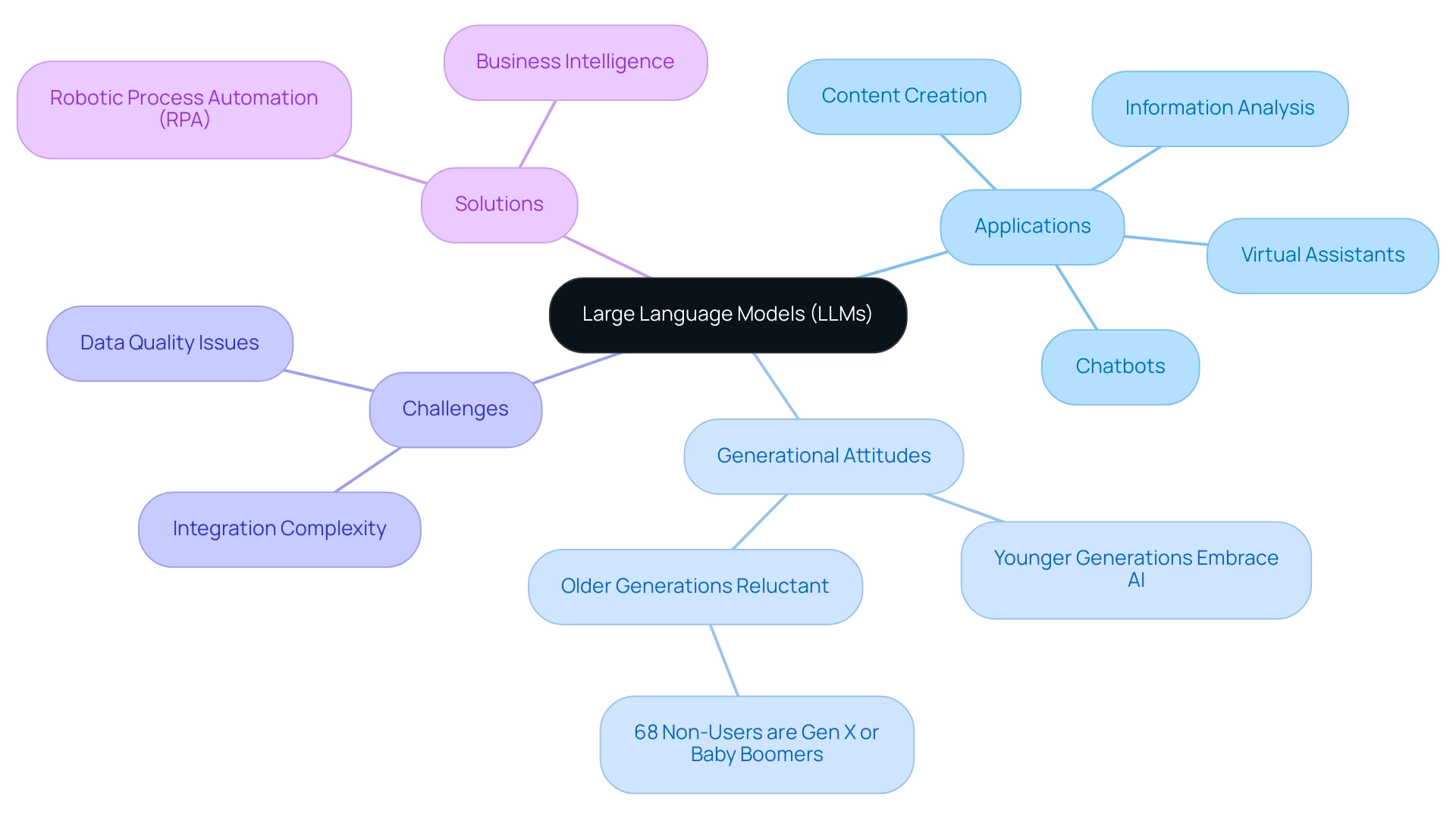
The Top 10 LLMs to Watch in 2024: Innovations and Features
-
Llama 3: Meta’s latest iteration introduces enhanced reasoning capabilities, supported by a more extensive training dataset. This advancement positions new llms as a formidable option for tackling complex tasks, allowing organizations to leverage their strengths for improved decision-making and data quality management, directly addressing the challenges of poor master data quality. With LaMDA systems ranging from 2 billion to 137 billion parameters, it demonstrates the scalability of such systems in addressing diverse operational needs.
-
Chat GPT 5: OpenAI’s newest version significantly enhances conversational abilities, emphasizing contextual understanding and user intent. This makes it particularly well-suited for customer service applications, ensuring more satisfying interactions and streamlined operations. Its ability to improve customer engagement through intelligent outputs demonstrates the potential of tailored AI solutions in transforming business operations, while also simplifying perceived AI complexities.
-
Claude 3: Anthropic’s system prioritizes ethical AI use, integrating advanced safety features that mitigate harmful outputs while maintaining high performance. This focus not only enhances user trust but also aligns with emerging regulatory standards in AI deployment, overcoming potential implementation challenges related to perceived complexities.
-
Mistral 7B: Renowned for its efficiency, this version delivers competitive performance within a smaller architecture, making it ideal for resource-constrained environments. Companies can utilize Mistral 7B and new llms to maximize output without compromising on computational resources, thereby enhancing productivity through effective AI application while also addressing information quality issues.
-
Google’s Palm 2: Excelling in multilingual capabilities, this system facilitates seamless communication across diverse languages. The application of new llms is crucial for enterprises operating in global markets, as they allow for effective cross-cultural engagement and informed decision-making, which are essential in overcoming data quality barriers.
-
Bard 2: Google’s conversational AI continues to evolve, focusing on creative content generation and interactive storytelling. This framework enables brands to improve their marketing initiatives through captivating stories and tailored customer interactions, highlighting the transformative potential of new llms in commerce while addressing user concerns about AI complexities.
-
Cohere’s Command R: Tailored for enterprise applications, this model offers robust customization options that address specific business needs. Its adaptability allows organizations to implement AI solutions closely aligned with their operational objectives, enhancing overall efficiency and addressing quality challenges.
-
Jasper AI: Known for its content generation capabilities, Jasper AI has recently integrated advanced editing features, providing users with enhanced control over their outputs. This innovation assists marketing teams in creating high-quality content effectively, further demonstrating the advantages of new llms in operational settings and contributing to enhanced information management.
-
OpenAI’s Codex: A specialized system for programming tasks, Codex simplifies code generation and debugging. By supporting developers effectively, it accelerates project timelines and fosters innovation in software development, directly contributing to improved operational efficiency while addressing complexities in implementation.
-
EleutherAI’s GPT-NeoX: As an open-source alternative, GPT-NeoX encourages community contributions and innovations. This framework acts as a significant asset for researchers and developers, encouraging joint progress in AI technologies and assisting entities in remaining competitive in a swiftly changing environment, especially regarding information quality and ethical aspects.
-
Gopher – Deepmind: Deepmind’s language system ‘Gopher’, with its 280 billion parameters, excels in numerous tasks, particularly in answering specialized questions in fields like humanities and science. Its performance is comparable to OpenAI’s GPT-3.5, allowing researchers to trace the training text used for its outputs, aiding in bias detection and ensuring ethical AI practices. This clarity is essential for entities aiming to tackle obstacles in information quality and the implementation of new llms in ethical AI.
The visual analogy of a human figure perched on a large question mark, pondering alongside a robot grasping a light bulb, represents the partnership between human curiosity and AI solutions, highlighting how these advanced systems can assist businesses in managing complexities and improving information quality.

Spotlight on Notable Models: Llama 3, ChatGPT 5, and More
-
Llama 3: Renowned for its sophisticated reasoning abilities, Llama 3 excels in domains requiring nuanced understanding, particularly in healthcare and legal applications. Its versatility makes it an ideal choice for various use cases, including chatbots for client interactions and advanced document analysis for legal cases. This adaptability empowers organizations to leverage AI and new llms for enhanced decision-making and operational efficiency, much like how GUI automation has transformed healthcare service delivery by streamlining data entry and system integration, reducing data entry errors by 70% and improving workflow efficiency by 80%.
-
ChatGPT 5: This model has revolutionized customer service dynamics by delivering precise and context-aware responses, significantly improving user experiences. Its ability to manage multi-turn conversations with new llms allows organizations to cultivate deeper, more meaningful interactions with customers, which parallels the operational efficiency gained through RPA. The result is heightened user satisfaction, as evidenced by recent statistics showing significant improvements in customer engagement metrics. Notably, ChatGPT has achieved more than 60% accuracy on the USMLE, demonstrating its capabilities in medical applications. Furthermore, a study published in May 2024 found that ChatGPT-3.5 scored 86.6% in diagnosing common urological conditions, significantly outperforming Google Search, which achieved only 53.3% accuracy.
-
Claude 3: With a strong emphasis on ethical AI deployment, Claude 3 is designed to minimize biases and harmful outputs. This makes it an ideal solution for organizations prioritizing responsible AI practices. By ensuring ethical considerations are at the forefront, Claude 3 and new llms enable organizations to build trust with users while effectively leveraging AI technologies, similar to how GUI automation enhances software quality in healthcare, addressing challenges such as slow software testing and integration issues with legacy systems.
-
Mistral 7B: Known for its processing efficiency, Mistral 7B is a preferred choice among startups aiming to implement AI solutions without extensive infrastructure. Its remarkable performance under resource constraints allows emerging businesses to harness the power of new llms effectively, streamlining operations and enhancing service delivery, similar to the improvements seen in entities adopting RPA to automate manual workflows, thus achieving ROI within six months.
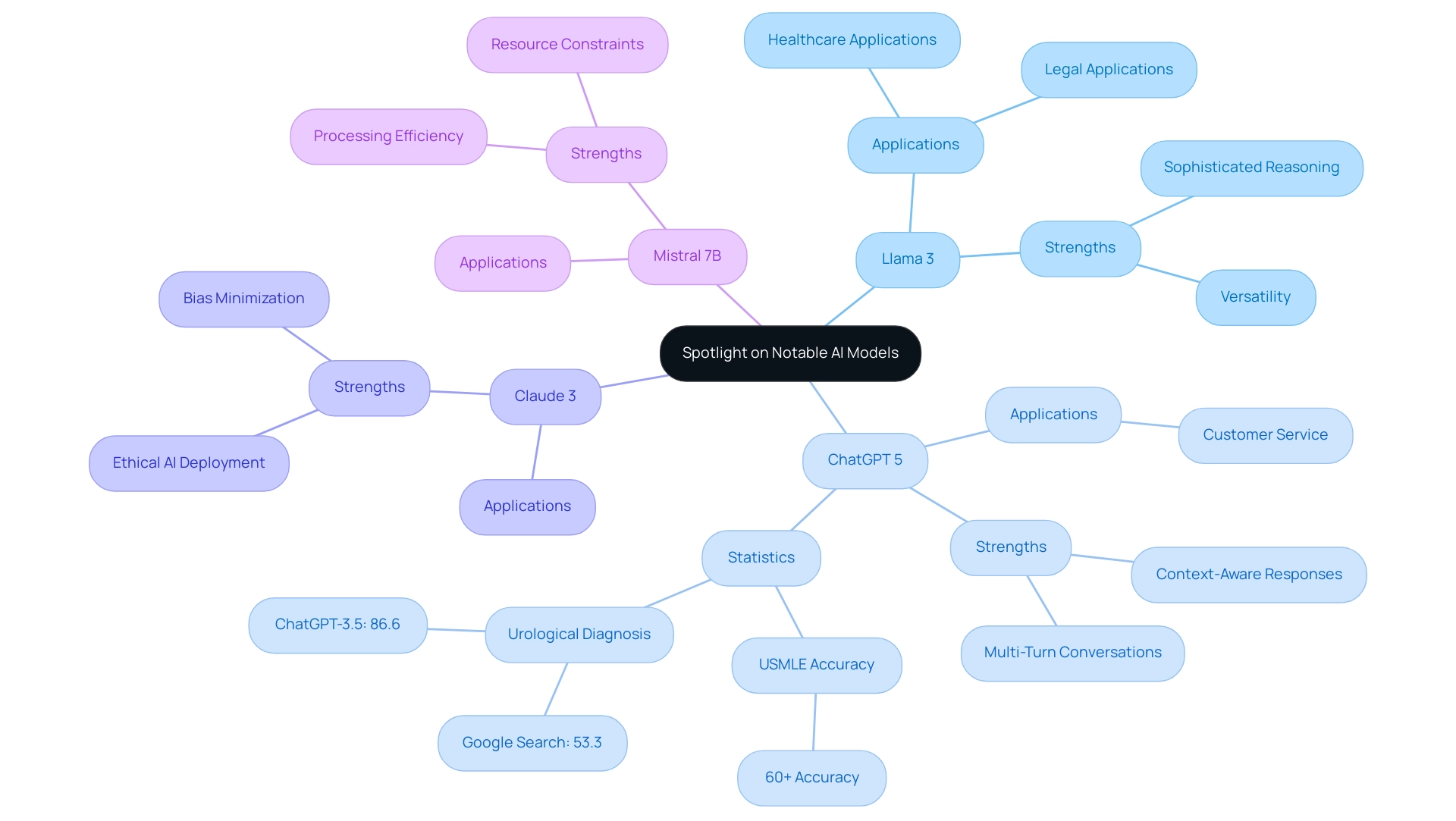
Applications of LLMs: Transforming Industries and Workflows
Large language systems (LLSs) are transforming industries by automating routine tasks and improving decision-making processes across various sectors. By leveraging Robotic Process Automation (RPA), companies can streamline manual workflows, reduce errors, and free up team resources, significantly enhancing operational efficiency in a rapidly evolving AI landscape. In marketing, these frameworks create personalized content at scale, significantly enhancing engagement and conversion rates.
A recent poll revealed that:
- 50% of senior marketing and sales leaders are integrating AI into their strategies.
- 45% are utilizing AI specifically to gather consumer insights.
- Only 23% of respondents intended to implement commercial models or had already done so, emphasizing the cautious approach many entities take towards the adoption of new LLMs.
This strategic application of new LLMs, when combined with tailored AI solutions, leads to marketing campaigns that resonate more deeply with consumers, thereby enhancing customer engagement.
For example, businesses in advertising and marketing leverage new LLMs for:
- Content creation
- Personalization
- Sentiment analysis
This results in higher conversion rates and improved customer engagement through tailored marketing strategies. In customer service, LLM-powered chatbots, enhanced by RPA, provide instant, accurate responses, effectively reducing wait times and increasing overall customer satisfaction. This efficiency is evident in entities that have adopted RPA alongside new LLMs, which report enhanced customer interactions.
Similarly, in finance, new LLMs are used to analyze vast datasets to identify trends and forecast market movements, empowering investment strategies. The transformative potential of new LLMs extends to healthcare, where these new LLMs streamline patient documentation and support clinical decision-making by synthesizing extensive medical literature. Additionally, the recent launch of the Customer Experience Specialist (CXS) certification in Spanish underscores the industry’s commitment to enhancing customer experience through AI advancements.
However, companies often face challenges in identifying the right AI solutions amidst the rapidly evolving landscape. As they embrace new LLMs, RPA, and Business Intelligence, they unlock new efficiencies and drive innovation, fundamentally reshaping their operations for the better. Business Intelligence plays a crucial role in transforming raw information into actionable insights, enabling informed decision-making that drives growth and innovation.
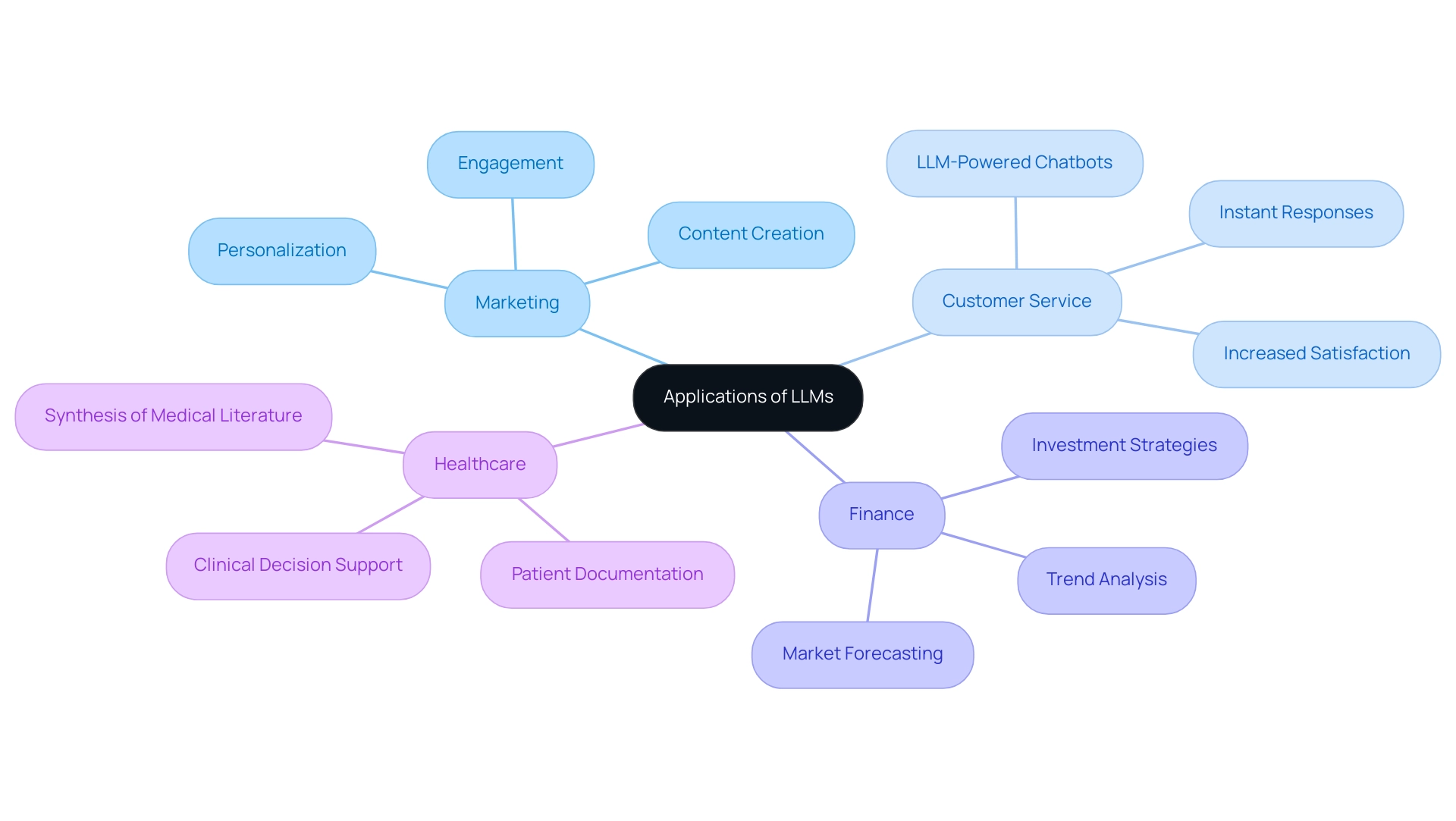
Navigating Challenges: Ethical Considerations and Limitations of LLMs
While new llms offer remarkable advantages for operational efficiency, they also introduce significant ethical challenges that organizations must address. Bias in training sets can lead to discriminatory outputs, as illustrated by a study from the US Department of Commerce revealing that facial recognition AI frequently misidentifies people of color, causing severe repercussions like wrongful arrests. This highlights the urgent need for robust oversight, continuous model evaluation, and tailored AI solutions that mitigate these biases, particularly concerning new llms.
Organizations like IBM Consulting emphasize the importance of a modern data architecture to prepare for secure AI deployment and effective bias evaluation. Furthermore, the positive impact of AI is evident in case studies, such as a cement manufacturer that enhanced plant efficiency by 1% through AI, reducing carbon emissions by approximately 70,000 tons annually. By leveraging Robotic Process Automation (RPA) to automate manual workflows, organizations can significantly boost productivity and streamline operations, overcoming technology implementation challenges such as resistance to change and integration complexities.
RPA not only reduces errors but also frees up teams to focus on more strategic, value-adding tasks, enhancing overall operational efficiency. To combat misinformation generated by new llms, entities should implement strong bias detection protocols and ensure transparency in AI decision-making processes—essential strategies for fostering accountability and enhancing Business Intelligence. Recognizing the limitations of new LLMs, such as their inability to grasp context beyond their training data, allows organizations to set realistic expectations while responsibly harnessing AI’s power to drive informed decision-making and business growth.
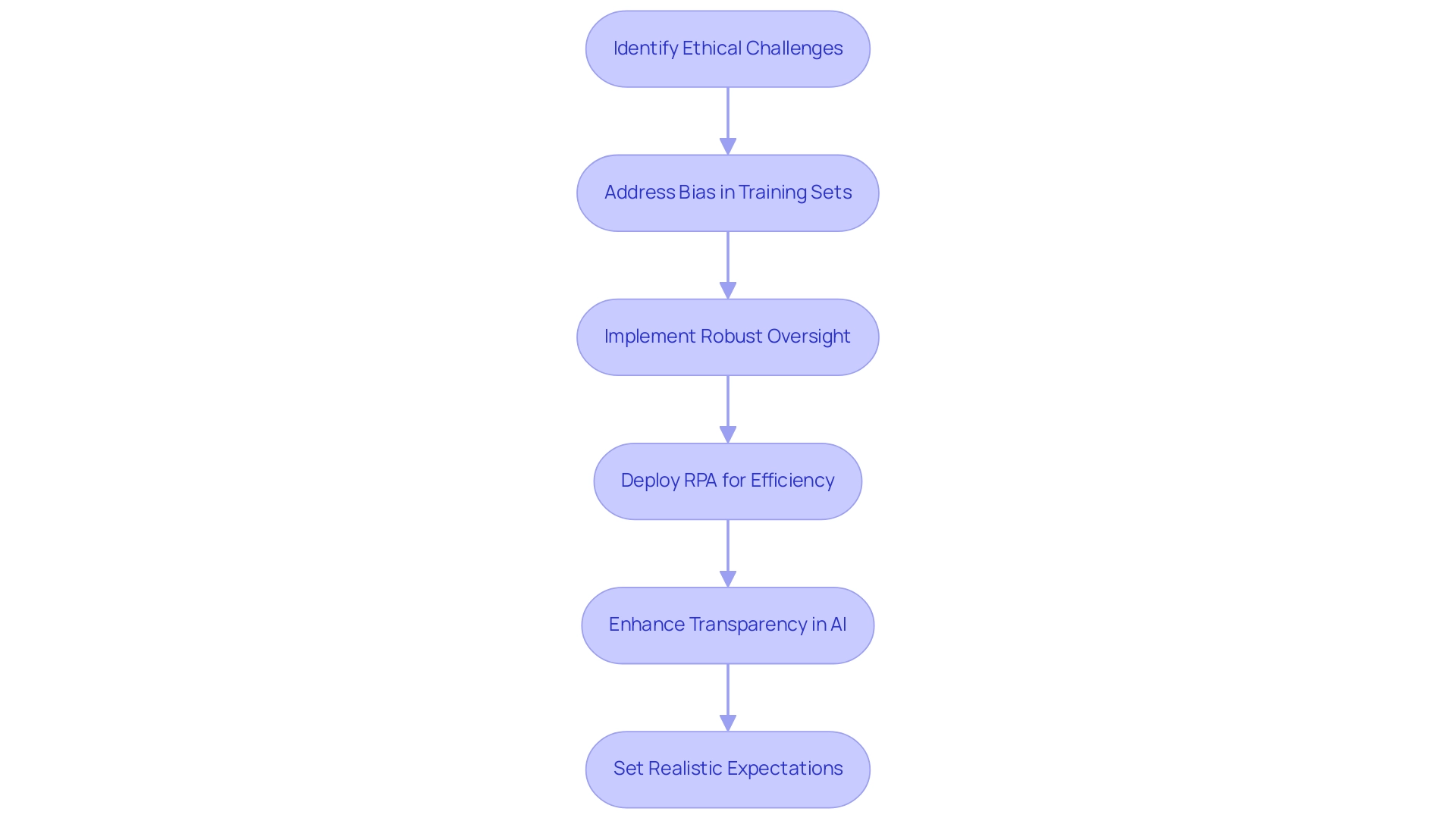
Conclusion
Large Language Models (LLMs) are transforming the operational landscape across various sectors, showcasing their ability to enhance efficiency, improve customer interactions, and drive data-driven insights. As highlighted throughout this article, models such as Llama 3 and ChatGPT 5 are at the forefront of this innovation, offering advanced capabilities that address complex challenges faced by organizations today. These models not only improve decision-making but also streamline processes, ultimately reshaping how businesses engage with customers and leverage data.
However, the journey towards integrating LLMs is not without its hurdles. Organizations must navigate issues related to data quality and ethical considerations to fully harness the potential of these technologies. By adopting tailored AI solutions and implementing robust oversight mechanisms, businesses can mitigate biases and ensure that their AI implementations are both effective and responsible. This proactive approach fosters trust and enhances operational success.
As the landscape of artificial intelligence continues to evolve, embracing LLMs presents a significant opportunity for organizations to unlock new efficiencies and foster innovation. By recognizing the transformative power of these models and addressing the associated challenges, businesses can position themselves as leaders in their industries, ready to thrive in a data-driven future. The time to act is now; leveraging LLMs strategically will not only enhance operational efficiency but also pave the way for sustainable growth and improved customer experiences.
Introduction
In the rapidly evolving landscape of modern business, organizations are increasingly turning to Robotic Process Automation (RPA) as a transformative solution to enhance operational efficiency and drive productivity. By automating repetitive and rule-based tasks, RPA not only alleviates the burden on employees but also significantly reduces errors and accelerates processes.
This article delves into the multifaceted benefits of RPA, showcasing real-world success stories that highlight its impact across various sectors. From overcoming common challenges in implementation to measuring success through key performance indicators, organizations are equipped with practical strategies to harness the full potential of RPA.
As the integration of AI and machine learning continues to shape the future of automation, understanding these trends will be crucial for businesses aiming to remain competitive and innovative in an increasingly automated world.
Understanding Robotic Process Automation (RPA)
It rpa, or Robotic Process Automation, is revolutionizing the way organizations operate by employing software robots, or ‘bots,’ to automate repetitive and rule-based tasks traditionally handled by humans, including data entry, transaction processing, and record management. A recent case study demonstrates how a mid-sized healthcare firm addressed issues like manual data entry mistakes and sluggish software testing through the adoption of GUI technology. By incorporating it rpa into their operations, this company achieved:
- A 70% reduction in data entry mistakes
- A 50% acceleration in testing activities
- An 80% enhancement in workflow efficiency
All while realizing a return on investment within six months.
This ROI reflects not only immediate cost savings but also long-term operational improvements, as the company was able to reallocate resources to more strategic initiatives. The GUI automation solution specifically facilitated the monitoring of systems and the seamless integration of legacy systems, addressing critical pain points in their operations. These outcomes highlight RPA’s capability to simplify workflows, improve operational efficiency, and decrease errors linked to manual tasks, enabling employees to concentrate on more strategic initiatives.
The importance of it rpa in modern business operations lies in its ability to enhance efficiency, improve accuracy, and boost overall productivity across various sectors, including finance, healthcare, and manufacturing. For instance, a leading bank that implemented RPA to automate its loan processing saw a remarkable 30% reduction in processing time, enhancing operational efficiency and customer satisfaction. Moreover, 89% of employees report greater job satisfaction due to automation, showing that it rpa has a positive influence on morale and productivity.
A 2022 survey by Robocorp revealed that 65% of respondents believe they would benefit from usage-based pricing for RPA solutions, indicating a growing trend in the market. As mentioned by Technavio, enhanced cost savings are fueling market expansion, with a trend toward emerging innovations in business transformation. Furthermore, Blue Prism’s recent partnership with Microsoft aims to deliver cloud-based solutions for it rpa, particularly targeting the reduction of operational costs in banking, showcasing ongoing advancements in RPA technology.
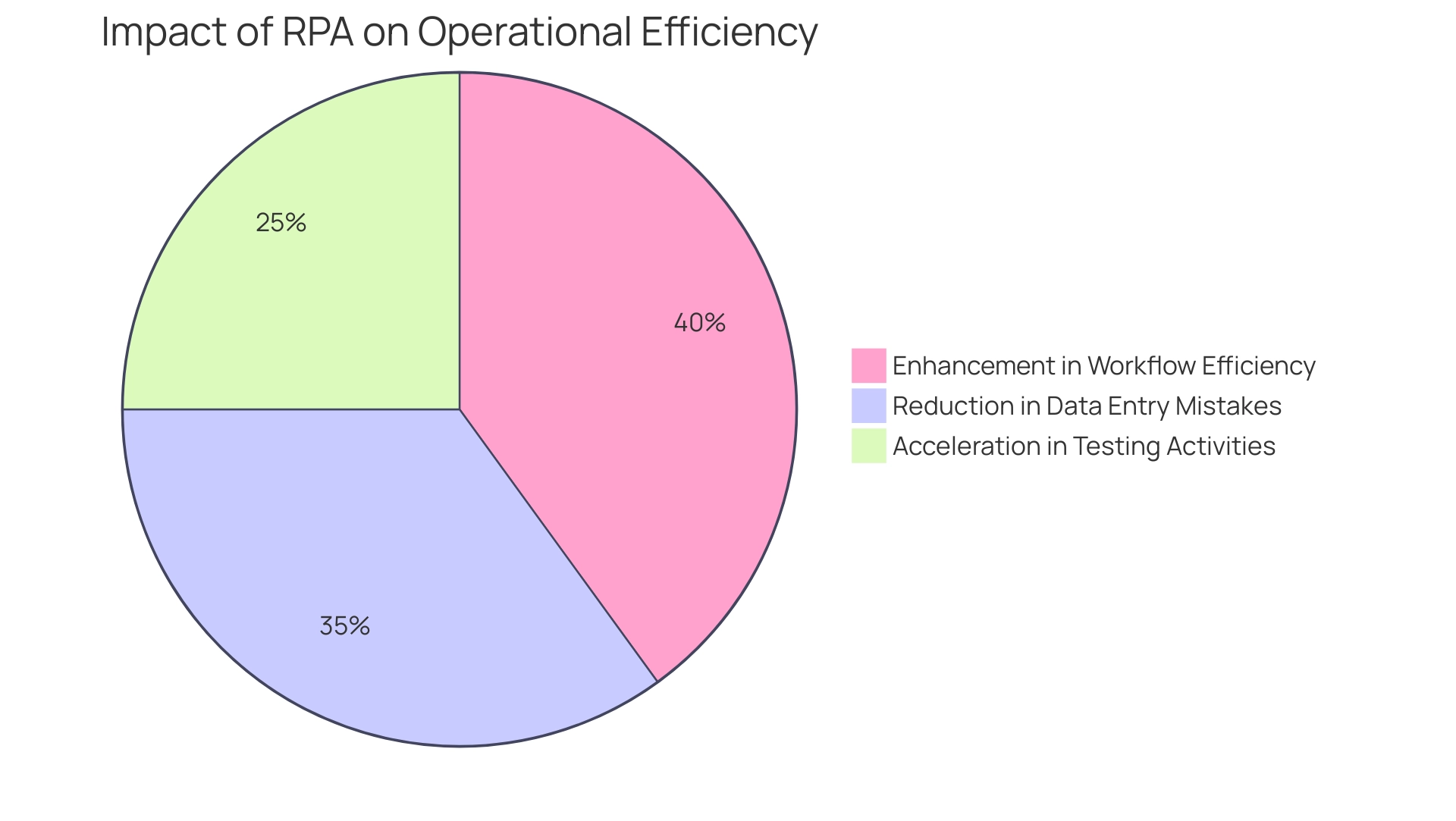
Best Practices for Successful RPA Implementation
Successful implementation of IT RPA demands meticulous planning and execution. Here are key best practices to consider, specifically designed to address common workplace challenges and enhance productivity:
-
Identify the Right Procedures: Begin by pinpointing tasks that are repetitive, rule-based, and high-volume.
Such tasks are prime candidates for RPA. Perform a comprehensive evaluation to guarantee these methods will produce significant efficiency improvements, preparing for meaningful mechanization and easing the workload on your team. -
Engage Stakeholders Early: Involving key stakeholders from the outset is crucial.
This includes IT teams, business units, and management. Early engagement fosters buy-in, mitigates concerns, and aligns objectives across the organization, which is vital for a successful IT RPA initiative aimed at optimizing operations. -
Pilot Before Full Deployment: Launch RPA through a pilot program before a full-scale rollout.
This strategic approach allows for testing the technology in a controlled environment, facilitating the identification of potential issues and providing a clearer assessment of ROI. Successful pilot programs have demonstrated impressive success rates, paving the way for broader implementation and addressing operational inefficiencies. -
Establish a Governance Framework: A well-defined governance structure is essential.
This framework should detail roles, responsibilities, and procedures for managing RPA initiatives, ensuring that technological solutions align with organizational goals and comply with relevant regulations. Effective governance enhances accountability and sustainability of IT RPA efforts, which further supports talent retention by allowing your team to focus on more strategic tasks. -
Monitor and Optimize: Post-deployment, it’s imperative to continuously monitor the performance of RPA solutions.
Employ analytics to uncover areas for improvement and optimize processes for enhanced efficiency. Regular reviews are essential to ensure that RPA solutions stay effective and relevant as business needs evolve, particularly in a rapidly changing AI landscape. -
Address Staffing Shortages: By implementing IT RPA, organizations can significantly alleviate the challenges posed by staffing shortages through the automation of routine tasks, allowing the existing workforce to concentrate on higher-value activities.
This not only enhances productivity but also improves employee satisfaction and retention by reducing burnout from repetitive work.
The financial implications of RPA are significant; for instance, automation is expected to save £17 billion off public sector payments by 2030 compared to 2015. Furthermore, the global RPA software market has experienced substantial growth, increasing from $2.6 billion in 2022 to $3.2 billion in 2023, reflecting a growth rate of 22.1%. This trend underscores the increasing relevance and investment in IT RPA technologies.
Additionally, notable companies in the RPA space have secured significant funding, such as UiPath raising $1.2 billion and Automation Anywhere $840 million, indicating the growing importance of RPA across various industries.
By adhering to these best practices, entities can adeptly navigate the complexities of IT RPA implementation. The potential of IT RPA to enhance operational efficiency is immense, and with careful execution, your entity can thrive in this landscape. As Yana Pokora, Content Manager at Flobotics, insightfully states,
If you’re unsure where to start, we’ve got you covered—reach out to our RPA consultants and get a free consultation now!
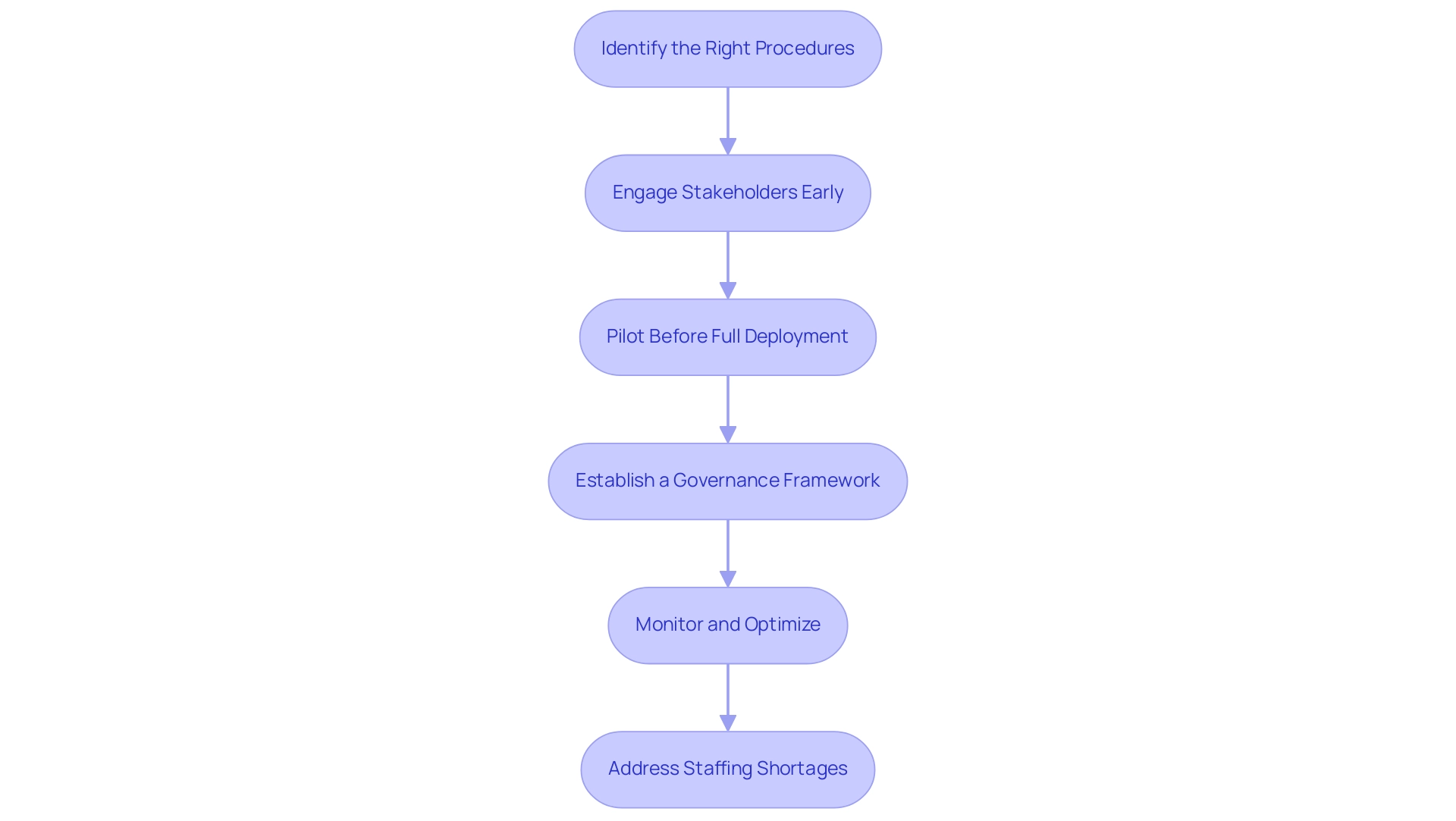
Overcoming Common Challenges in RPA Adoption
Implementing it rpa presents various challenges that organizations must navigate effectively. Here are key obstacles and proven strategies to address them:
-
Resistance to Change: One of the primary hurdles is the fear among employees regarding job displacement and skepticism towards new technologies. To combat this, it is crucial to communicate the advantages of it rpa clearly, emphasizing that it rpa aims to reduce repetitive tasks, thus enabling employees to concentrate on more strategic initiatives. Notably, it rpa can manage up to 90% of data entry tasks in clinical research, showcasing its potential to enhance efficiency. Fostering a culture of collaboration where employees actively participate in the it rpa journey can significantly enhance acceptance and enthusiasm for the change.
-
Skill Gaps: The transition to RPA may reveal deficiencies in the necessary skills within the existing workforce. To bridge these gaps, companies should invest in targeted training programs designed to equip employees with the expertise needed to collaborate effectively with it rpa. Engaging external experts or consultants during the initial implementation phases can also provide valuable insights and facilitate a smoother transition. As Cem Dilmegani, Principal Analyst at AIMultiple, notes, “Understanding the technological landscape is essential for organizations to effectively implement it rpa and maximize the benefits it offers.”
-
Successful it rpa deployment hinges on the seamless integration of new solutions with pre-existing IT infrastructure. A comprehensive evaluation of current systems before implementation is essential to ensure compatibility. It is vital to select RPA tools that offer flexible integration capabilities to ensure it rpa minimizes disruptions and maintains operational continuity.
In this context, GUI mechanization offers a risk-free, ROI-driven approach that can alleviate these challenges by streamlining operations. Our service promise guarantees that clients only pay if the system is delivered as planned. Together, we will evaluate your processes, calculate the efforts required for systematization, estimate the time savings after the project, and execute the systematization with certified professionals.
For instance, a mid-sized company that adopted GUI automation reported a 70% reduction in data entry errors and an ROI achieved within six months. By proactively tackling these challenges with targeted strategies, entities can significantly enhance their chances of achieving a successful it rpa implementation. Recent studies have shown that 75% of entities that adopted it rpa have met or exceeded their cost-saving expectations, with 61% of participants in a study reporting similar results.
This underscores the potential benefits of overcoming these obstacles.

Measuring the Success of RPA Initiatives
To effectively measure the success of RPA initiatives, it is important for entities to establish key performance indicators (KPIs) that align with the specific goals of their mechanization efforts. Here are several critical metrics to consider:
-
Cost Savings: Evaluate the reduction in operational expenses stemming from RPA implementation.
This includes savings from decreased labor costs and enhanced process efficiency, with real-world examples indicating that some institutions, such as an Icelandic healthcare organization, have cut their annual costs by over $75,000. -
Process Time Reduction: Measure the time needed to finish tasks before and after mechanization.
A significant reduction in processing time acts as a strong sign of effective RPA implementation, demonstrating how mechanization can transform workflows in a swiftly changing AI environment. -
Error Rate: Evaluate the precision of operations by comparing error rates before and after RPA.
A reduction in errors not only underscores the effectiveness of automation but also improves compliance and quality, as automated systems are significantly less prone to human mistakes. This improvement in accuracy directly contributes to better adherence to regulations and internal standards, reinforcing the role of RPA in enhancing operational efficiency. -
Employee Satisfaction: Utilize surveys to evaluate employee attitudes towards RPA.
An increase in job satisfaction and engagement signals that RPA is allowing staff to focus on more meaningful, value-added tasks rather than repetitive data entry. As noted by ClaySys Technologies, RPA can handle up to 90% of data entry tasks in clinical research, allowing employees to engage in more impactful work and enhancing overall productivity. -
Business Intelligence Integration: Leverage Business Intelligence to analyze the data generated from RPA initiatives.
This can offer practical insights that guide decision-making, assisting entities in improving their methods and strategies based on real-time data. -
Continuous Monitoring: Regularly tracking these KPIs is essential for companies to refine their RPA initiatives and ensure they contribute to overarching business goals.
This ongoing assessment is crucial for driving innovation and maintaining a competitive edge in today’s marketplace. By utilizing automated systems and customized AI solutions, companies can not only improve operational efficiency but also position themselves strategically against rivals.
By incorporating these elements into their assessment processes, firms can ensure that RPA initiatives are not only effective but also aligned with their long-term strategic goals, particularly in minimizing manual, repetitive tasks and harnessing the power of Business Intelligence for informed decision-making.
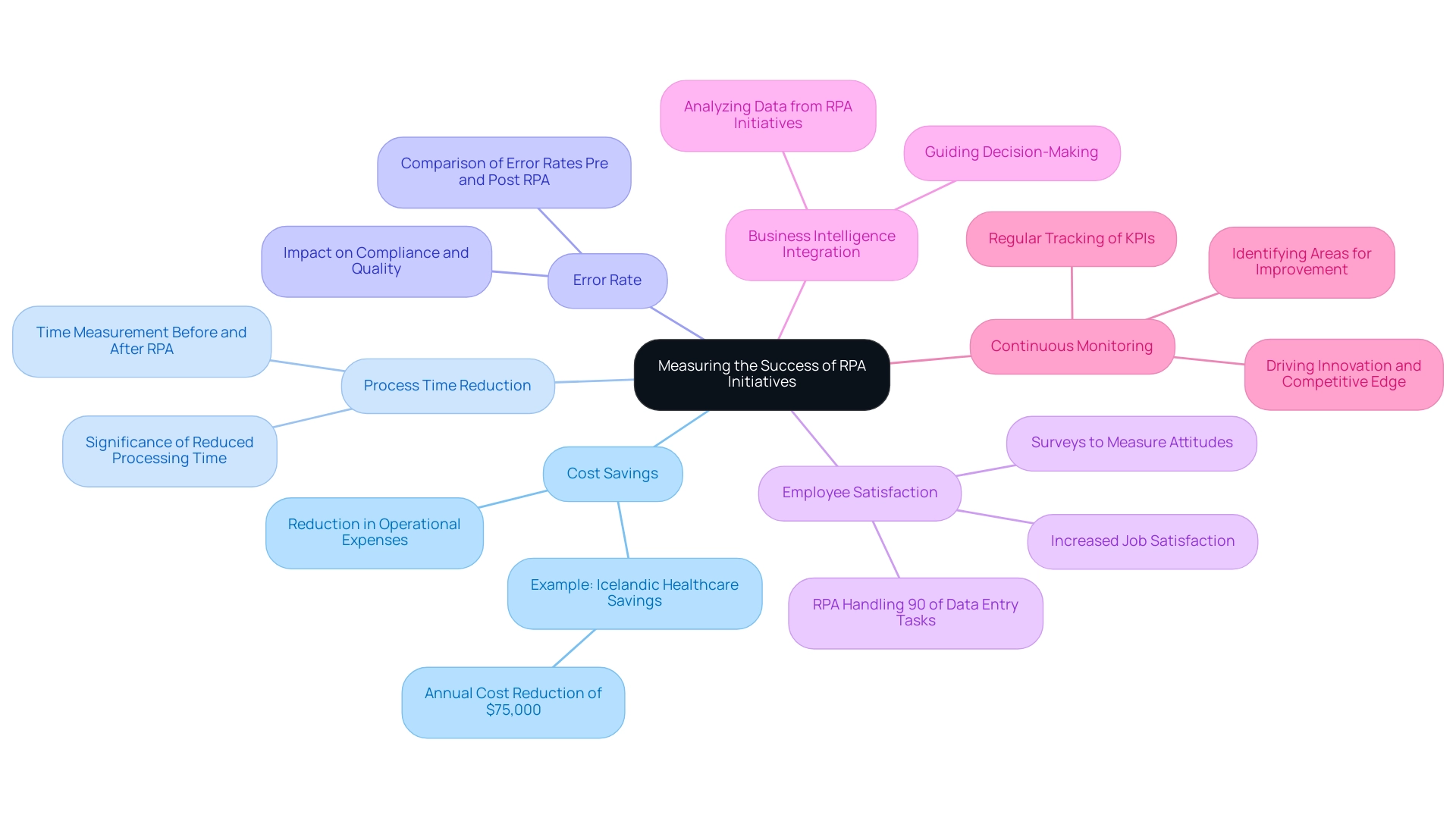
Future Trends in RPA and AI Integration
As Robotic Process Automation (RPA) technology progresses, several notable trends are emerging that organizations should proactively consider:
- AI and Machine Learning Integration: The convergence of AI and machine learning with RPA is set to significantly improve operational capabilities. This integration enables bots to analyze data and adjust their operations, leading to smart processes that develop over time.
Such advancements not only streamline processes but also foster greater efficiency and effectiveness. For instance, as noted by Social, an AI chatbot can answer a student’s question in just 2.7 seconds, exemplifying the efficiency gains that AI brings to RPA.
- Attended vs. Unattended Automation: A hybrid method that merges attended and unattended processes is gaining traction among companies.
This strategy permits adaptability, facilitating human participation when needed while also utilizing unattended processes for routine tasks. The growing adoption of this model is reflected in the statistic that RPA has an adoption rate of 39%, indicating a balanced approach that caters to diverse operational needs.
- Concentrate on Workflow Analysis: More and more, entities are adopting workflow analysis tools to examine current procedures before implementing automated solutions.
By identifying inefficiencies and bottlenecks, businesses can optimize processes for mechanization, ensuring a smoother transition to RPA. This proactive measure not only saves time but enhances overall productivity, addressing common challenges related to poor master data quality that hinder effective decision-making.
- Enhanced User Experience: The future direction of RPA will prioritize user experience, yielding more intuitive interfaces and improving collaboration between humans and bots.
By investing in user-friendly designs, companies can drive higher adoption rates and achieve better outcomes from their automation initiatives.
Overcoming AI Implementation Challenges: Despite the clear benefits, many companies remain hesitant to adopt AI due to perceptions of complexity and cost. It’s essential to address these concerns head-on, demonstrating how tailored AI solutions can simplify integration and enhance operational efficiency.
By leveraging RPA alongside Business Intelligence, businesses can transform raw data into actionable insights, which enables informed decision-making that drives growth and innovation. Business Intelligence plays a crucial role in overcoming the barriers posed by poor master data quality, ensuring that data is accurate, consistent, and reliable for effective automation.
By staying attuned to these trends and overcoming the challenges of AI adoption, organizations can secure the relevance and effectiveness of their RPA strategies as technology continues to evolve. The ongoing efforts by industry bodies to establish standards for RPA implementations will further bolster this reliability, ensuring best practices, interoperability, and security within the RPA ecosystem.
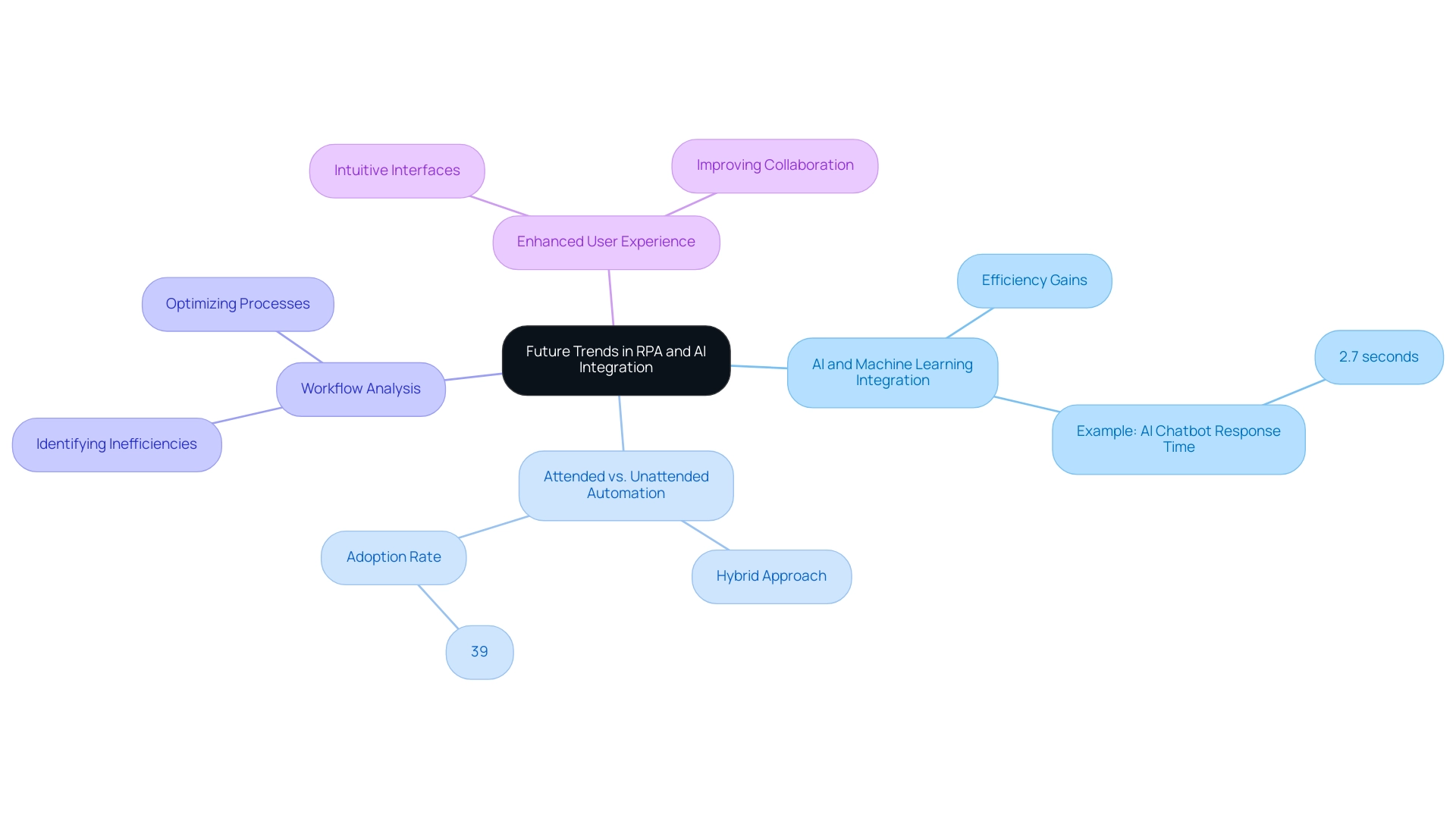
Conclusion
Robotic Process Automation (RPA) is undeniably a game-changer for modern businesses, offering a pathway to enhanced operational efficiency and productivity. By automating repetitive tasks, organizations can not only reduce errors and speed up processes but also empower their workforce to focus on strategic initiatives that drive growth. The real-world examples highlighted throughout demonstrate the tangible benefits RPA can deliver, from significant cost savings to improved employee satisfaction.
Successful implementation of RPA requires careful planning and adherence to best practices, including:
- Stakeholder engagement
- Process identification
- Continuous monitoring
By addressing common challenges such as resistance to change and skill gaps, organizations can navigate the complexities of RPA adoption and unlock its full potential. Moreover, measuring success through key performance indicators ensures that RPA initiatives align with overarching business objectives, paving the way for ongoing innovation and improvement.
As the landscape of automation continues to evolve with advancements in AI and machine learning, businesses must stay ahead of emerging trends to maintain their competitive edge. The integration of intelligent automation not only enhances efficiency but also enriches the user experience, fostering a collaborative environment between humans and bots. By embracing these developments and prioritizing strategic implementation, organizations can thrive in an increasingly automated world, ultimately achieving sustainable growth and success.
Discover how our tailored RPA solutions can transform your business—contact us today to get started!
Introduction
In an age where efficiency is paramount, Robotic Process Automation (RPA) emerges as a transformative solution for organizations striving to enhance productivity and reduce operational costs. By automating repetitive tasks, RPA not only minimizes human error but also liberates valuable employee resources, allowing teams to focus on strategic initiatives that drive innovation.
However, the path to successful RPA implementation is often fraught with challenges, from resistance to change to integration hurdles. This article delves into the multifaceted world of RPA, offering a comprehensive guide on how organizations can effectively harness its potential—from selecting the right tools and defining clear objectives to measuring success through key performance indicators.
With practical insights and strategic recommendations, this exploration aims to empower leaders to navigate the complexities of RPA and unlock its full benefits for their operations.
Understanding Robotic Process Automation (RPA): A Transformative Technology
Robotic Process Automation (RPA) represents a groundbreaking technology that leverages software robots to automate repetitive tasks, steering organizations towards enhanced efficiency and reduced human error. Many companies face challenges such as:
- Manual data entry errors
- Slow software testing
- Difficulties integrating outdated systems without APIs
By emulating human actions, RPA seamlessly interacts with various applications to perform essential functions such as:
- Data entry
- Transaction processing
- Record management
The true potential of RPA lies in liberating human resources, allowing employees to redirect their focus towards higher-value tasks that drive innovation and productivity. Organizations that utilize an RPA client can expect substantial improvements in operational efficiency and cost reductions, along with increased accuracy in their processes. A significant instance is a mid-sized firm’s strategic execution of GUI processes, which streamlined data entry and software testing, leading to a 70% decrease in data entry mistakes and an 80% enhancement in workflow efficiency within six months.
Additionally, the strategic partnership between Blue Prism and Microsoft, announced in June 2024, aims to deliver cloud-based RPA solutions tailored for the financial services sector, potentially reducing operational costs in banking institutions by up to 20% by 2025. As the global RPA market is projected to reach USD 178.55 billion by 2033, growing at a remarkable CAGR of 25.7% from 2024 to 2033, understanding these advantages is crucial for effective RPA implementation. However, insights from the Deloitte Global RPA Survey reveal that 64% of respondents found the implementation time for the RPA client to be longer than anticipated, underscoring the necessity of strategic planning and execution to realize these benefits.
The dynamic nature of the industry, as illustrated by MARA Holdings, Inc. (MARA), which is currently down by 1.79 (-6.53%) at 25.63, further emphasizes the importance of informed decision-making in this evolving landscape.
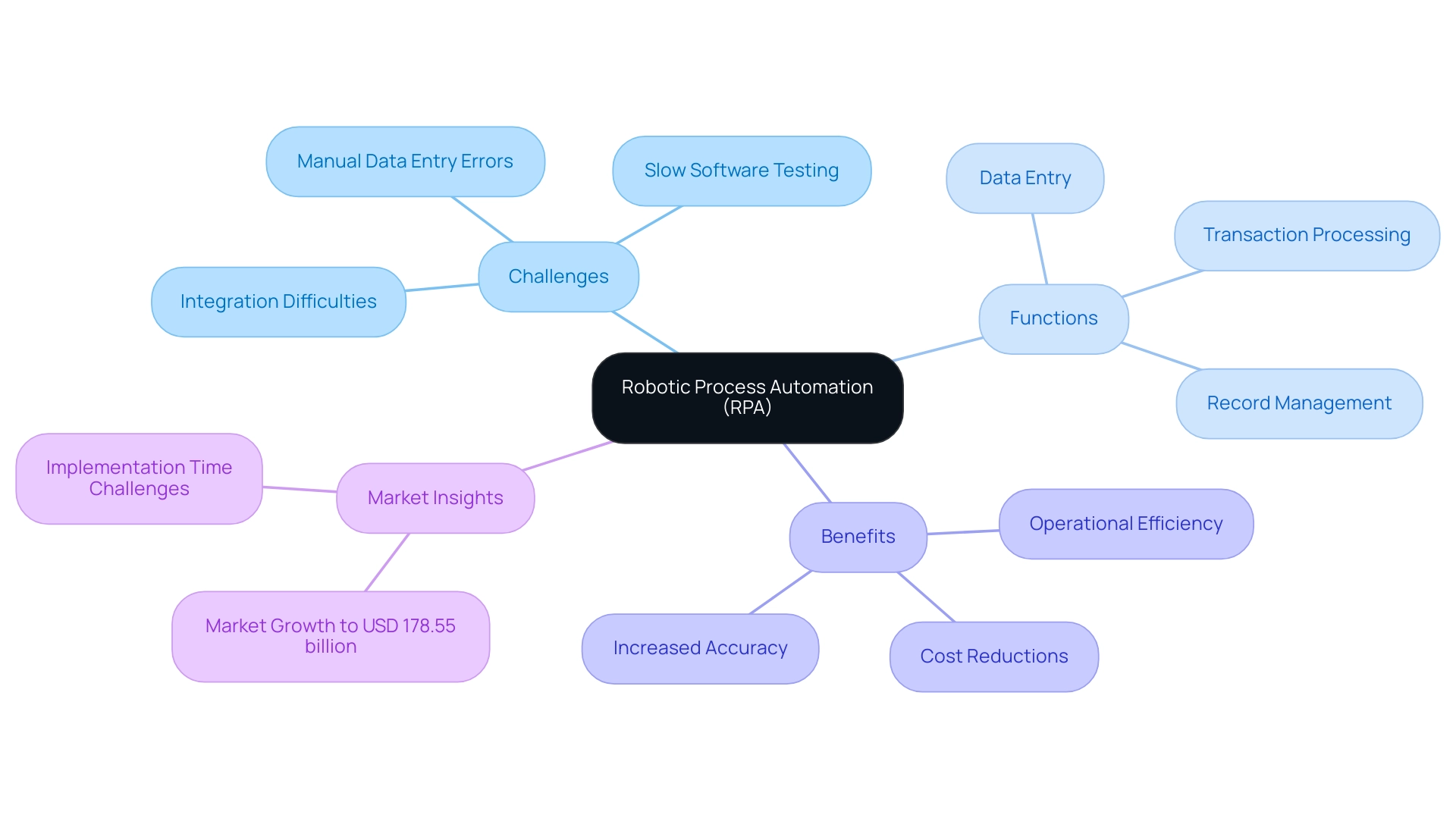
Step-by-Step Implementation of RPA: From Planning to Execution
Implementing an RPA client is a strategic endeavor that requires careful planning and execution. Here’s a step-by-step guide to ensure a successful deployment:
-
Identify Processes for Automation: Start by thoroughly analyzing your current workflows to pinpoint repetitive tasks that could significantly benefit from automation.
Focus on areas that are time-intensive, prone to errors, or require extensive manual input, as these are prime candidates for an RPA client, which can alleviate the burden of mundane tasks on your team and reduce employee exhaustion. -
Engage Stakeholders: Early involvement of key stakeholders is crucial. This includes team members who will interact with the automated processes and decision-makers who can secure the necessary resources.
Engaging them fosters support for the initiative and provides valuable insights that can guide the implementation, especially in addressing staffing shortages and ensuring buy-in for new technologies. -
Define Objectives and Metrics: Clearly articulate the goals of the RPA client initiative and establish specific metrics to evaluate its success.
Metrics may include time savings, reduction in errors, and increased throughput, which will help quantify the impact of RPA on your operations and demonstrate its effectiveness in enhancing productivity. -
Select RPA Tools: Choose RPA software that aligns with your organization’s unique needs.
Consider factors such as user-friendliness, scalability, and compatibility with existing systems to ensure seamless integration.
The cost of implementing an RPA client can range from $5,000 to $15,000 per software, and total costs for company-wide automation could reach millions, making careful selection essential to prevent hindering innovation with outdated systems. -
Develop a Pilot Program: Initiate a small-scale pilot program to test the RPA solution in a controlled environment.
This pilot phase allows for fine-tuning and optimization of the RPA client based on real-world feedback before a full rollout, minimizing potential disruption and ensuring that the RPA client aligns well with operational goals. -
Training and Change Management: Equip employees with the necessary training on the RPA tools they will use.
Address any concerns related to job displacement by highlighting how RPA will free them to focus on more strategic, value-added tasks, thus enhancing their roles.
As noted by ClaySys Technologies, the RPA client can manage up to 90% of data entry tasks in clinical research, showcasing its effectiveness in streamlining operations.
Additionally, emphasize the importance of tailored AI solutions and Business Intelligence in conjunction with RPA to further enhance operational efficiency and decision-making. -
Monitor and Optimize: Post-implementation, continuously monitor the performance of the automated processes using the defined metrics.
This ongoing assessment is vital for identifying areas for improvement and ensuring that the RPA client solution delivers its intended benefits.
Moreover, incorporating AI technologies with RPA can greatly improve decision-making and customer service, demonstrating the wider benefits of automation.
Carrying out these steps will enable entities to efficiently implement RPA, maximizing its benefits while reducing operational disruptions.
With up to 50% of RPA projects failing due to inadequate planning, thorough execution of these steps is critical for success in addressing workplace challenges and enhancing overall operational efficiency.
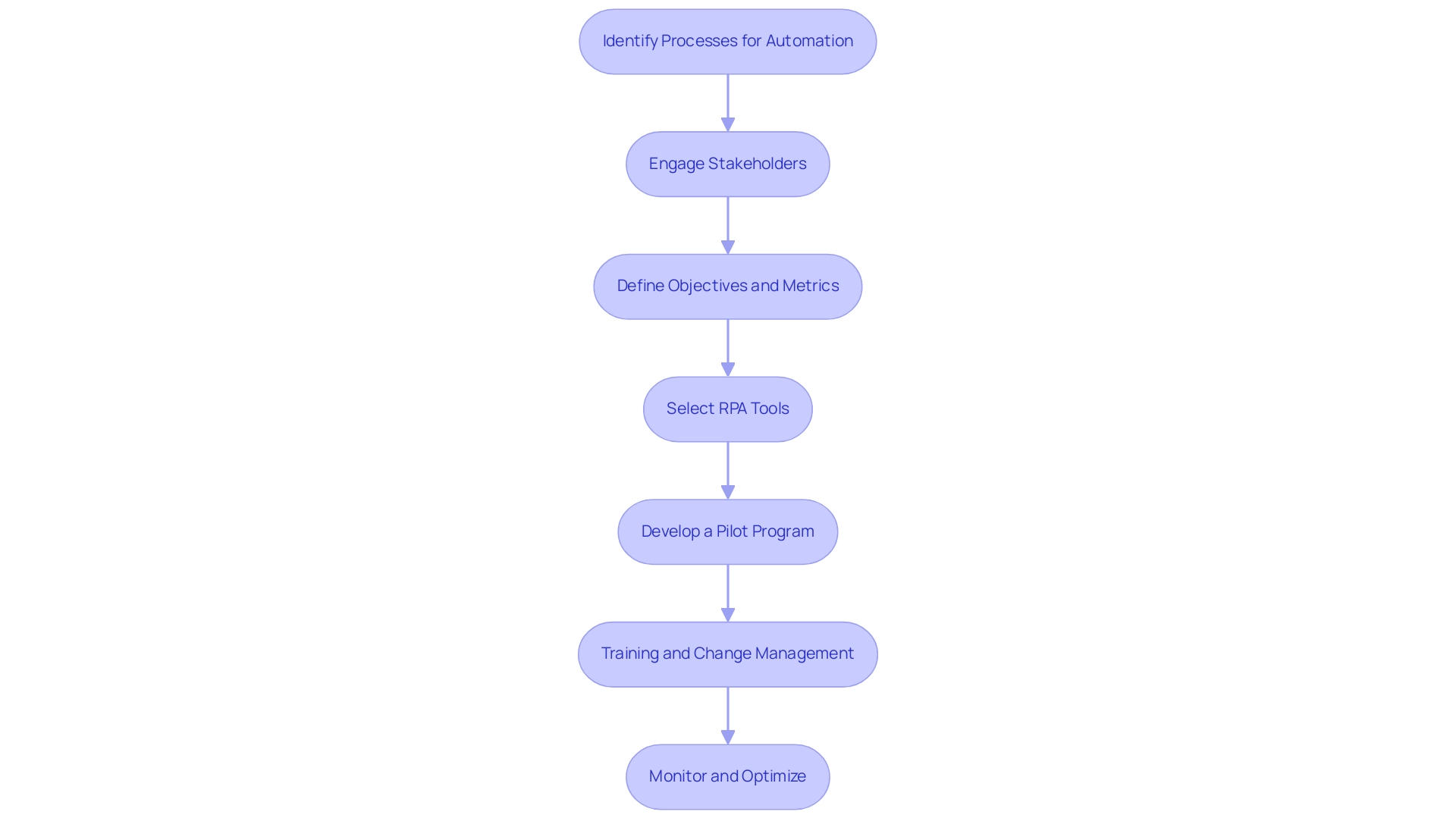
Choosing the Right RPA Tools: Key Considerations
Selecting the right RPA client is crucial for maximizing the benefits of automation and enhancing operational efficiency. Here are the essential criteria to consider:
- Ease of Use: Prioritize tools like EMMA RPA and Microsoft Power Automate, which feature intuitive interfaces that empower non-technical users to design and manage automated workflows effortlessly.
This accessibility to the RPA client can significantly enhance adoption rates throughout the company, leading to improved employee morale and productivity.
-
Scalability: Choose an RPA solution that can grow alongside your organization. A scalable RPA client will effectively handle increased workloads and support additional processes as your operations expand, ensuring sustained efficiency in a rapidly evolving landscape.
-
Integration Capabilities: Opt for RPA tools that seamlessly integrate with your existing systems and applications. This compatibility is vital for unlocking the potential of mechanization while the RPA client minimizes disruptions to current operations, thereby streamlining workflows and enhancing productivity.
-
Support and Community: Look for vendors that offer comprehensive customer support and foster an active user community.
Such resources are invaluable for troubleshooting, sharing best practices, and enhancing user experience, ultimately facilitating a smoother implementation of the RPA client solutions.
- Cost: Conduct a thorough evaluation of the total cost of ownership, considering not only licensing fees and maintenance costs but also any additional expenses related to implementation and training. This ensures a risk-free ROI assessment and provides clarity on the financial commitment involved.
In addition to these criteria, it’s important to recognize the practical applications of RPA tools.
For instance, the RPA client can manage up to 90% of data entry tasks in clinical research, demonstrating its effectiveness in specific industries. A pertinent case study is Kofax, which offers intelligent software platforms that have transformed labor-intensive business processes through cognitive capture, RPA, and analytics. Their solutions demonstrate how entities can leverage the RPA client to achieve significant operational enhancements.
Furthermore, as the RPA sector continues to expand, companies like Workfusion have drawn considerable investment, with $180 million in funding across six rounds, underscoring the market’s potential for improving business productivity. By carefully evaluating these essential elements and grasping the wider context of RPA tools, an RPA client can effectively choose solutions that match their operational requirements, ultimately propelling successful efficiency initiatives.
Significantly, as mechanization progresses, 83% of workers utilizing AI-driven solutions indicate decreases in burnout and enhancements in job satisfaction, highlighting the transformative effect of well-selected mechanization tools.
To discover how RPA can particularly aid your company, schedule a free consultation with us today!
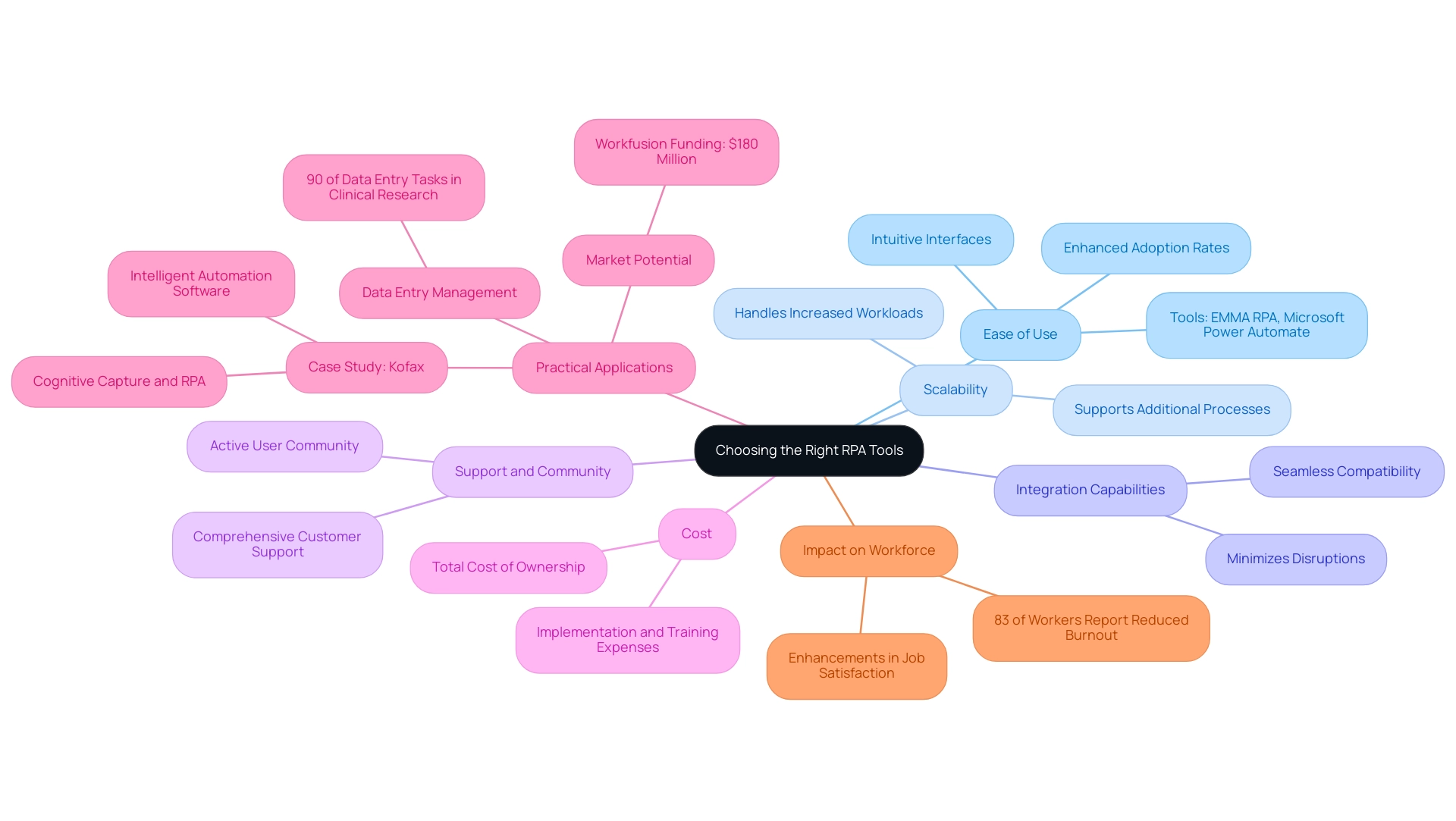
Measuring Success: Key Performance Indicators (KPIs) for RPA
To effectively assess the success of RPA implementations, organizations should establish several key performance indicators (KPIs) that offer valuable insights into the effects of automated processes. The subsequent metrics emphasize the advantages apparent in a recent case study centered on GUI functionality in a mid-sized healthcare company:
- Challenges Faced:
-
Prior to implementing RPA, the company struggled with manual data entry errors, slow software testing, and difficulties integrating outdated systems without APIs. These challenges hindered operational efficiency and staff satisfaction.
-
Time Savings:
-
Measuring the decrease in time required to accomplish tasks through mechanization compared to manual processes is essential for grasping efficiency improvements. In the case study, GUI mechanization reduced data entry errors by 70% and accelerated software testing processes by 50%, leading to significant time savings and improved employee satisfaction, with 83% of employees reporting reduced burnout and enhanced job satisfaction.
-
Error Rate Reduction:
-
By monitoring the decline in errors associated with automated processes, entities can showcase enhanced accuracy and reliability. The aforementioned case study highlights how mechanization significantly reduces human error, enhancing compliance with regulations and boosting operational efficiency.
-
Cost Savings:
-
It’s essential to calculate the financial savings derived from lower labor costs and increased productivity. This metric serves as a critical justification for RPA investments, illustrating the return on investment that organizations can expect, as evidenced by the case study achieving ROI within six months.
-
Process Throughput:
-
Observing the quantity of tasks finished within a specific timeframe provides insights into the influence of mechanization on processing speed. The case study’s results show an improved workflow efficiency by 80%, showcasing the scalability of RPA initiatives.
-
Worker Satisfaction:
- Gathering feedback from staff regarding their experiences with RPA offers qualitative data that can signify the success of technology adoption. The statistic that 83% of employees report enhanced job satisfaction due to AI-powered automation directly correlates with this KPI, emphasizing how effective RPA implementation empowers employees to focus on higher-value tasks.
By regularly reviewing these KPIs, companies can ensure their RPA initiatives deliver anticipated benefits. As noted by Bart Teodorczuk, RPA Tech Lead at Flobotics, ‘Our team, sourced only from the ‘Big Four’ of accounting, will analyze your processes and current RPA setup and recommend the metrics and KPIs to measure best suited for your business goals and needs.’ This expert analysis is crucial for guiding entities in fine-tuning their RPA strategies for optimal performance, ensuring that the right metrics are in place to measure success.
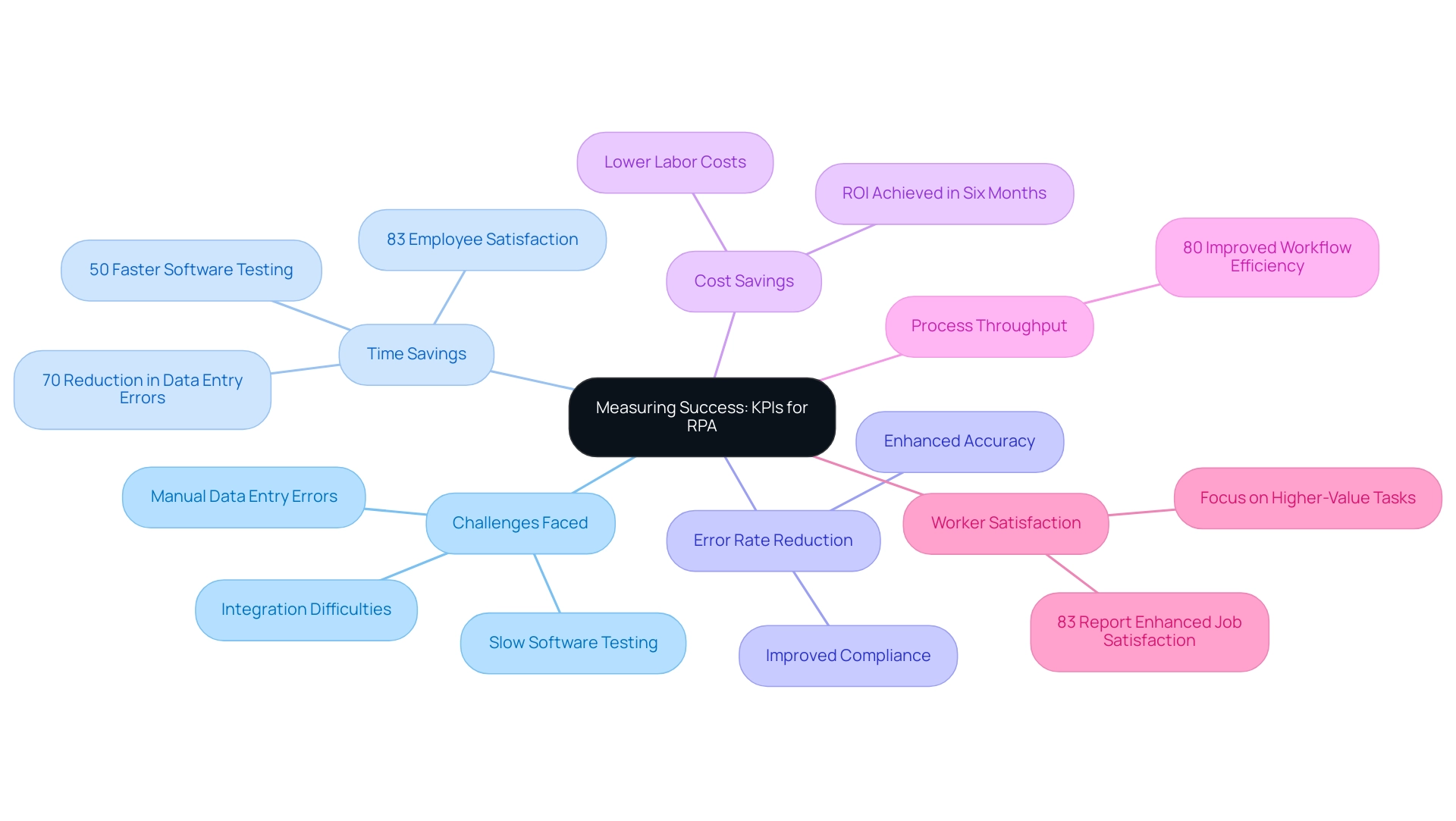
Overcoming Challenges in RPA Implementation
Implementing Robotic Process Automation (RPA) can yield remarkable benefits, yet organizations often encounter several challenges that can hinder success:
- Resistance to Change: A frequent obstacle stems from worker concerns about technology’s effect on their positions. To alleviate these concerns, it is vital to communicate the advantages of the RPA client clearly, emphasizing how it can reduce burnout and enhance job satisfaction.
In fact, 83% of workers utilizing AI-driven systems believe it enhances their work experience. Involving staff in the RPA client journey fosters ownership and encourages buy-in.
- Lack of Clarity in Goals: Vague objectives can lead to ineffective efforts in mechanization.
It’s crucial to ensure that all stakeholders share a unified understanding of the goals of the RPA client initiative from the outset, aligning expectations to streamline implementation.
- Integration Issues: The technical integration of RPA with existing systems can pose significant challenges.
Selecting tools with robust integration capabilities and engaging IT early in the planning process can mitigate these issues and facilitate smoother transitions.
- Insufficient Training: A well-prepared workforce is essential for successful RPA adoption.
Investing in comprehensive training programs empowers employees to navigate new tools confidently, such as the RPA client, enabling them to maximize the benefits of automation.
- Over-automation: Automating processes that are not well-suited for RPA may lead to inefficiencies.
It is essential to perform comprehensive assessments of processes within the RPA client to determine which ones genuinely gain from mechanization, ensuring a strategic approach.
Furthermore, it is significant that on average, workers save 3.6 hours per week by utilizing the RPA client, highlighting the time-saving advantages of mechanization.
Moreover, as shown in successful case studies, the RPA client has enabled GUI processes that have reduced data entry errors by 70% and accelerated testing methods by 50%, showcasing its effectiveness in enhancing operational efficiency.
Furthermore, industry bodies are actively working on establishing standards for RPA client implementations to ensure best practices, which fosters a reliable and scalable RPA ecosystem.
By anticipating these challenges and implementing targeted strategies to address them, organizations can set the stage for successful RPA client implementation, ultimately enhancing operational efficiency and employee satisfaction.
Importantly, with our service promise, you only pay if we deliver what was promised, ensuring that we take on the ROI risk for you. Together, we will access a process you want to automate, calculate the efforts involved, estimate the time savings, and automate the process with a certified professional. This approach guarantees that the automation is delivered as planned, providing you with measurable ROI.
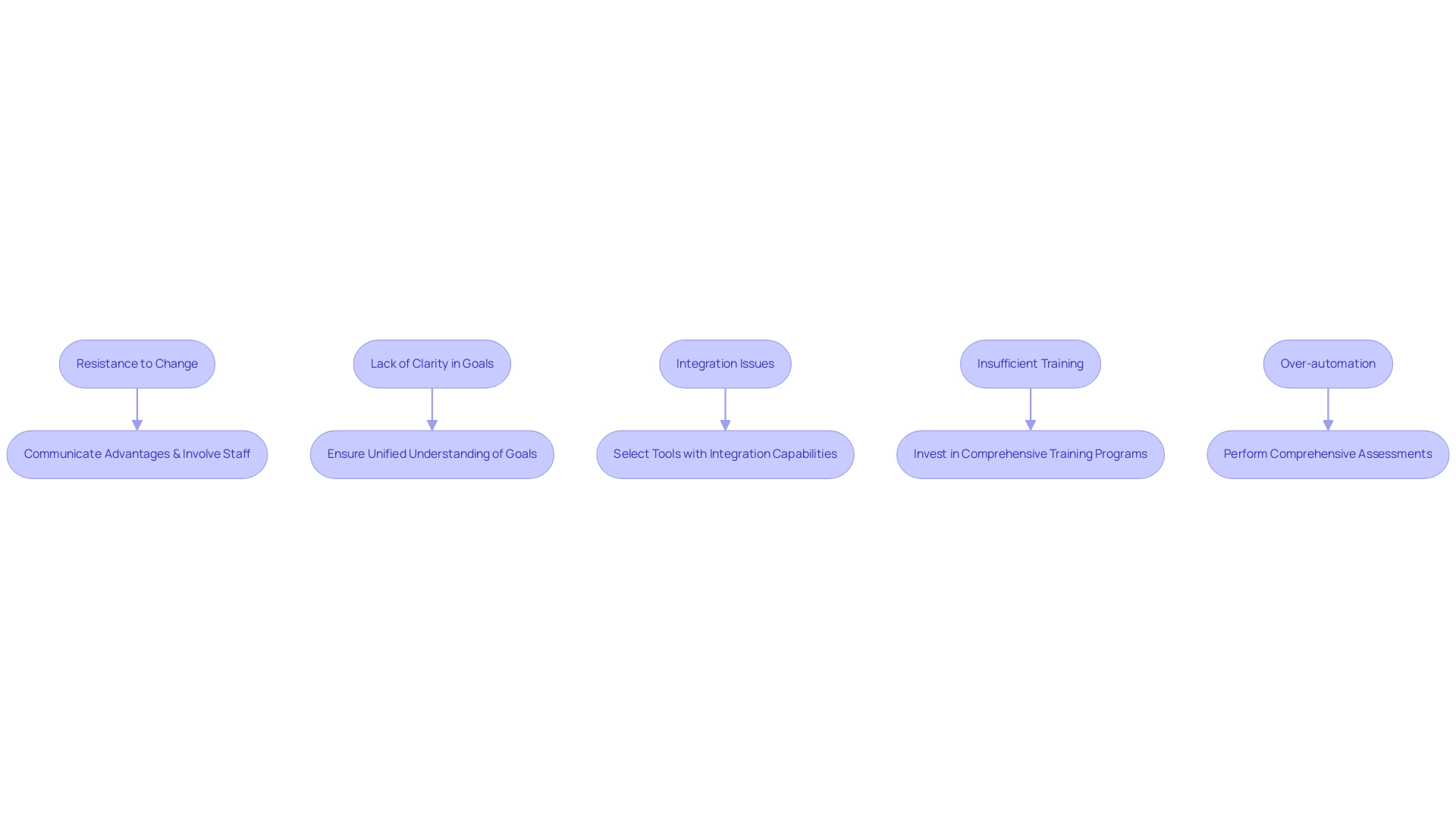
Conclusion
Robotic Process Automation (RPA) stands as a powerful catalyst for organizations seeking to enhance productivity and operational efficiency. By automating repetitive tasks, RPA not only reduces human error but also empowers employees to concentrate on higher-value initiatives that foster innovation. The journey towards successful RPA implementation involves careful planning, including:
- Identifying the right processes to automate
- Engaging stakeholders
- Selecting appropriate tools that align with organizational needs
Strategically navigating the challenges of RPA, such as resistance to change and integration issues, is crucial for unlocking its full potential. Organizations must prioritize training and change management to ensure employees feel supported and equipped to embrace new technologies. By establishing clear objectives and measuring success through key performance indicators, businesses can quantify the impact of RPA on their operations, demonstrating its value in achieving substantial time and cost savings.
As the RPA market continues to grow, understanding the nuances of this transformative technology is essential. Companies that adopt a strategic approach to RPA implementation will not only reap immediate benefits but also position themselves for sustained success in an increasingly automated world. Embracing RPA is not just about technology; it’s about reshaping the future of work, enhancing employee satisfaction, and driving organizational excellence. Now is the time for leaders to take bold steps towards automation, harnessing RPA to revolutionize their operations and unlock new avenues for growth.
Introduction
In a world where efficiency and accuracy are paramount, organizations are turning to Robotic Process Automation (RPA) as a transformative solution to streamline operations and enhance productivity. By harnessing the power of software robots, businesses can automate repetitive tasks that once consumed valuable human resources, allowing employees to focus on strategic initiatives that drive growth.
From healthcare to telecommunications, RPA is proving its worth by dramatically reducing errors and accelerating processes, as evidenced by compelling case studies. However, the journey to successful RPA implementation is not without its challenges, requiring a thoughtful approach to address employee concerns and integrate new technologies seamlessly.
This article delves into the multifaceted landscape of RPA, exploring its types, benefits, and practical steps for implementation, empowering organizations to navigate the path toward greater operational efficiency and innovation.
Understanding Robotic Process Automation (RPA): Definition and Overview
To understand what does RPA, it’s essential to recognize that Robotic Process Automation is revolutionizing the way businesses operate by deploying software robots or ‘bots’ to automate repetitive, rule-based tasks that have historically been handled by humans. This innovative technology enables entities to streamline their operations by emulating human actions across various digital systems. In a case study involving a mid-sized healthcare company, the organization faced significant challenges, including manual data entry errors and slow software testing processes, which hindered operational performance.
To address these challenges, the company introduced GUI technology, resulting in a significant decrease in data entry mistakes by 70%, speeding up testing procedures by 50%, and an overall enhancement in workflow productivity by 80%. Such measurable outcomes highlight what does RPA in demonstrating its versatility across various sectors, leading to significant enhancements in productivity and a noticeable reduction in errors. By automating mundane tasks, businesses not only enhance accuracy and speed but also liberate their workforce, enabling employees to focus on more strategic initiatives.
This shift toward automation is not just a trend; it represents a fundamental transformation in operational performance. As noted by experts at ClaySys Technologies, ‘RPA can handle up to 90% of data entry tasks in clinical research,’ which raises the question of what does RPA mean for sectors like healthcare. Furthermore, the recent $180 million funding raised by Workfusion underscores the growing investment and interest in RPA technologies, highlighting its relevance in today’s market.
Furthermore, the incorporation of AI advancements, like smart bots, is poised to reshape business procedures and open new possibilities, as demonstrated by the case study named ‘Impact of AI on RPA,’ which illustrates how these developments are transforming the digital workplace and generating new paths for operational effectiveness.
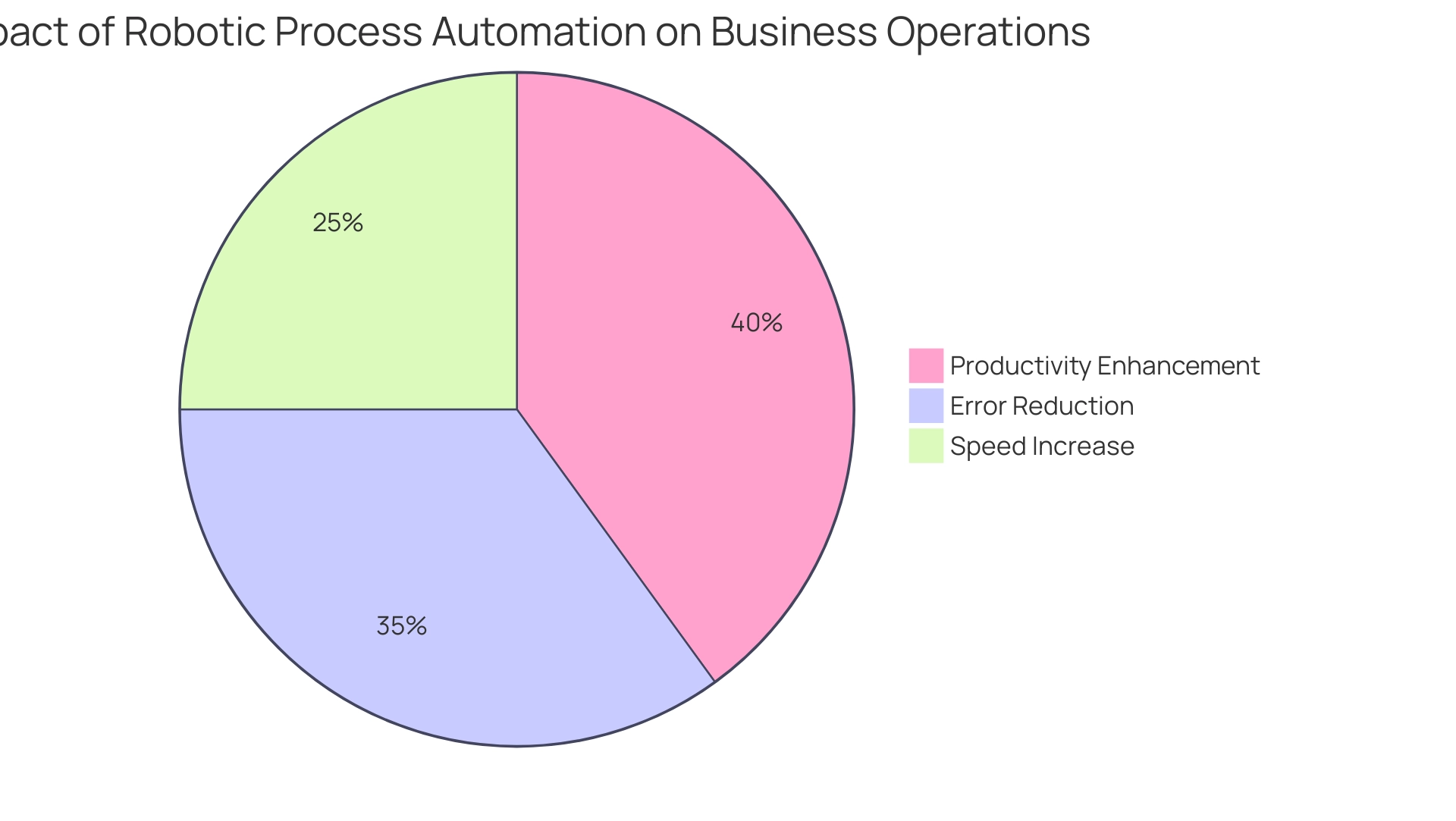
Exploring the Different Types of RPA: Attended, Unattended, and Hybrid
When discussing the types of Robotic Process Automation (RPA), it is important to consider what does RPA include, as it is categorized into three main types: attended, unattended, and hybrid.
- Attended RPA operates in tandem with human users, augmenting their capabilities by automating segments of their workflow. This synergy not only enhances productivity but also empowers employees to focus on more complex tasks, combating task repetition fatigue.
As Alexis Veenendaal, Associate Content Writer and Editor at SS&C Blue Prism, notes, “The integration of RPA into business processes not only streamlines operations but also allows employees to engage in more meaningful work.”
-
Unattended RPA operates independently, performing repetitive and high-volume tasks without the need for human oversight, making it especially effective for operations that require consistency and productivity at scale. The case study titled ‘Power of Attended vs Unattended RPA‘ explores what does RPA, illustrating that while attended RPA enhances human capabilities, unattended RPA excels in automating repetitive tasks, leading to increased efficiency and cost savings.
-
Hybrid RPA model uniquely combines both attended and unattended solutions, providing entities the flexibility to optimize task execution based on specific operational demands. Recent developments indicate that entities are increasingly combining attended and unattended RPA for a hybrid approach, leading to the question of what does RPA mean in terms of reinforcing its relevance in current operational strategies.
EMMA RPA, featuring its user-friendly interface, simplifies the mechanization of complex processes, while Microsoft Power Automate offers seamless integration with existing applications, enabling streamlined workflows and risk-free ROI assessments.
By updating obsolete systems, these RPA solutions decrease mistakes and increase productivity, enabling companies to strategically align their automated efforts with operational goals and workforce dynamics, paving the way for improved effectiveness and innovation while tackling the challenges of staffing shortages.
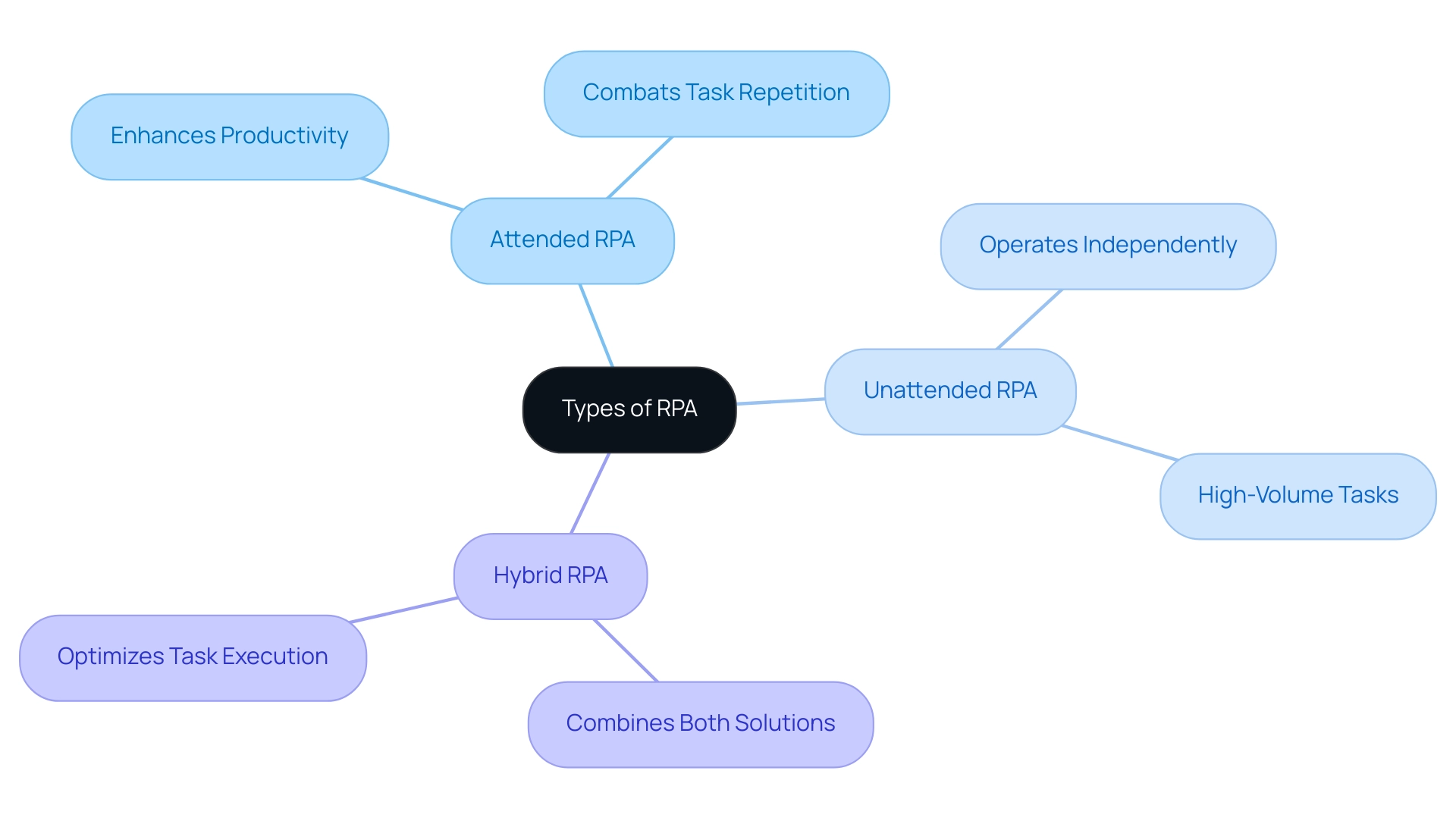
The Key Benefits of RPA: Enhancing Efficiency and Reducing Costs
Understanding what does RPA entail can provide organizations with a transformative opportunity to enhance productivity, reduce operational costs, and improve accuracy. A compelling case study demonstrates this, where a mid-sized healthcare company implemented GUI technology to streamline operations, overcoming challenges such as manual data entry errors, slow software testing, and the integration of outdated legacy systems. By automating repetitive tasks, they accomplished a notable 70% decrease in data entry mistakes and enhanced testing procedures by 50%, resulting in an 80% boost in workflow productivity.
This not only minimized human errors but also enabled the entity to realize its ROI within just six months, directly linked to the efficiencies gained from the automation solutions implemented. Furthermore, RPA’s potential extends beyond healthcare; in sectors such as telecommunications, it can significantly cut operational costs by automating customer service and back-office processes. According to recent findings, 61% of entities that embraced RPA reported meeting or exceeding their cost reduction expectations.
Cem Dilmegani, a Principal Analyst at AIMultiple, emphasizes that entities leveraging RPA can strategically reallocate human resources to focus on innovation and growth. The evolution of usage-based pricing models further underscores the industry’s responsiveness to businesses seeking affordable technological solutions. While RPA enhances efficiency gains and enables entities to take advantage of significant cost reductions, it also requires careful thought about what does RPA imply for its wider effects, including possible job losses in the public sector by 2030.
Embracing RPA fosters a culture of continuous improvement and strategic advancement, making it an essential consideration for operational leaders.
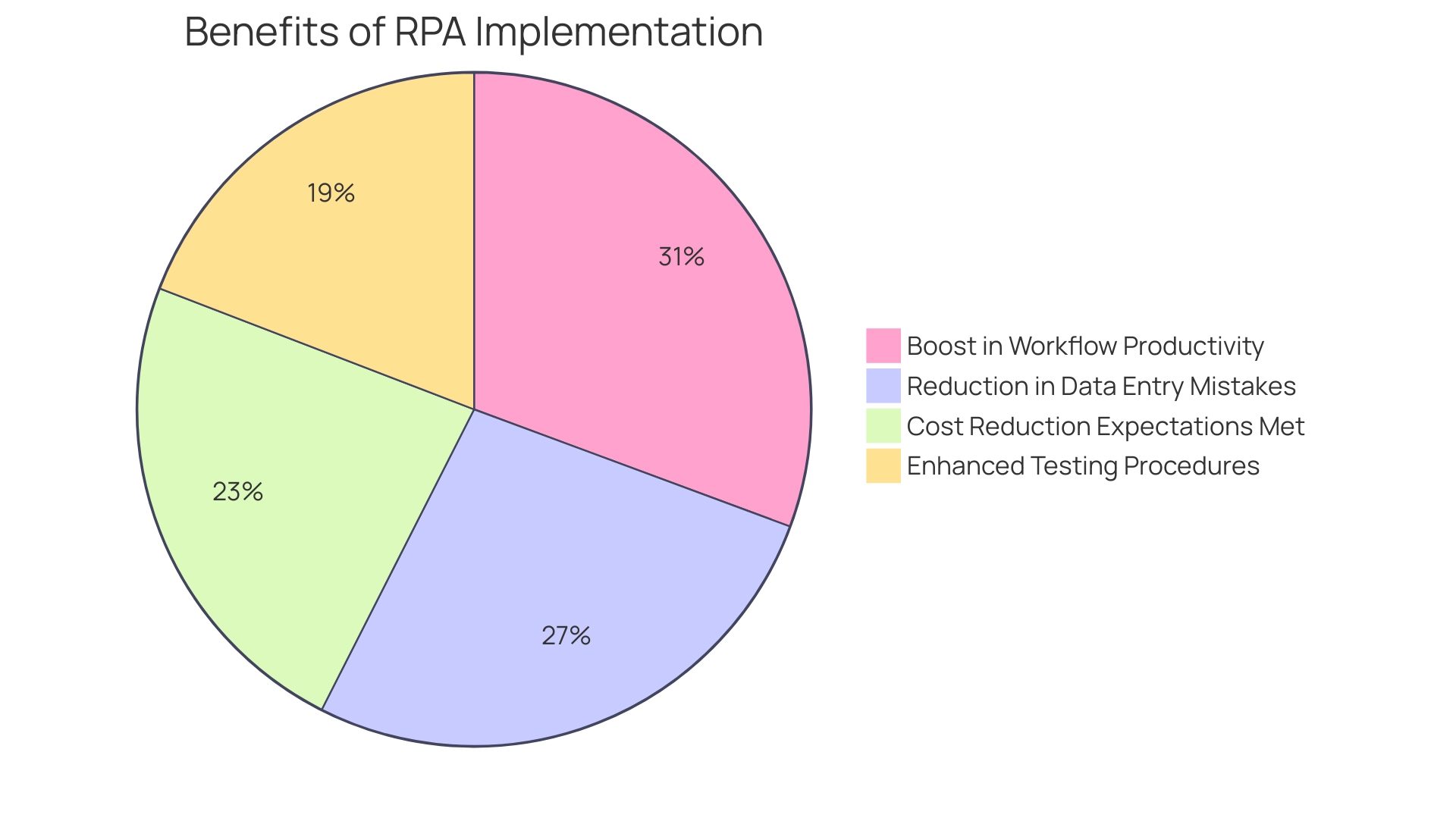
Challenges and Considerations in RPA Deployment: What to Watch Out For
While robotic process technology (RPA) offers substantial benefits, organizations must understand what RPA involves as they navigate a range of challenges during its deployment. One significant hurdle is the resistance to change from employees, who may worry about job displacement. However, findings indicate that 83% of employees using AI-driven processes feel it alleviates burnout and enhances job satisfaction, suggesting that resistance often stems from a lack of understanding rather than the technology itself.
ClaySys Technologies emphasizes that RPA can efficiently handle up to 90% of data entry tasks in clinical research, showcasing its ability to optimize operations without necessarily removing jobs.
As we reflect on the swiftly changing AI environment, the wider consequences of mechanization cannot be ignored. Robots are expected to take over 20% of current routine tasks, with estimates suggesting they could handle as much as 52%. Furthermore, it is projected that 861,000 public sector jobs will be lost to automation by 2030, potentially saving £17 billion off public sector payments compared to 2015.
These statistics underscore the urgency of addressing employee concerns regarding job security while leveraging tailored AI solutions to align with specific business goals.
Integrating RPA with existing systems can introduce technical complexities. To address these challenges, entities should conduct comprehensive assessments of their current processes and develop robust change management strategies. Successful implementations often involve clear communication about what RPA means in terms of its benefits, alongside training programs that equip employees for the transition to an automated environment.
Additionally, it is crucial to highlight the financial advantages of RPA integration, as case studies reveal that 61% of participants in RPA adoption initiatives reported meeting or exceeding their cost reduction expectations, showcasing the financial benefits of effective integration.
By explicitly connecting these successes to the challenges faced, firms can better understand how to overcome resistance and achieve desired outcomes. As mechanization continues to advance, it is vital for companies to proactively foresee and tackle these challenges, ensuring a smoother shift to a mechanized future that improves operational efficiency and business intelligence.
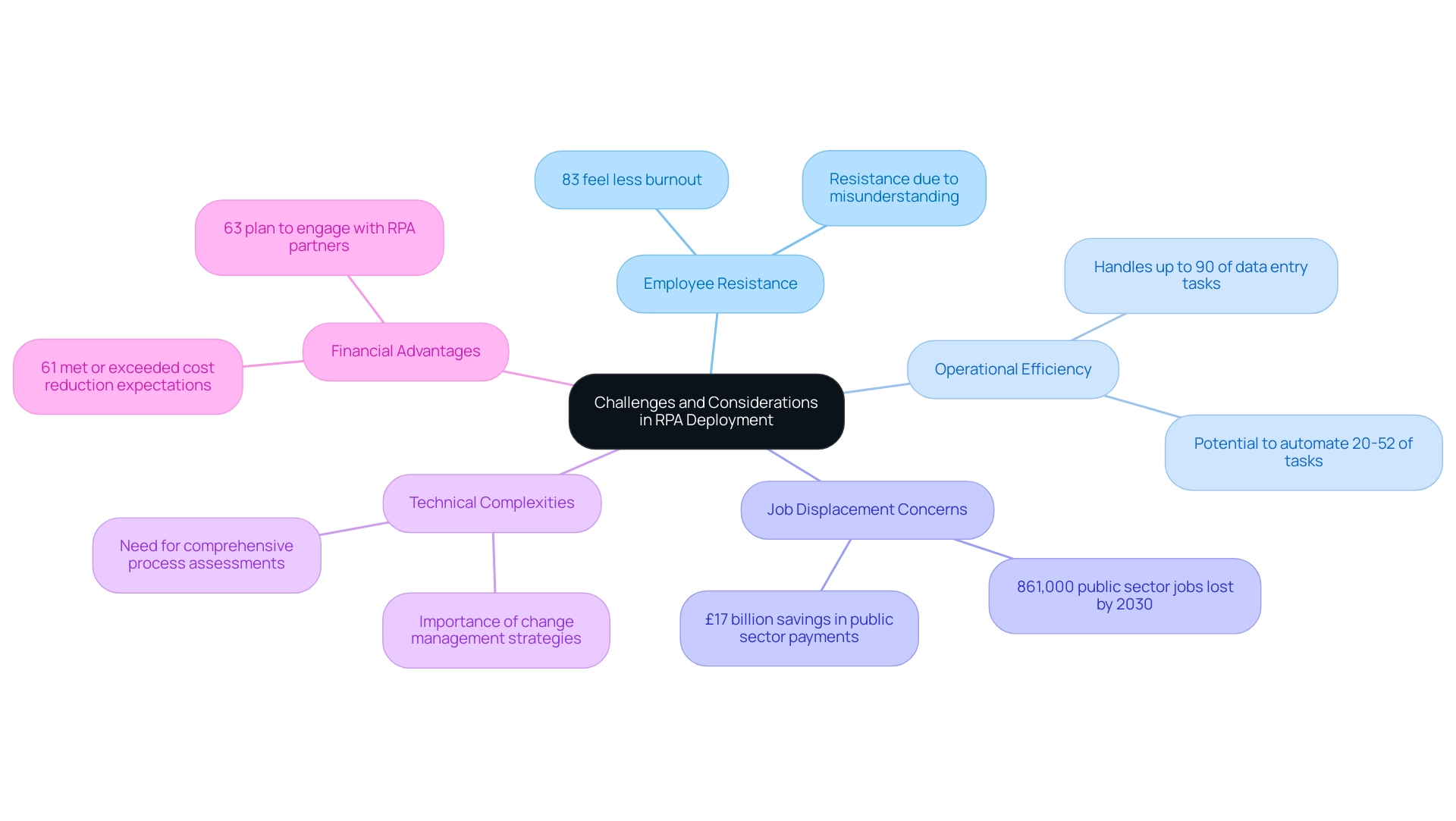
Implementing RPA: A Step-by-Step Guide for Organizations
To understand what does RPA entail, effectively executing robotic process technology in your establishment necessitates a strategic and systematic approach. Here’s a step-by-step guide to navigate this transformative journey:
- Identify Suitable Processes: Begin by analyzing your workflows to pinpoint repetitive and mundane tasks, such as data entry or extraction, that can benefit from mechanization.
This foundational step is crucial as it sets the stage for effective RPA integration, particularly in addressing employee exhaustion and enhancing morale, leading to a better understanding of what does RPA involve.
-
Select Appropriate RPA Tools: Evaluate and choose RPA tools that align with your organization’s specific needs and existing technology stack. With significant investments in technology—such as UiPath’s $1.2 billion funding, Automation Anywhere’s $840 million, Blue Prism Group’s $182 million, and Workfusion’s $180 million—there are robust solutions available to meet diverse requirements and combat staffing shortages.
-
Develop a Comprehensive Implementation Plan: Craft a detailed plan that outlines timelines, milestones, and resource allocation. Clearly defining these elements ensures your team remains focused and organized throughout the process, effectively modernizing outdated systems that hinder innovation.
-
Conduct Pilot Testing: Before scaling your RPA solution, engage in pilot testing to assess its effectiveness and address any potential issues.
This step is essential for minimizing disruptions during the full deployment phase, ensuring a smooth transition. Our company assures that you only pay if the system is delivered as planned, taking on the ROI risk for you.
- Train Your Team and Provide Ongoing Support: Equip your employees with the necessary training on the new system, and establish a support framework to help them adapt to the changes.
We provide comprehensive support during pilot testing and beyond, ensuring that your team is well-prepared for the transition. As emphasized in the Deloitte Global RPA Survey, over 90% of C-level executives utilizing intelligent automation believe their companies excel at managing change in response to evolving business trends. Effective training and support are crucial for success.
By following these structured steps, entities can unlock the full potential of RPA, leading to the question of what does RPA offer, as evidenced by findings from Hyland’s RPA Software Suite Economic Study, which demonstrates a remarkable 227% return on investment from successful RPA implementation. Notably, robots could contribute as much as 52% of work capacity among RPA adopters, emphasizing the transformative impact of RPA on operational efficiency. Embracing these best practices will not only streamline operations but also drive substantial financial gains, positioning your organization for future success in an increasingly automated landscape.
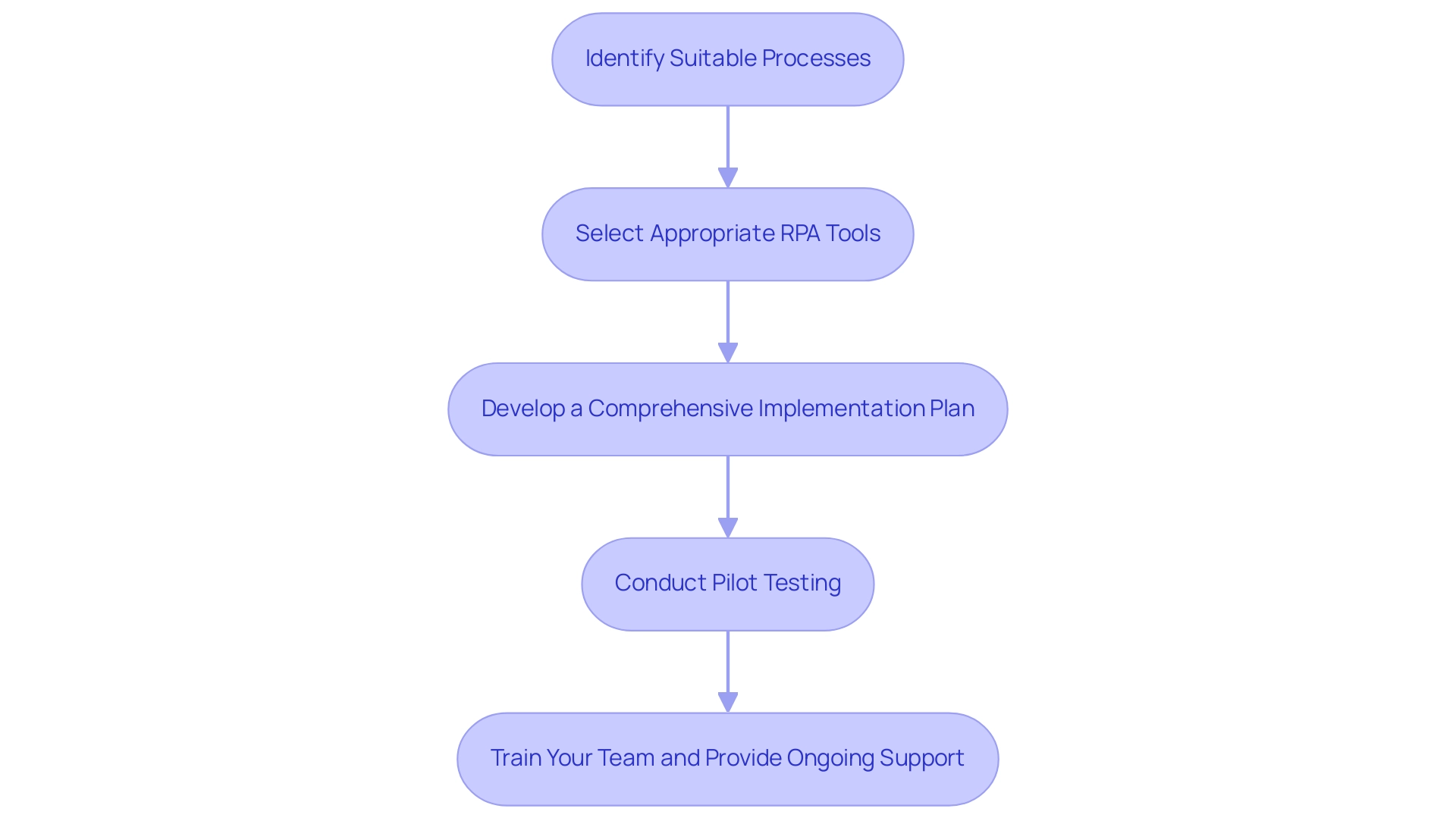
Conclusion
The exploration of Robotic Process Automation (RPA) highlights its transformative potential across various industries. By automating repetitive tasks, organizations can achieve remarkable improvements in efficiency and accuracy, as demonstrated by case studies in healthcare and telecommunications. The shift towards RPA not only reduces operational costs but also liberates human resources, allowing employees to engage in more strategic initiatives that drive innovation and growth.
Understanding the different types of RPA—attended, unattended, and hybrid—provides organizations with the flexibility to tailor automation solutions to their specific needs. Each type serves a unique purpose, whether enhancing human capabilities or executing tasks autonomously, thereby paving the way for a more streamlined operational framework.
However, the journey to successful RPA implementation is not without its challenges. Addressing employee concerns and integrating new technologies require careful consideration and strategic planning. By following a structured approach that includes:
– Identifying suitable processes
– Selecting the right tools
– Providing thorough training
organizations can navigate these hurdles effectively.
Ultimately, embracing RPA is not just about adopting new technologies; it is about fostering a culture of continuous improvement and innovation. As businesses look to the future, leveraging RPA will be essential for achieving sustained operational efficiency and maintaining a competitive edge in an increasingly automated world. Now is the time to take decisive action and harness the full potential of RPA to drive organizational success.
Introduction
As the recruitment landscape undergoes a radical transformation, organizations are presented with a unique opportunity to harness the power of automation to redefine their hiring processes. The integration of technology and artificial intelligence into recruitment not only streamlines mundane tasks but also enhances the overall candidate experience, making it a game-changer in the quest for top talent.
With nearly 40% of jobs worldwide now influenced by AI, companies must adapt their strategies to stay competitive in an increasingly digital world. This article delves into the multifaceted world of automated hiring, exploring its benefits, essential tools, and the challenges organizations face in implementation.
By understanding these dynamics, businesses can position themselves at the forefront of innovation, driving efficiency and fostering a diverse workforce in the process.
Defining Automation Hiring: An Overview
Automation hiring involves the strategic implementation of technology and artificial intelligence to streamline and enhance recruitment processes. This approach entails automating repetitive tasks such as:
- Resume screening
- Interview scheduling
- Applicant communication
Leveraging automation not only boosts hiring efficiency but also significantly reduces time-to-fill positions and elevates the overall candidate experience.
As nearly 40% of jobs worldwide are increasingly exposed to AI, companies must adapt to this shift to maintain a competitive edge in attracting top talent. Moreover, the trend of digital transformation is set to continue, prompting companies to rethink their recruitment strategies with a focus on automation hiring. Based on a recent MIT Tech Review survey, almost half of the 600 companies surveyed indicated that they intend to boost their expenditure on data infrastructure and AI by more than 25% in the coming year, highlighting the necessity for entities to adopt automation hiring to effectively maneuver the changing labor market.
In this context, it is crucial to acknowledge the common perceptions that AI projects can be time-intensive, costly, and challenging to implement. By addressing these concerns directly, entities can alleviate hesitations and foster a more open mindset towards AI integration. Furthermore, leveraging Robotic Process Automation (RPA) can enhance operational efficiency by automating manual workflows, thereby overcoming common challenges associated with poor master data quality and addressing hesitations about AI adoption.
By comprehending the intricacies of automation hiring and the wider consequences of digital transformation, companies can place themselves to prosper in a progressively automated future, enhancing productivity through customized AI solutions and Business Intelligence for informed decision-making.
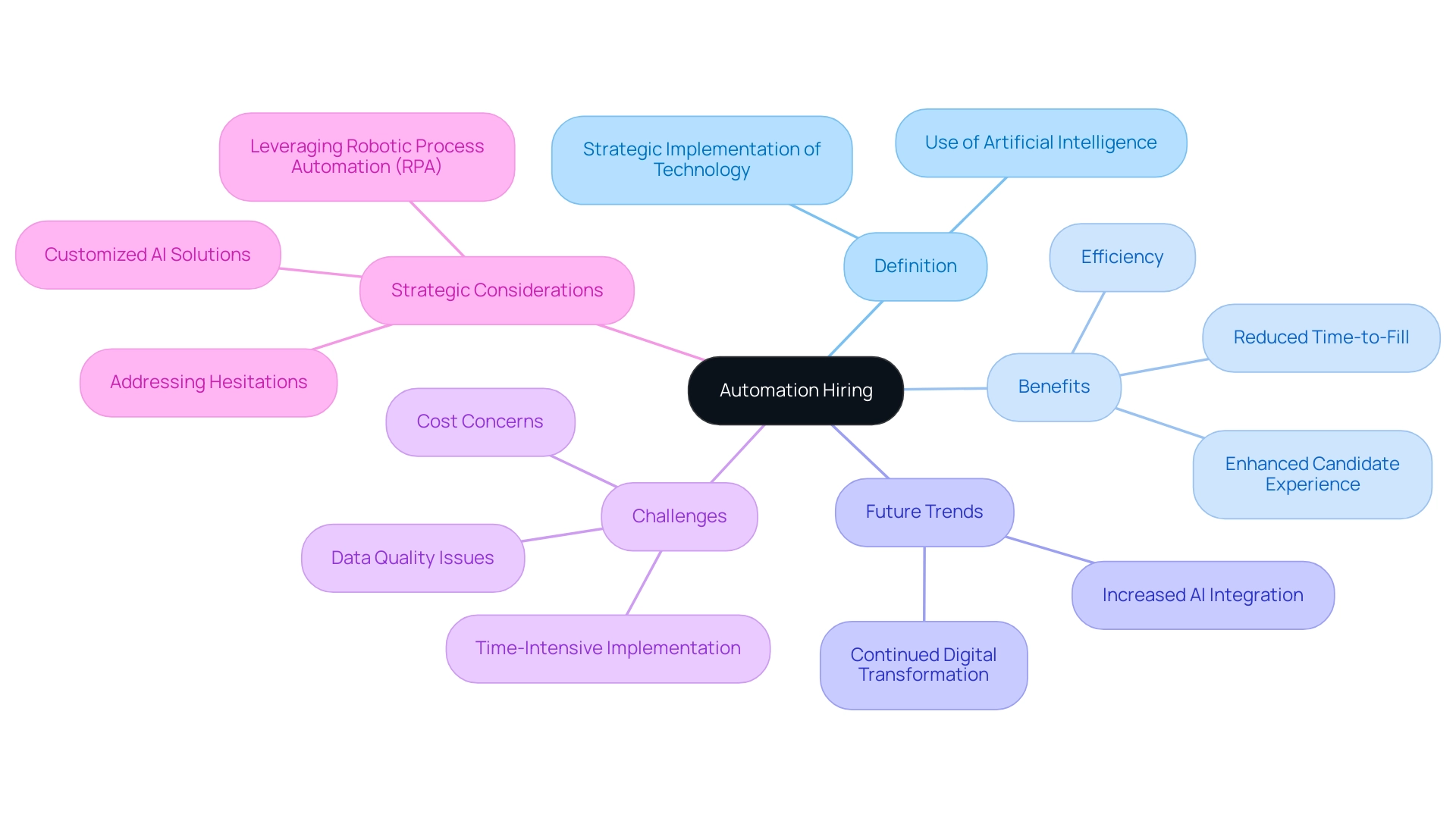
The Benefits of Automated Hiring: Efficiency and Beyond
Automation hiring offers a transformative opportunity for organizations, delivering numerous advantages such as heightened efficiency, reduced bias, and an improved applicant experience. By integrating Robotic Process Automation (RPA) solutions like EMMA RPA and Microsoft Power Automate, HR teams can automate routine tasks, allowing them to redirect their focus toward strategic decision-making and nurturing interpersonal relationships. EMMA RPA streamlines repetitive tasks, addressing task repetition fatigue, while Power Automate facilitates seamless workflow automation, ensuring a risk-free ROI assessment.
Automation minimizes human bias during the screening process, ultimately leading to a more diverse candidate pool. For instance, companies like Meta have leveraged these technologies to access diverse talent, showcasing how automation hiring can streamline the process while prioritizing diversity and inclusion. Current information indicates that:
- 91% of tech firms are planning to invest in sourcing tools
- 86% are prioritizing employer branding
This highlights the industry’s commitment to innovative recruitment practices.
Furthermore, 41% of recruiters acknowledge that AI offers valuable insights during the hiring process, further enhancing efficiency. However, organizations must be mindful that 35% of recruiters worry that AI may exclude individuals with unique skills and experiences, highlighting the need for careful implementation of automated selection solutions. Companies adopting these solutions often report increased candidate satisfaction, as automated communication tools facilitate timely updates and feedback throughout the recruitment journey.
According to Rebecca Carr, Chief Product Officer at SmartRecruiters,
We’re at the perfect epicenter of innovation and experimentation. Companies will screen fewer individuals and reach employment decisions faster. They’ll have better insight into their hiring activities so that they can be more proactive about streamlining their processes.
This shows how automation hiring not only boosts efficiency but also promotes a more engaging candidate experience, ultimately transforming the hiring landscape for the better. The integration of robotics in this context is further emphasized by the visual representation of a human figure collaborating with robotic figures, illustrating the synergy between technology and human resources.
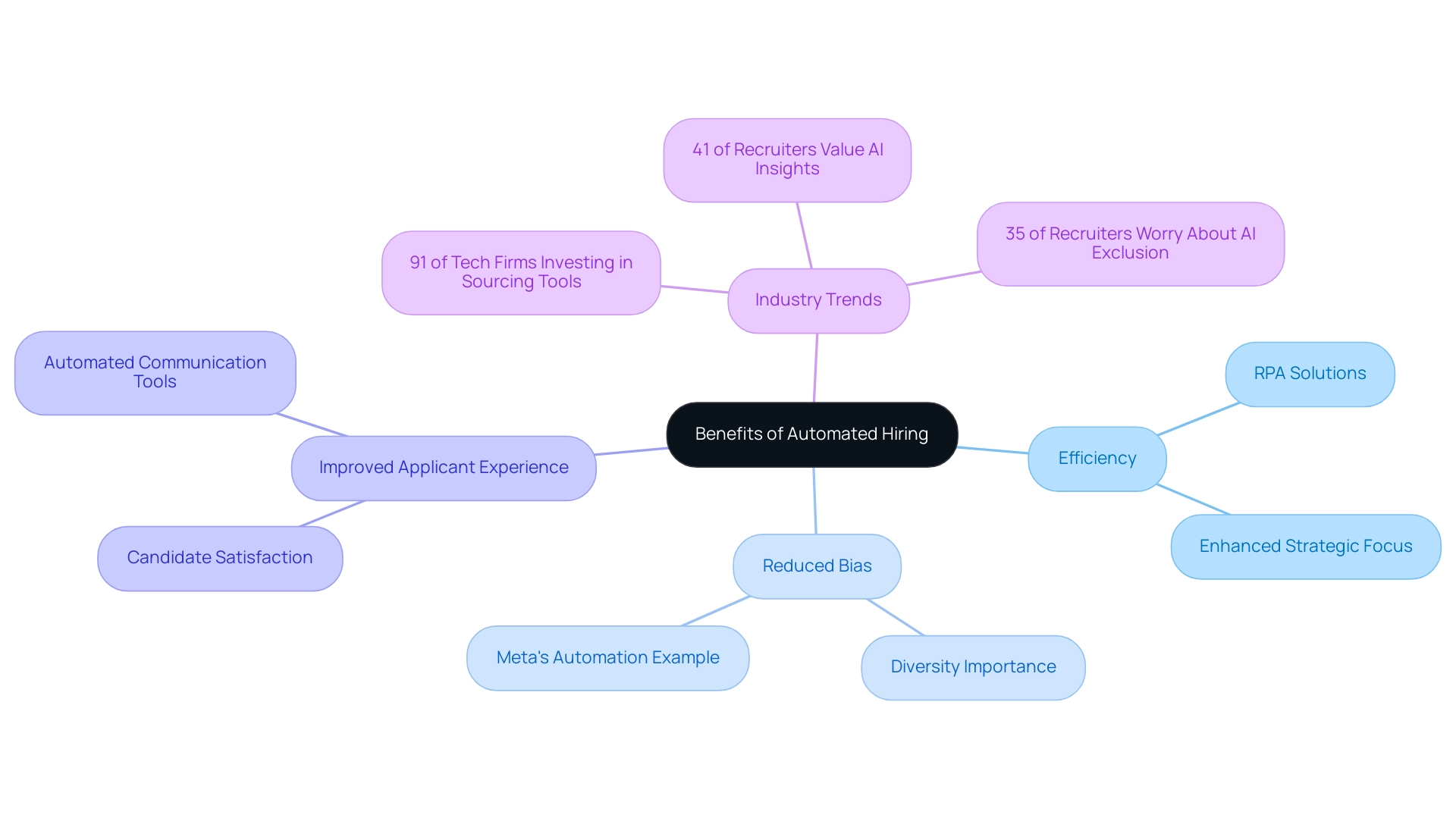
Essential Tools for Automation in Recruitment
In the evolving landscape of hiring and operational efficiency, automation hiring tools are essential for streamlining processes and enhancing productivity. Robotic Process Automation (RPA) serves as a transformative solution, supporting automation hiring by automating manual workflows and addressing common workplace challenges such as:
- Repetitive tasks
- Talent retention difficulties
- Outdated systems
Applicant Tracking Systems (ATS) stand as the backbone of modern recruitment, enabling automation hiring by meticulously sorting and filtering resumes according to predefined criteria. This not only speeds up the recruitment process through automation hiring but also guarantees that selection teams concentrate on the most suitable individuals.
Furthermore, automation hiring through AI-driven chatbots has revolutionized candidate engagement by providing real-time responses to inquiries and guiding applicants through each step of the application process—significantly enhancing the candidate experience. These chatbots can also be integrated into broader operational frameworks to streamline customer interactions and improve service delivery.
Automated scheduling software enhances automation hiring by facilitating seamless interview coordination, minimizing back-and-forth communication, and conserving valuable time for HR teams. Notably, this tool has streamlined remote interviews, eliminating the need for physical offices, showcasing its efficiency in the current landscape.
The effectiveness of these tools is underscored by insights from a Decathlon employee, who remarked,
“[TalentLyft] gives employees more freedom in hiring and leaves me more time to focus on other aspects of my job, which makes everyone happy at the end of the day.”
This sentiment reflects the broader trend of automation hiring tools not only streamlining processes but also enhancing job satisfaction among HR professionals.
Furthermore, myInterview is especially appropriate for entities managing large quantities of applications, rendering it a perfect option for medium to large firms with expanding hiring requirements. SeekOut enhances this landscape further by offering access to a large database of healthcare profiles, enabling targeted recruitment for healthcare companies.
As entities aim to modernize their strategies, leveraging advanced tools like RPA, tailored AI solutions, and Business Intelligence will be crucial for transforming raw data into actionable insights, maintaining a competitive edge in attracting top talent through automation hiring and driving operational excellence.
Addressing the challenges of talent retention through these technologies will also be vital for sustaining workforce engagement and productivity.
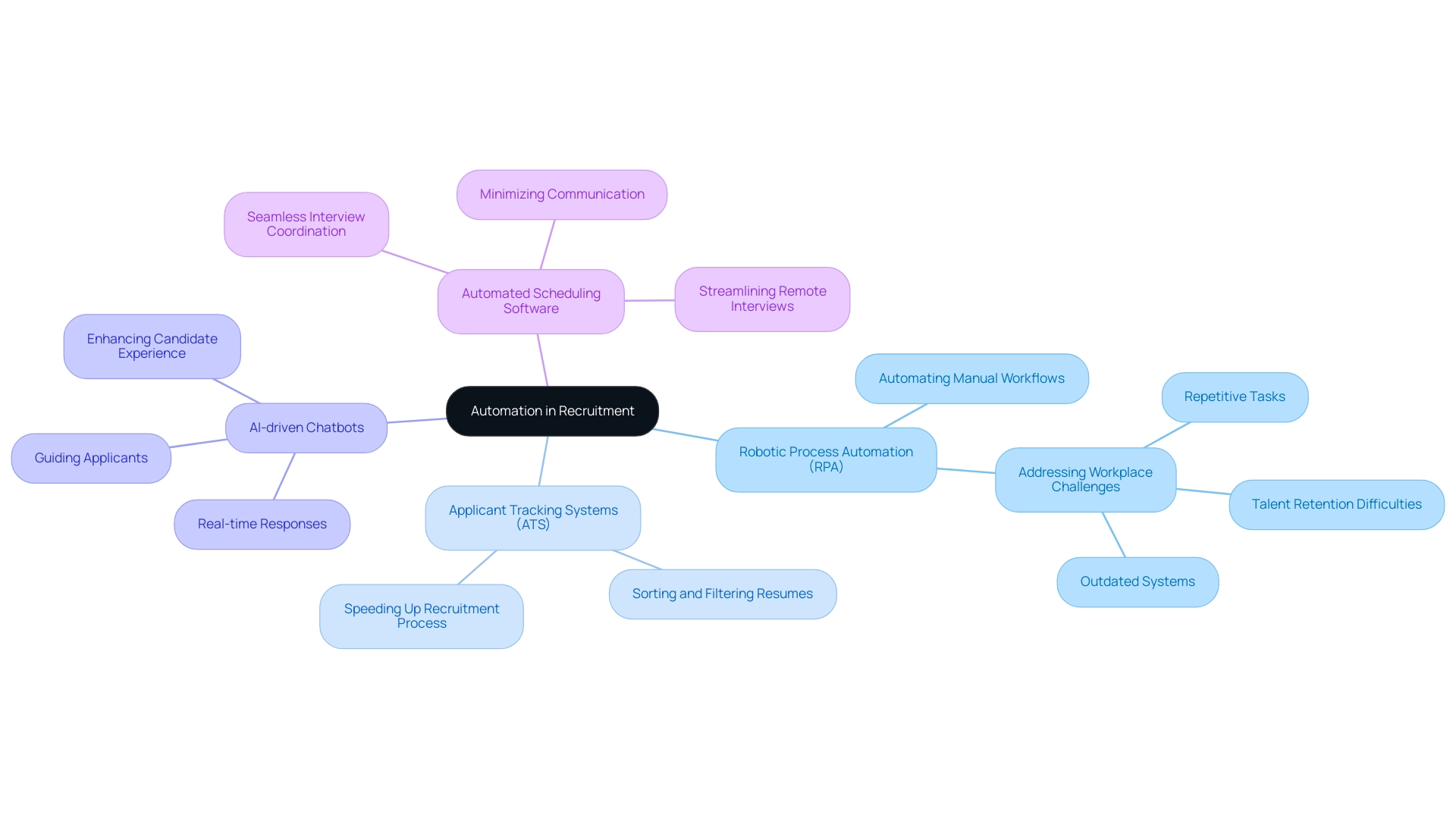
Challenges in Implementing Automated Hiring
Implementing automation hiring can unlock considerable advantages, yet organizations often face hurdles in the process. One significant challenge is employee resistance to change, as many workers may feel threatened by new technologies or doubt the reliability of automated systems. However, leveraging Robotic Process Automation (RPA) can streamline these workflows, enhance operational efficiency, reduce errors, and free up team resources for more strategic, value-adding work.
Additionally, the successful integration of automated processes requires alignment with the overall hiring strategy and company culture. As Robert Half points out,
With 90% of tech hiring managers reporting difficulties in finding skilled candidates, companies are increasingly turning to contract workers to fill critical roles and maintain flexibility in their workforce.
Significantly, 25% of companies are intending to adopt an AI-driven applicant tracking system (ATS) by 2027, highlighting the shift towards automation hiring.
To effectively navigate these challenges, fostering a culture of openness and collaboration is crucial. Providing comprehensive training and support empowers employees to embrace new technologies, ultimately leading to a smoother transition and enhanced operational efficiency. Furthermore, HR managers can conduct audits to identify resource-intensive processes within the HR department, such as hiring, payroll, and performance management.
By targeting these processes for automation hiring, organizations can enhance efficiency and streamline workflows. Additionally, Business Intelligence can play a pivotal role in transforming raw data into actionable insights, enabling informed decision-making that drives growth and innovation. As pay transparency grows more significant in job postings and hiring procedures, tackling these issues proactively will be essential in preserving a competitive advantage in talent acquisition.
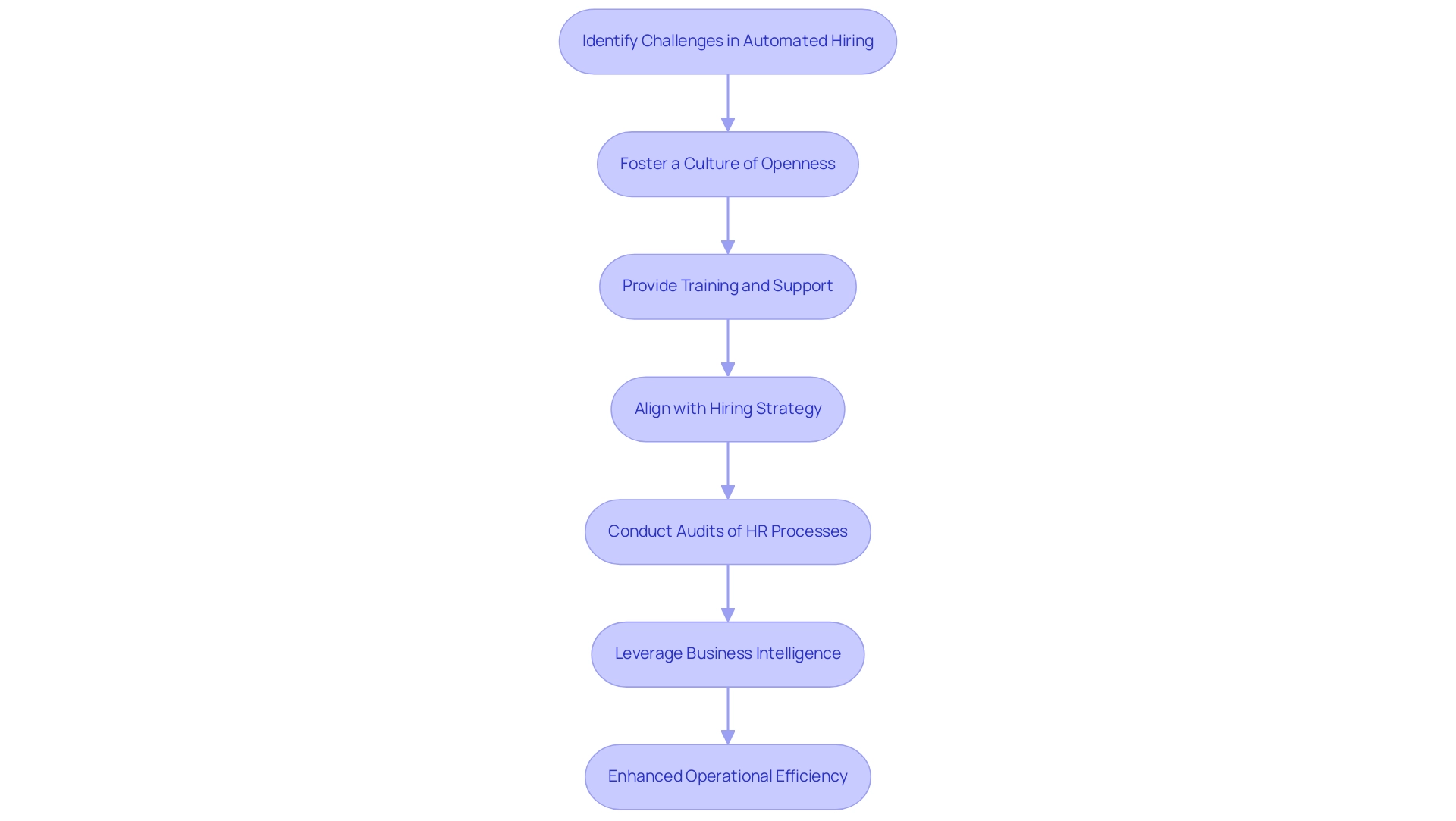
The Future of Recruitment: Trends in Automation
The recruitment landscape is on the brink of a significant evolution, driven by advancements in automation hiring, especially through technologies like Robotic Process Automation (RPA) and artificial intelligence. Key trends shaping this future include the growing reliance on AI for predictive analytics, which not only enhances candidate sourcing but also improves the alignment of candidates with job openings. By examining billions of data points from platforms like LinkedIn, organizations are increasingly adopting data-driven approaches that enhance their recruitment strategies.
This shift is particularly crucial in addressing hiring challenges posed by remote work; with 60% of remote workers reporting feelings of isolation, companies must proactively engage talent to maintain a strong company culture. Furthermore, leveraging RPA can streamline manual workflows, reduce errors, and free up teams to focus on strategic initiatives, ultimately boosting efficiency. In this competitive environment, those that embrace automation hiring and tailored AI solutions will attract and retain top talent more effectively.
Nicky Vallelly, a talent acquisition leader at Google DeepMind, underscores this necessity:
I’m encouraging my team to actively explore and experiment with AI tools to optimize our hiring practices.
By strategically integrating AI and RPA into automation hiring strategies, companies can enhance operational efficiency while fostering diverse and innovative teams as we approach 2024. Additionally, as the AI landscape rapidly evolves, organizations must remain agile and responsive to effectively navigate the associated challenges.
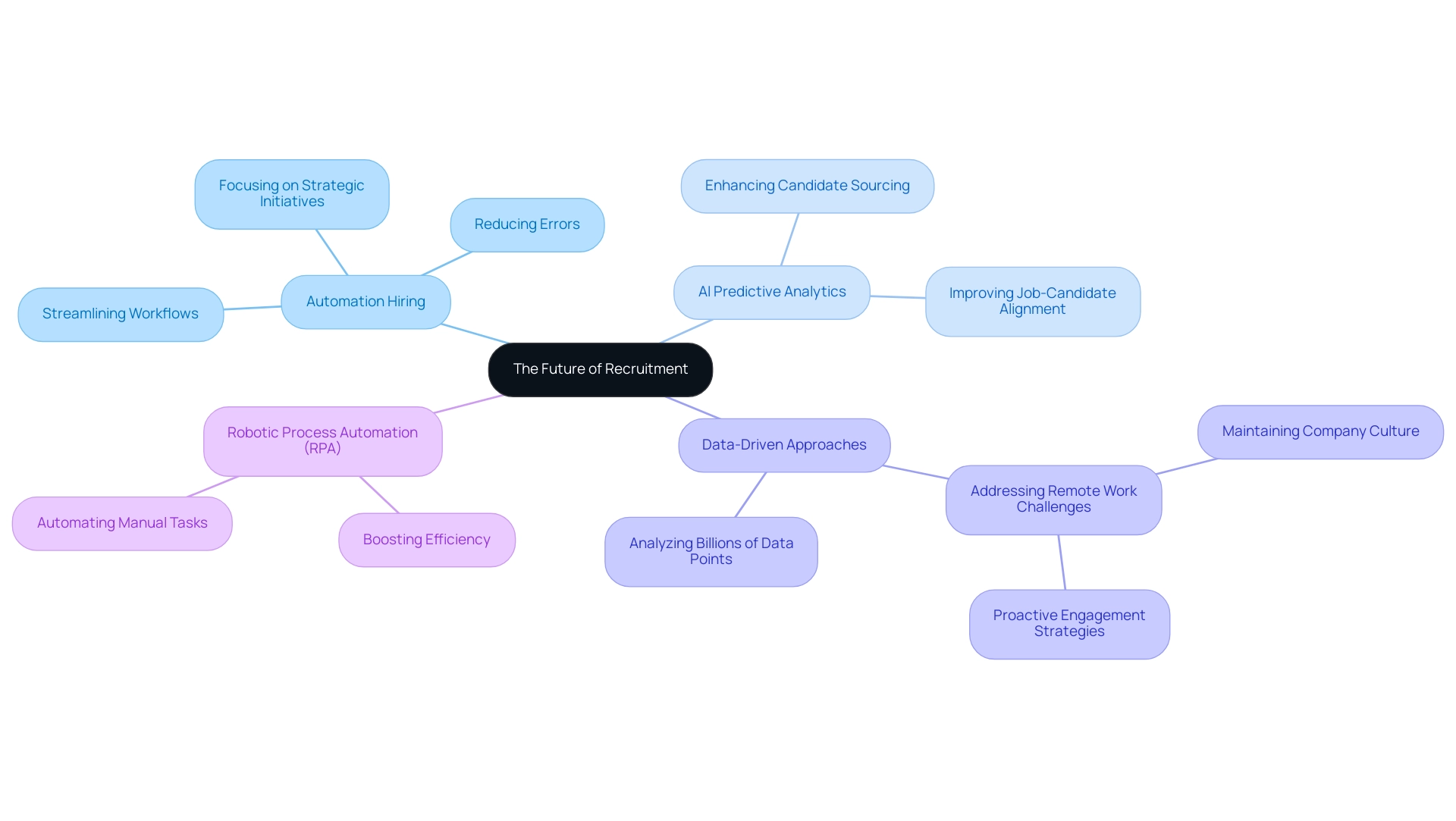
Conclusion
Adopting automated hiring processes is not just an innovation; it’s a strategic necessity in today’s competitive landscape. By implementing technologies such as Robotic Process Automation (RPA) and AI-driven tools, organizations can:
- Streamline recruitment
- Reduce bias
- Significantly enhance the candidate experience
The integration of these technologies not only accelerates hiring but also allows HR teams to redirect their focus toward strategic initiatives that foster a more inclusive and diverse workplace.
However, the journey toward automation is not without its challenges. Employee resistance and the need for alignment with company culture can pose significant hurdles. Yet, by fostering a culture of openness and providing adequate training, organizations can empower their teams to embrace these changes, ultimately leading to improved operational efficiency and job satisfaction.
Looking ahead, the future of recruitment is undeniably intertwined with automation and data-driven strategies. As organizations increasingly rely on AI for predictive analytics and sourcing, those that adapt will have a competitive edge in attracting and retaining top talent. By staying agile and responsive to changes in the recruitment landscape, businesses can not only enhance their hiring processes but also cultivate innovative and diverse teams that drive growth and success in an ever-evolving market. Embracing this transformation is essential for organizations aiming to thrive in the digital age.
Introduction
In the dynamic landscape of modern business, organizations are increasingly turning to Robotic Process Automation (RPA) as a vital tool for enhancing operational efficiency and productivity. By employing intelligent software robots to automate repetitive tasks, businesses can free their workforce from mundane activities, allowing employees to focus on higher-value initiatives that drive growth and innovation.
This article delves into the transformative power of RPA, exploring its applications across various sectors, the tangible benefits it offers, and critical considerations for successful implementation.
With the rapid adoption of RPA solutions, understanding how to leverage this technology effectively can position organizations for success in an increasingly automated world, ensuring they remain competitive and agile in the face of evolving market demands.
What is Robotic Process Automation (RPA)?
Robotic Process Automation (RPA) functionality is a transformative technology that utilizes software robots, or ‘bots’, to automate repetitive and rule-based tasks traditionally performed by humans. These bots are created to mimic human actions in digital settings, effectively managing a range of tasks, from entry to transaction processing. The significance of RPA in the modern business landscape is profound; it not only dramatically reduces the time spent on mundane activities but also significantly minimizes the errors that often accompany manual processes.
For instance, a recent case study highlights how a mid-sized healthcare company faced challenges such as manual information entry errors, slow software testing, and difficulty integrating outdated systems without APIs. By employing GUI processes, they streamlined operations, resulting in a 70% reduction in data entry errors and an 80% improvement in overall workflow efficiency. With projections indicating that robots could take over as much as 20% of current routine tasks and potentially handle 52% of work capacity, organizations that utilize RPA functionality can substantially enhance their productivity.
Furthermore, SMEs are projected to adopt RPA solutions at a remarkable growth rate of 25% annually, signaling a robust market trend. This shift allows employees to redirect their focus toward more strategic initiatives that drive value within their operations. A recent study shows that 91% of employees think that mechanization saves time and enhances work-life balance, with 89% indicating increased job satisfaction because of mechanization.
Moreover, customized AI solutions and Business Intelligence play a significant role in this context, as they help businesses extract meaningful insights from information, further enhancing decision-making processes. As indicated in the Deloitte Global RPA Survey, over 90% of C-level executives utilizing intelligent processes believe their entities excel at managing change in response to evolving business trends. As businesses navigate the complexities of today’s market, the implementation of RPA functionality stands out as a critical strategy for boosting operational efficiency while fostering a more engaged and satisfied workforce.
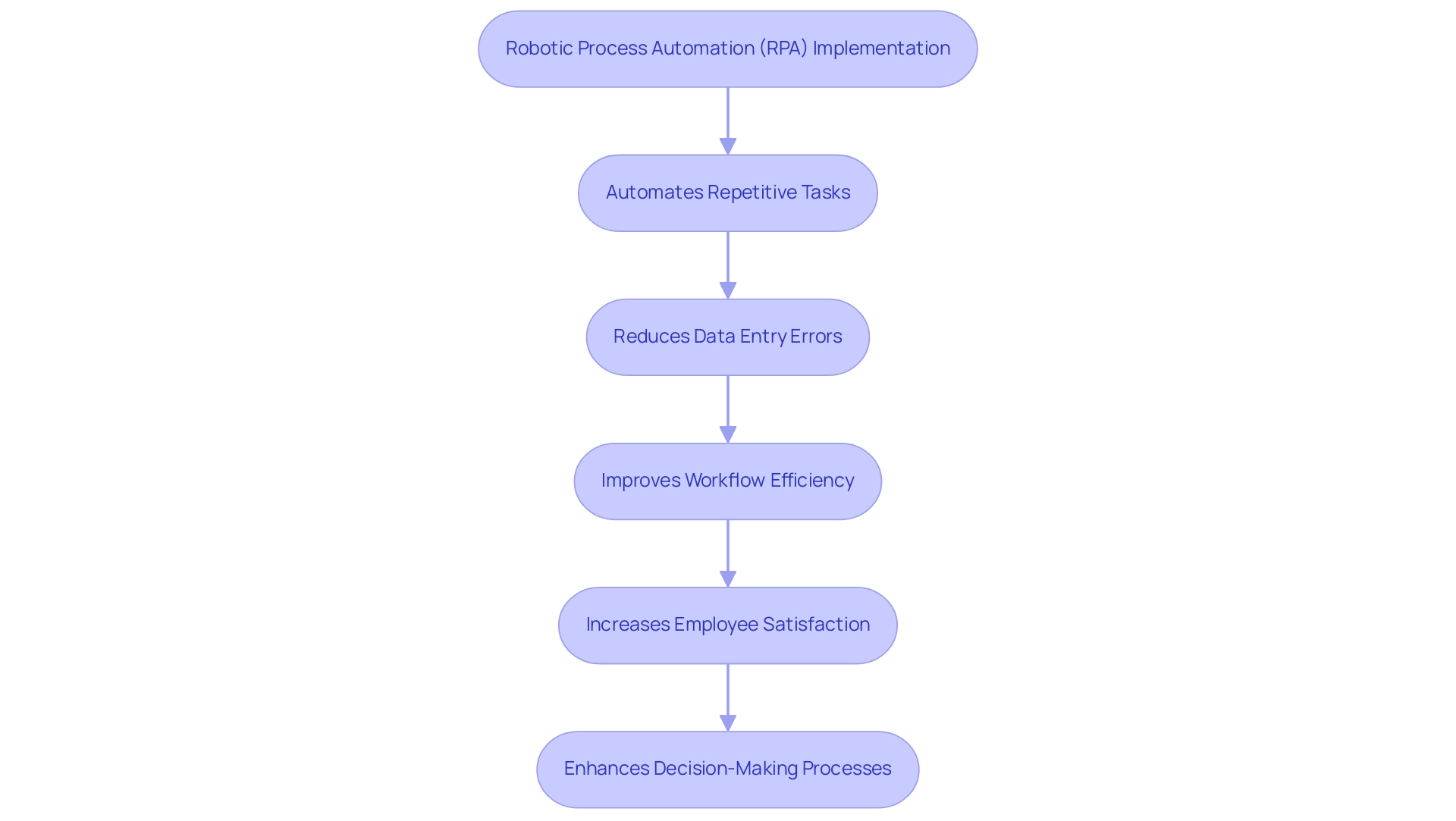
Applications and Use Cases of RPA in Business
The functionality of Robotic Process Automation (RPA) offers transformative potential across various sectors and processes, enhancing operational efficiency and employee morale through innovative tools such as EMMA RPA and Microsoft Power Automate. By addressing challenges like staffing shortages and outdated systems, the RPA functionality of RPA solutions can significantly alleviate task repetition fatigue. Here are some of the most impactful applications:
- Information Entry and Processing: The RPA functionality simplifies the mechanization of input from various sources into a centralized system, minimizing errors and significantly decreasing the time employees spend on these tasks.
- Invoice Processing: RPA functionality in this area allows entities to automatically extract information from invoices, which is then swiftly entered into accounting systems, streamlining financial operations and enhancing precision.
- Customer Service: By utilizing RPA functionality to deploy bots for managing routine customer inquiries, businesses can free up human agents to focus on complex issues, ultimately enhancing customer satisfaction and service quality.
- HR Onboarding: The RPA functionality simplifies the onboarding process for new employees, automating everything from documentation collection to payroll setup, ensuring a seamless experience for new hires while reducing the administrative burden on HR teams.
- Compliance Reporting: Streamlining the collection and formatting of data for compliance reports enhances RPA functionality, which reduces the risk of non-compliance while conserving valuable time otherwise used for manual reporting activities.
The adoption of RPA functionality is increasing, with 76% of entities enhancing their process improvement initiatives, particularly after the Covid-19 pandemic. 98% of IT leaders affirm that the RPA functionality in automating business processes is vital for driving business benefits. According to the Slack State of Work Report, automation enables workers to save an average of 3.6 hours per week.
The global RPA software market has also seen significant growth, expanding from $2.6 billion in 2022 to $3.2 billion in 2023, reflecting a growth rate of 22.1%. By implementing RPA functionality, companies can not only improve operational efficiency but also reduce costs and enhance overall productivity, thereby positioning themselves for success in an increasingly automated world. This integration of robotics in the workplace emphasizes collaboration between humans and machines, as illustrated by the stylized image of a human figure working alongside robotic figures.
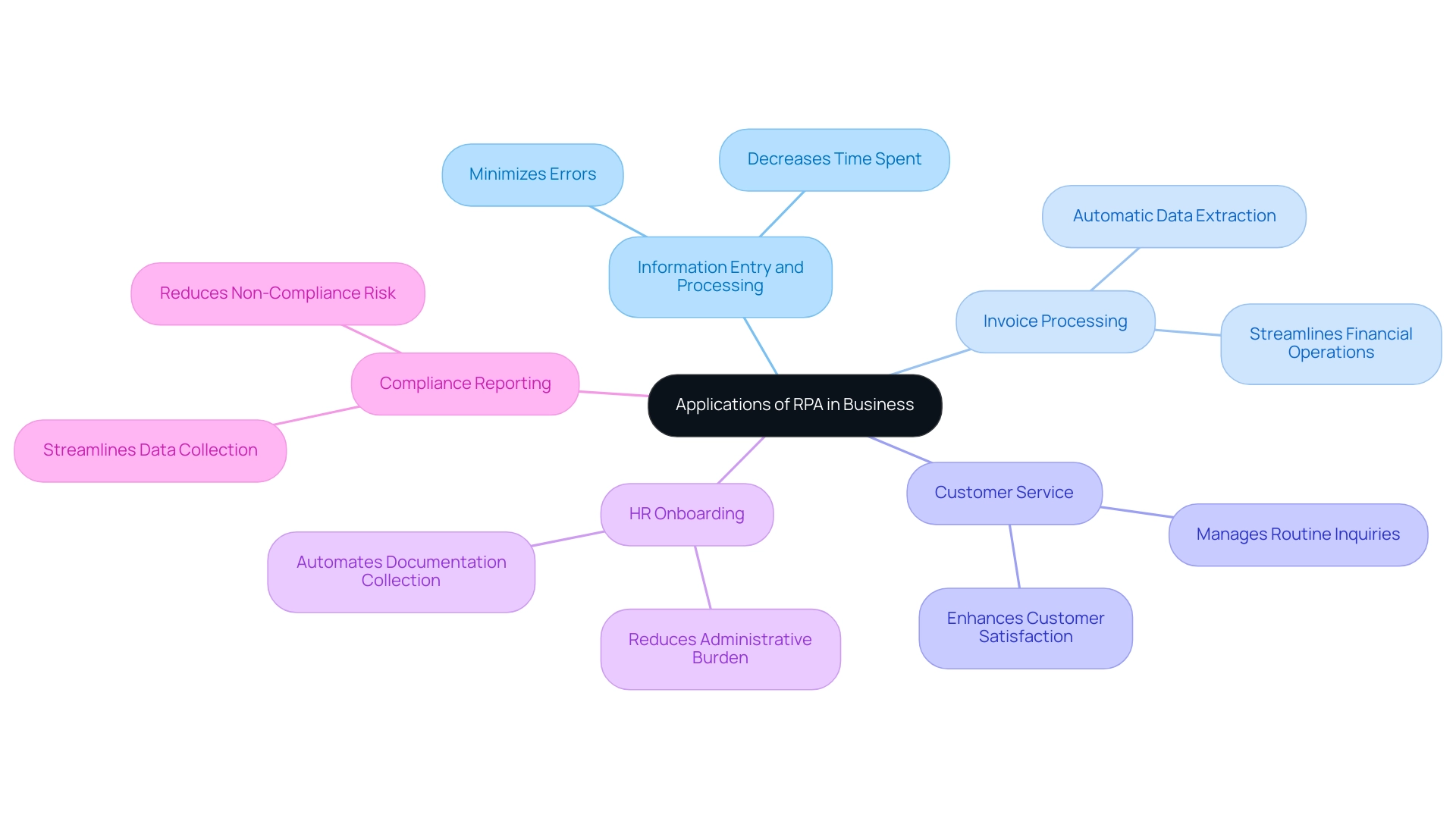
Benefits of Implementing RPA
Implementing Robotic Process Automation (RPA) offers a multitude of advantages for businesses, each contributing to operational excellence and strategic growth:
-
Increased Efficiency: RPA can execute tasks at speeds beyond human capabilities, resulting in remarkable time savings. As highlighted in recent research, entities that have adopted mechanization report significant efficiency improvements, with 76% of companies speeding up their RPA efforts after Covid-19. This automation not only streamlines workflows but also enhances overall productivity, enabling teams to focus on value-adding activities.
-
Cost Reduction: Automating repetitive tasks significantly lowers labor expenses, enabling companies to allocate resources to more strategic initiatives. In 2024, companies utilizing RPA are projected to see notable cost savings, reinforcing its role as a catalyst for financial efficiency. As noted by industry experts, organizations that utilize RPA functionality can expect to reduce operational costs by up to 30%, enabling reinvestment in growth-oriented projects.
-
Enhanced Precision: By reducing human mistakes, RPA improves information accuracy and process quality. This improved precision not only streamlines operations but also strengthens compliance with regulatory standards, a crucial aspect for organizational integrity. Furthermore, leveraging Business Intelligence alongside RPA functionality can transform raw data into actionable insights, making informed decision-making a reality.
-
Scalability: RPA solutions provide remarkable scalability, allowing businesses to handle greater workloads without a corresponding rise in staffing expenses. This flexibility is particularly beneficial in industries facing fluctuating demands, allowing for seamless adjustments to operational capacities.
-
Enhanced Compliance: RPA ensures consistent execution of processes in line with regulatory requirements, thereby bolstering compliance efforts. The establishment of standards by industry bodies underscores the importance of best practices in RPA implementation. As these standards evolve, entities will find it increasingly critical to align their RPA functionality with these guidelines to ensure compliance and security. Furthermore, the difficulties of pinpointing the appropriate AI solutions can hinder this alignment, making it crucial for entities to seek customized solutions that suit their specific needs.
-
Employee Satisfaction: By relieving employees of mundane, repetitive tasks, RPA empowers them to focus on more meaningful work, leading to improved job satisfaction and morale. As companies recognize the value of their workforce, this shift can lead to a more engaged and productive team.
Deloitte highlights that, despite the clear benefits, only 3% of entities have scaled their digital workforce, indicating a significant opportunity for growth and optimization through RPA functionality. This statistic reflects the untapped potential of RPA as a strategic initiative, with 53% of respondents having initiated their RPA journey and another 19% planning to do so within two years. As RPA continues to gain traction, its implementation will increasingly define operational efficiency in 2024 and beyond.
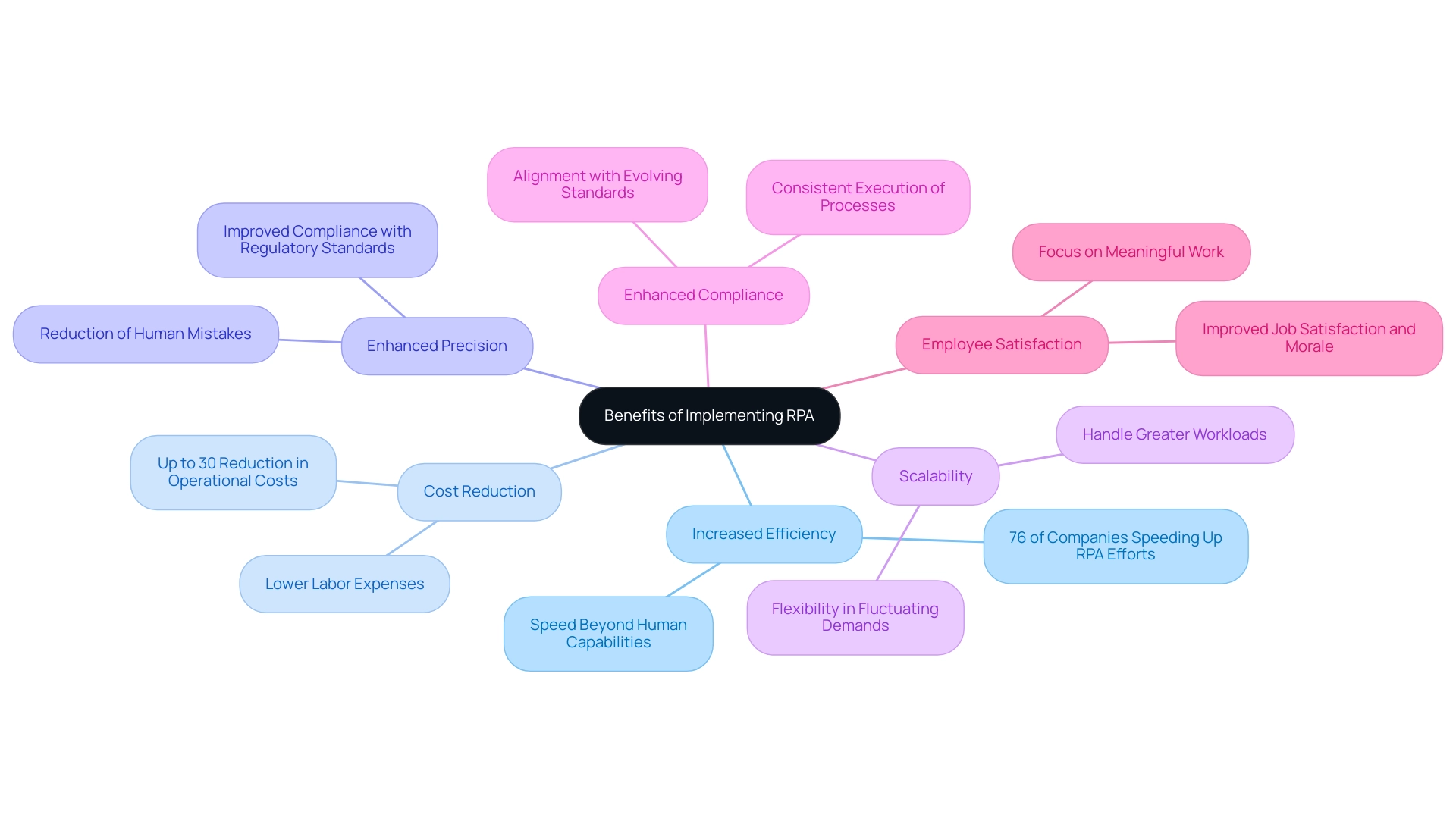
Key Considerations for RPA Implementation
When embarking on RPA implementation, organizations must carefully consider several key factors pertaining to RPA functionality to ensure success.
-
Process Suitability: Concentrate on recognizing processes that are rule-based, repetitive, and high-volume, as these present the greatest potential for mechanization. For instance, the RPA functionality can adeptly manage up to 90% of data entry tasks in clinical research, as highlighted by ClaySys Technologies, showcasing its effectiveness in suitable environments.
-
Change Management: Addressing the cultural transition is crucial. Communicate the advantages of RPA clearly and involve employees in the change process to foster a more inclusive atmosphere. Significantly, a survey showed that 91% of employees believe that mechanization saves time and improves their work-life balance, leading to 89% indicating greater job satisfaction.
This aligns with our commitment to combatting repetitive tasks and improving talent retention by creating a more engaging workplace. It’s essential to recognize that many employees experience exhaustion from these repetitive tasks, which makes RPA functionality a vital solution.
- Technology Integration: Ensure that RPA tools can integrate seamlessly with existing systems and applications.
This integration is vital for maximizing efficiency and minimizing disruption during the transition. In scenarios where entities are hindered by outdated systems, implementing RPA solutions with RPA functionality can significantly enhance operational flow.
- Governance and Compliance: Establish a robust governance framework to oversee RPA initiatives, ensuring adherence to regulations and best practices.
This oversight is crucial to reduce risks linked to automated systems, and our risk-free ROI-driven services ensure you only pay for successfully automated processes.
- Continuous Improvement: Adopt a mindset that views RPA as an ongoing journey rather than a one-off project. Regularly evaluate performance metrics and actively seek enhancement opportunities to adapt to evolving business needs and technological advancements.
As RPA functionality evolves, particularly with the integration of AI and machine learning, organizations must be prepared to leverage these future trends effectively. Furthermore, with 65% of respondents from the Robocorp 2022 RPA survey indicating they would benefit from usage-based pricing, financial considerations also play a crucial role in RPA strategy. Our proven client results illustrate how GUI technology has significantly enhanced operational efficiency, reducing data entry errors by 70% and accelerating testing processes by 50%, thereby revolutionizing procedures in various industries.
This aligns with our promise that you only pay if we deliver on the automation as planned.
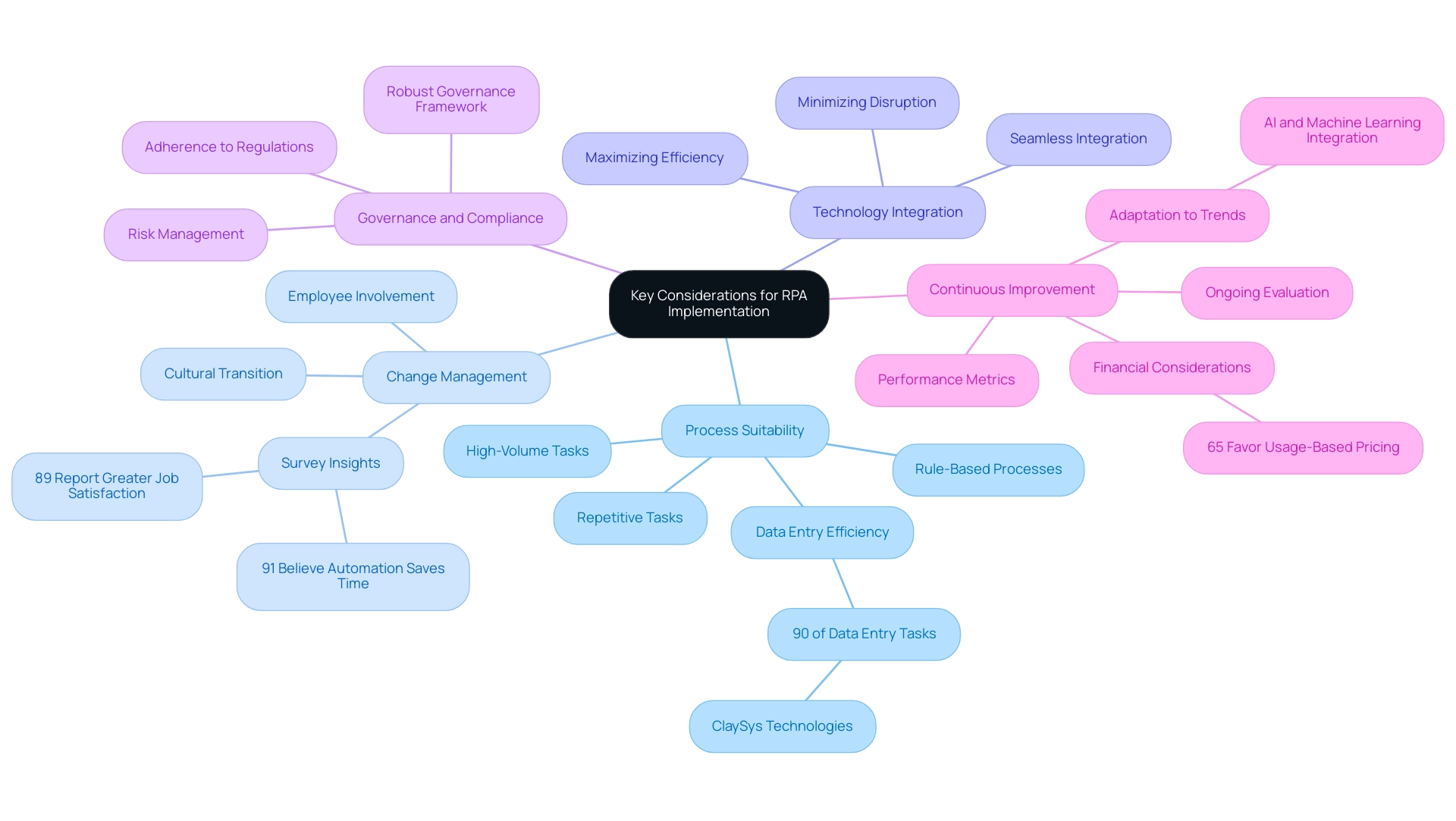
Measuring the Success of RPA Initiatives
To effectively measure the success of RPA initiatives and enhance operational efficiency, especially in healthcare settings, entities should focus on the following key performance indicators (KPIs):
-
Challenges Faced:
Prior to implementing RPA, the mid-sized company struggled with manual information entry errors, slow software testing, and difficulties in integrating outdated systems without APIs. These challenges hindered operational efficiency and necessitated a solution. -
Time saved through RPA functionality:
By utilizing RPA functionality to automate tasks such as information entry and software testing, companies can quantify the time conserved compared to conventional manual execution, demonstrating significant efficiency enhancements. For instance, in a case study, a mid-sized company achieved a 50% acceleration in testing processes through GUI automation. -
Cost Savings:
Assess the reduction in operational expenses from RPA, including labor cost savings and minimized costs associated with errors. The case study reported a 70% reduction in data entry errors, translating into substantial cost savings. -
Accuracy Improvement:
Monitor the decline in error rates post-automation. Many organizations have noted a drop in order processing errors from 5% to less than 1%, showcasing the effectiveness of RPA functionality in enhancing accuracy, similar to improvements observed in healthcare service delivery. -
Employee Productivity:
Evaluate whether employees can devote more time to high-value tasks due to RPA implementation, fostering a more innovative work environment. The case study highlights that mechanization enabled staff to concentrate on strategic initiatives instead of manual tasks. -
Process Throughput:
Measure the increase in the volume of work completed due to automation, reflecting enhanced operational efficiency. In the healthcare case study, workflow efficiency improved by 80%, demonstrating the impact of RPA.
By consistently evaluating these metrics, entities not only ensure their RPA functionality provides tangible value but also align with broader business objectives. As Bart Teodorczuk, RPA Tech Lead at Flobotics, states, ‘Our team, sourced only from the ‘Big Four’ of accounting, will analyze your processes and current RPA setup and recommend the metrics and KPIs best suited for your business goals and needs.’ This tailored approach highlights the importance of aligning KPIs with specific business goals, helping organizations track time saved effectively and maximize the RPA functionality of their investments.
Notably, some clients have reported an astonishing ROI as high as 300,000%, illustrating the financial benefits of successful RPA implementation. Additionally, measuring and assessing robot utilization rates, as highlighted in the case study titled ‘Robot Utilization Metrics,’ is crucial for optimizing automation tools, ensuring better task allocation and workload distribution.
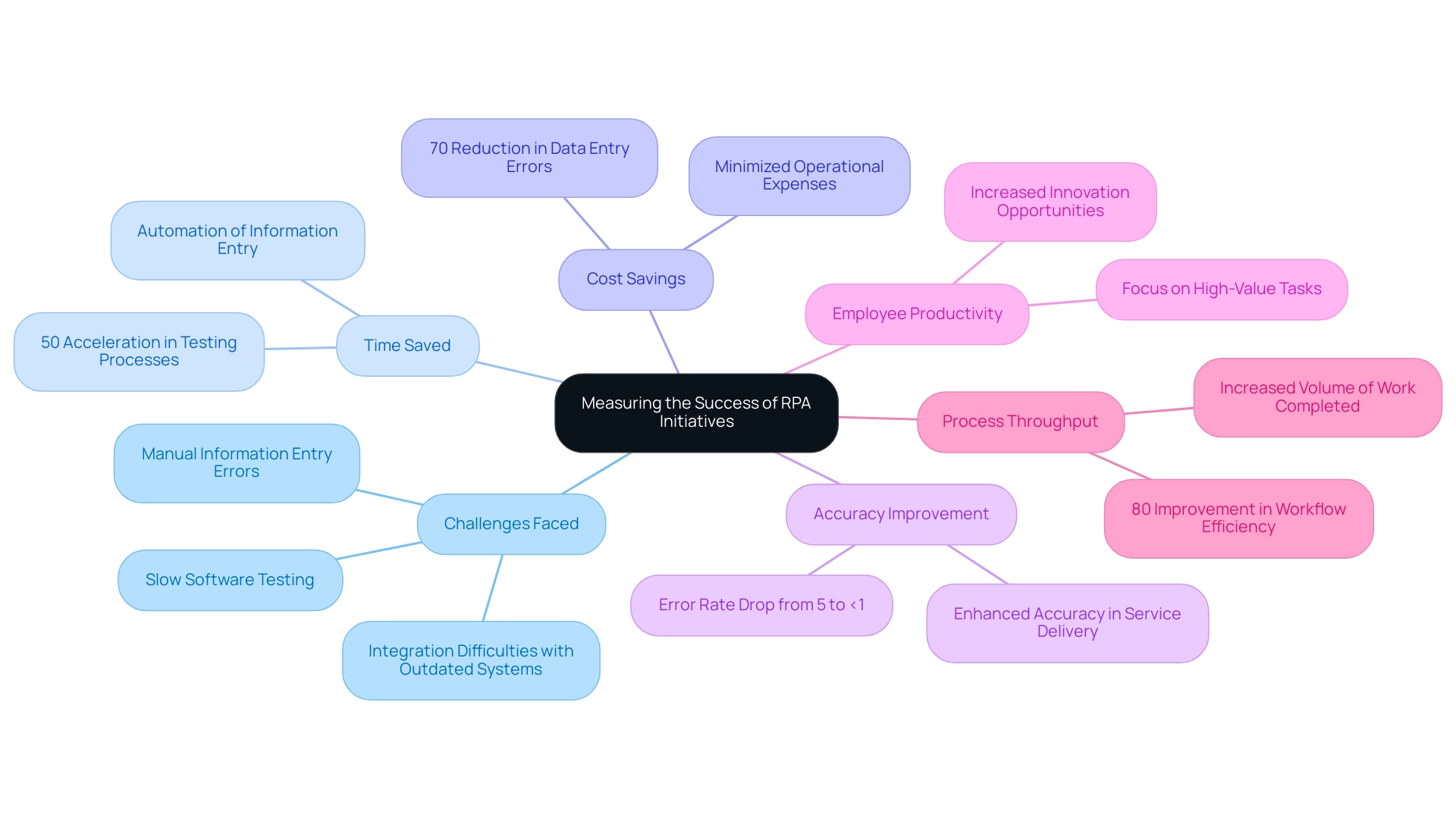
Conclusion
Embracing Robotic Process Automation (RPA) is no longer just a strategy for efficiency; it has become a cornerstone for operational excellence across diverse industries. As explored throughout this article, RPA significantly enhances productivity by automating repetitive tasks, allowing organizations to allocate valuable human resources to more strategic initiatives. From data entry to customer service, the applications of RPA are vast and impactful, with measurable benefits including reduced errors, improved accuracy, and substantial cost savings.
The advantages of implementing RPA extend beyond immediate operational improvements. Organizations that adopt RPA can expect increased employee satisfaction as team members are liberated from mundane tasks and empowered to engage in more meaningful work. This shift not only boosts morale but also fosters a culture of innovation and continuous improvement, essential for thriving in today’s competitive landscape.
However, successful RPA implementation requires careful consideration of various factors, including:
– Process suitability
– Change management
– Governance
By addressing these aspects strategically, organizations can ensure a smooth transition to automated processes and maximize the potential of their digital workforce. As the market continues to evolve, those who invest in RPA will position themselves at the forefront of operational efficiency, ready to adapt to the demands of an increasingly automated world. The time to act is now—leveraging RPA can redefine success and propel organizations towards a more productive and innovative future.
Introduction
In a rapidly evolving business landscape, the quest for efficiency and productivity has led organizations to explore innovative solutions that transcend traditional automation.
Enter hyperautomation—a game-changing approach that combines advanced technologies like:
- Artificial intelligence
- Robotic process automation
- Machine learning
to streamline entire workflows rather than just isolated tasks. This comprehensive strategy not only addresses common operational challenges such as:
- Poor data quality
- Employee resistance
but also empowers businesses to adapt and thrive in a competitive environment. As companies increasingly recognize the tangible benefits of hyperautomation, from enhanced accuracy to significant cost savings, understanding its implementation and potential impact becomes essential for leaders aiming to drive strategic growth and operational excellence.
Understanding Hyperautomation: Definition and Scope
Hyperautomation technologies signify a revolutionary method in business operations, integrating advanced technologies like artificial intelligence (AI), robotic task management, machine learning, and workflow analysis to streamline intricate tasks. Unlike conventional mechanization, which typically targets specific tasks, hyperautomation technologies aim to streamline entire processes, significantly enhancing efficiency and productivity across the organization. Many organizations struggle with poor master data quality, characterized by inconsistent, incomplete, or inaccurate data, which can lead to inefficient operations and flawed decision-making.
Additionally, there is often a reluctance to adopt AI due to perceptions of complexity and cost. Hyperautomation technologies tackle these challenges by integrating various technologies for a cohesive and adaptable end-to-end process that evolves with business needs. A striking statistic from 2020 reveals that 384,000 new robots were sold worldwide, reflecting a 0.5% rise and indicating the increasing adoption of technology.
Moreover, more than one-third (35%) of small and medium enterprises attribute enhanced customer service and support capabilities to hyperautomation technologies, highlighting the concrete advantages that this approach can provide (Zapier). A notable case study is the implementation of GUI automation in a mid-sized company, which faced significant issues with manual information entry mistakes and slow software testing methods prior to automation. By automating these tasks, the company accomplished a 70% decrease in entry mistakes and a 50% speed-up in testing procedures.
As organizations increasingly embrace these advanced solutions, understanding and addressing the challenges of data quality becomes a compelling driver for strategic growth.
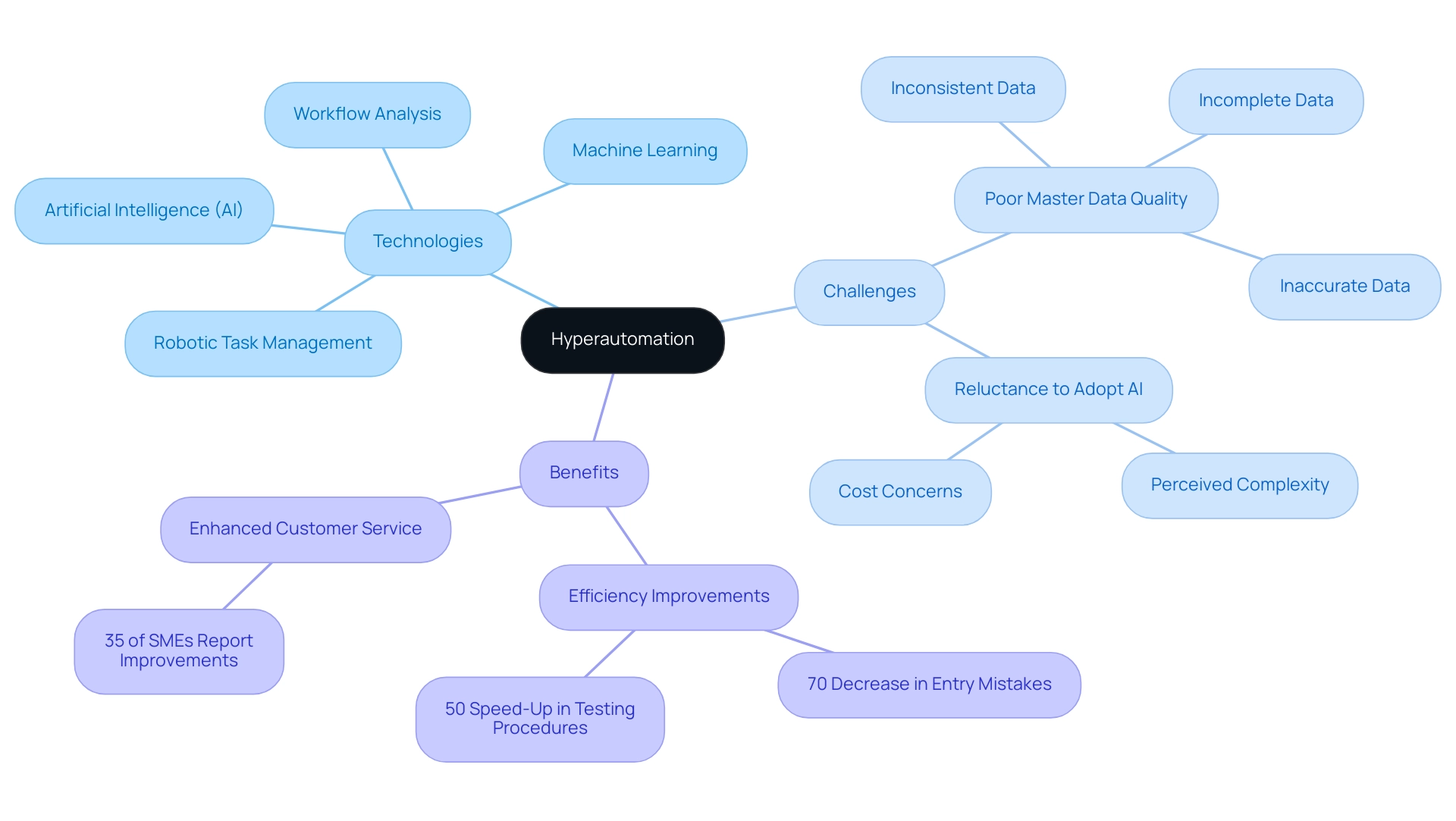
Key Technologies Powering Hyperautomation
Hyperautomation technologies are powered by a suite of advanced technologies that work synergistically to enhance operational efficiency. Among these, Robotic Process Automation (RPA) stands out as a key driver, automating repetitive tasks and streamlining processes, thereby enabling organizations to save time and reduce errors. RPA solutions such as EMMA RPA, crafted for seamless integration and user-friendly processes, and Microsoft Power Automate, which provides robust workflow capabilities, not only enhance employee morale by reducing task repetition fatigue but also tackle staffing shortages and outdated systems.
Remarkably, a considerable 74% of individuals utilizing robotic tools indicate finishing tasks more quickly, highlighting the efficiency improvements from embracing RPA.
Artificial Intelligence (AI) is essential in enhancing decision-making and predictive analytics, enabling more intelligent automated solutions that constantly learn and adjust to new information. This involves using Small Language Models and participating in GenAI Workshops to improve information quality and deliver effective training.
Process Mining provides essential insights into current workflows, enabling organizations to pinpoint inefficiencies and areas ready for enhancement. This capability is essential as businesses acknowledge the significance of addressing operational challenges and skill gaps. Furthermore, Machine Learning is another cornerstone of advanced automation, enabling systems to learn from vast amounts of data, thereby enhancing the accuracy and efficiency of automated processes.
Natural Language Processing (NLP) also improves human-computer interactions, making automated solutions more intuitive and user-friendly.
These technologies, known as hyperautomation technologies, collectively create a strong framework for advanced processes, essential for addressing various operational challenges in today’s rapidly evolving business landscape. Common implementation challenges, such as resistance to change and integration with legacy systems, can be effectively mitigated through RPA solutions, leading to a smoother transition and enhanced operational performance. As Yana Pokora, Content Manager at Flobotics, aptly states,
We hope this list of RPA stats has convinced you that mechanization is the next step you should take to enhance the overall efficiency of your business.
With the cloud sector anticipated to exceed a revenue share of 9% in 2022, and the RPA market in India predicted to expand at a CAGR of 44.6% from 2023 to 2030, it is evident that the momentum behind advanced automation is only set to increase. Furthermore, key players in the RPA market, such as UiPath Inc, Blue Prism Group PLC, and Automation Anywhere Inc, are driving innovation and adoption across industries, highlighting the growing significance of automation in improving operational efficiency.
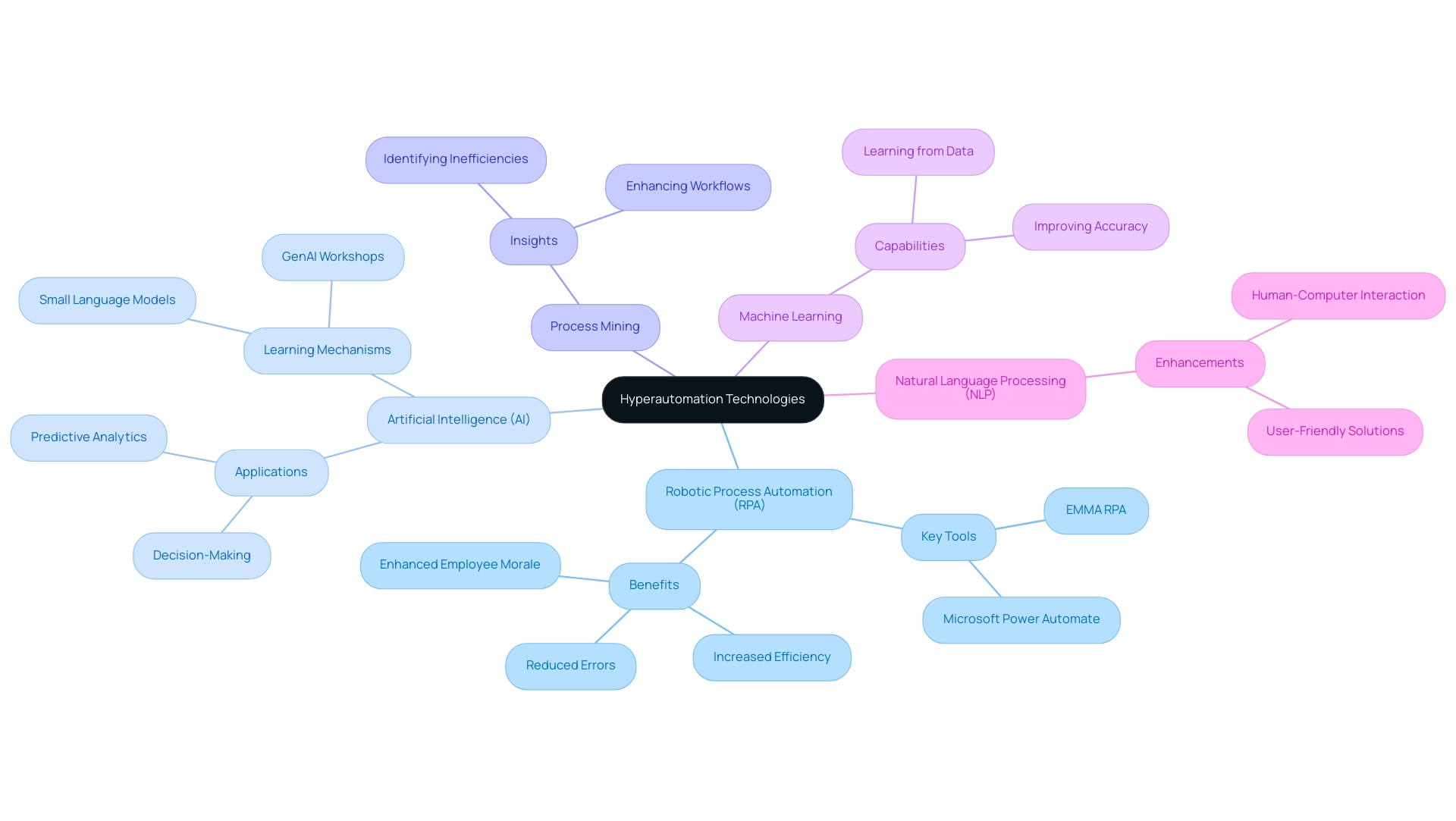
Benefits of Implementing Hyperautomation
The implementation of hyperautomation technologies offers a multitude of benefits that can transform organizational operations. Firstly, Increased Efficiency is paramount; by automating end-to-end processes through technologies like Robotic Process Automation (RPA), businesses can significantly reduce cycle times and enhance throughput. This is critical in a landscape where speed and responsiveness define competitive advantage.
A significant example is found in the retail sector, where cognitive processes analyze customer behavior, personalizing experiences that not only enhance engagement and satisfaction but also elevate purchase likelihood, ultimately driving revenue growth. Such innovations contribute to broader business competitiveness. Secondly, Cost Savings play a crucial role, as mechanization effectively reduces labor costs linked to manual and repetitive tasks.
This leads to substantial financial savings over time, allowing organizations to reallocate resources strategically. Statistics indicate that more than 60% of businesses currently outsource marketing processes, showcasing a trend toward optimizing operational efficiency through tailored AI solutions. Gartner emphasizes that 83% of respondents anticipate ongoing expansion in technological processes, reflecting a clear path toward improved operational models and supporting the necessity for businesses to adopt such innovations.
Furthermore, Enhanced Accuracy is a significant advantage of hyperautomation technologies. By minimizing human error, processes are executed with remarkable precision and consistency, thereby improving overall quality and reliability. This accuracy fosters trust in operational outcomes, essential for maintaining customer satisfaction and loyalty.
Scalability is another compelling benefit; organizations can seamlessly scale operations without the need for corresponding increases in resources.
This adaptability is crucial as businesses navigate fluctuating market demands and seek to capitalize on evolving opportunities.
However, organizations face challenges when implementing automation, such as resistance to change, integration issues with existing systems, and the need for employee training. Addressing these challenges is essential for realizing the full benefits of hyperautomation technologies, and the impact on improved employee satisfaction cannot be overstated. By freeing employees from mundane tasks, advanced automation empowers them to engage in higher-value work, resulting in heightened job satisfaction and retention rates.
As organizations embrace advanced automation, these benefits collectively foster a more agile and competitive environment, positioning them for success in 2024 and beyond. As Gartner’s leading automation forecasts for 2023 indicate, the expansion in advanced automation will be essential for providing digital experiences that improve operational efficiency. For more insights on how tailored AI solutions can facilitate this journey, consider exploring our latest publication.
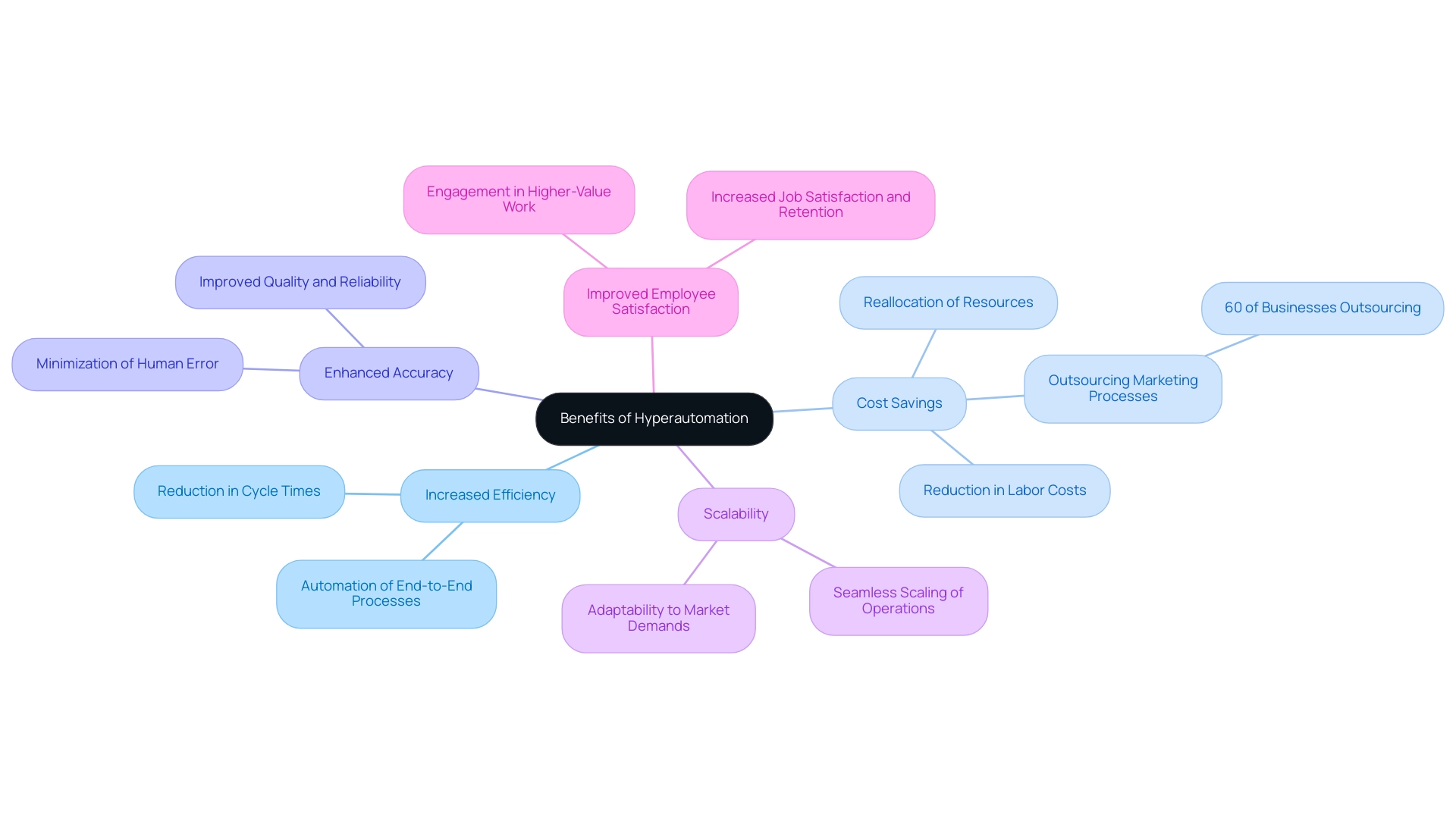
Challenges and Considerations in Hyperautomation
While advanced automation presents transformative opportunities for businesses, it also introduces several significant challenges that require careful navigation. One of the foremost issues is Change Management. Many employees may resist alterations to established workflows, making effective change management strategies essential for fostering acceptance and collaboration.
As reported by Gartner, the need for advanced automation is fueled by the requirement for operational excellence across activities and functions to enhance resilience. This highlights the necessity of not only implementing new technologies like Robotic Process Automation (RPA) to streamline manual workflows but also managing the human element effectively. Notably, 48% of companies are currently implementing hyperautomation technologies, underscoring the growing prevalence of automated systems.
The integration of various technologies can prove intricate, often consuming substantial time and resources. RPA can specifically tackle this by automating information transfer and workflow coordination between distinct systems, thereby diminishing the complexity and duration needed for integration. Organizations must plan meticulously to ensure seamless interoperability among systems.
Insights from the case study titled ‘Hyperautomation Trends 2024 and Beyond’ reveal that emerging trends, such as AI-driven process discovery and citizen development, are reshaping the business landscape, making effective integration strategies more crucial than ever.
Additionally, Information Privacy and Security cannot be overlooked; as automated processes frequently involve handling sensitive information, organizations must implement robust security measures to mitigate risks of breaches. Recent news regarding information privacy issues in automation highlights the urgency of addressing these concerns proactively. Leveraging Business Intelligence to transform raw data into actionable insights can play a pivotal role in informed decision-making and operational efficiency, especially in identifying vulnerabilities and ensuring compliance with data regulations. Lastly, companies often encounter skill gaps due to a shortage of skilled personnel capable of managing and optimizing hyperautomation technologies.
RPA can alleviate some of this burden by simplifying tasks and reducing the need for extensive technical expertise in certain areas. Addressing these challenges requires strategic planning and significant investment in training and development initiatives. Organizations that strategically navigate these hurdles not only enhance their operational efficiency with RPA but also position themselves for greater agility and customer focus in the evolving business landscape.
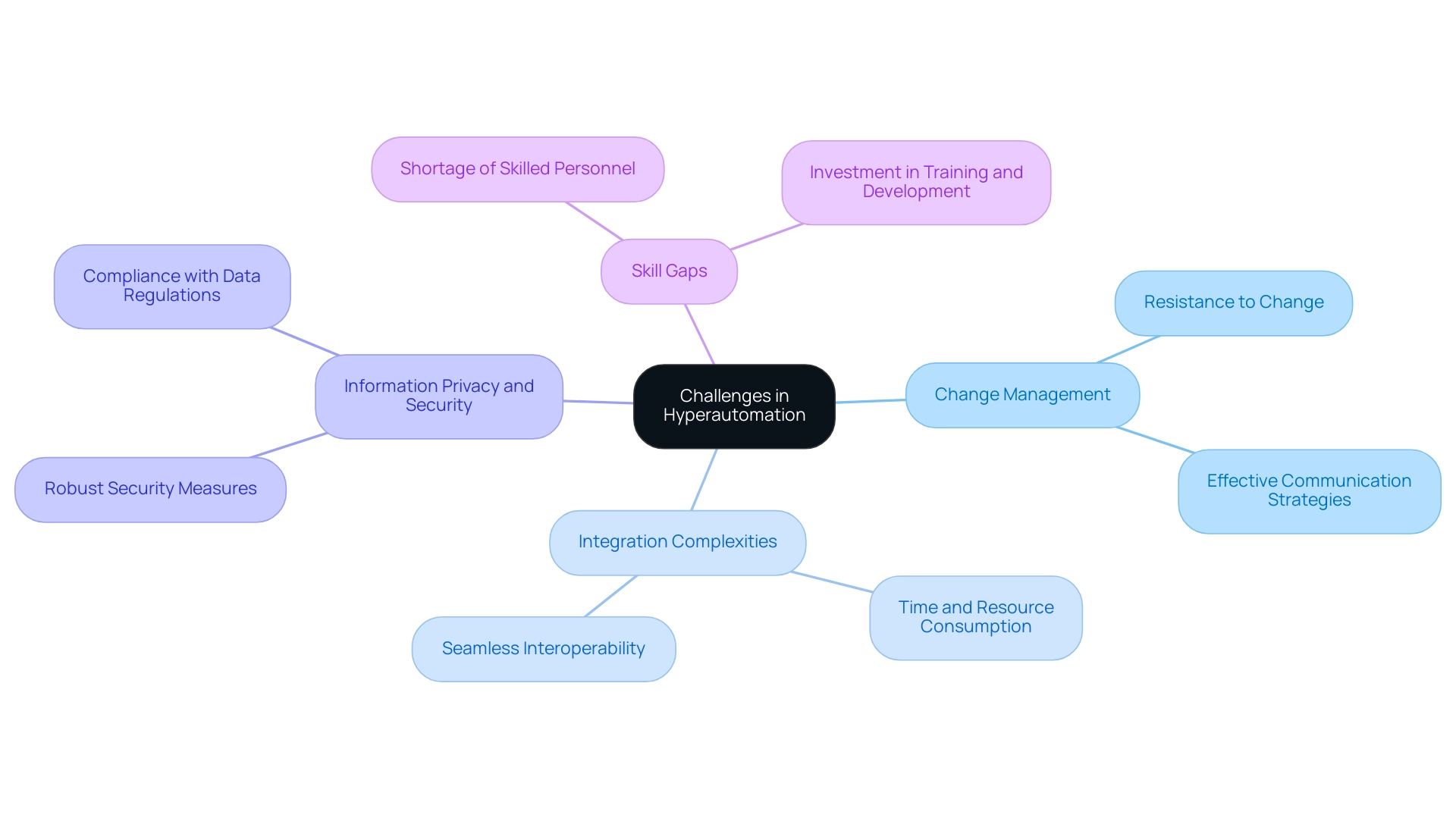
Real-World Applications of Hyperautomation in Various Industries
Hyperautomation technologies have surfaced as a transformative power across various industries, providing significant enhancements in operational efficiency and management. In the healthcare sector, for instance, a mid-sized company successfully implemented GUI automation to tackle challenges such as:
- Manual information entry errors
- Slow software testing
- Difficulty integrating outdated systems without APIs
By automating data tasks, they reduced data entry errors by 70%, sped up testing procedures by 50%, and enhanced overall workflow efficiency by 80%.
This not only enhanced patient care but also streamlined operations significantly. Furthermore, hospitals are utilizing advanced automation to manage patient records and streamline billing processes, which has been shown to enhance both patient care and operational effectiveness. Significantly, almost two-thirds of leaders, according to the Society of Actuaries, expect that predictive analytics will aid in lowering organizational expenses by 15% or more by 2023, highlighting the cost-saving possibilities of these technologies.
The automated processes market is also witnessing considerable growth, with a compound annual growth rate (CAGR) of 19.80%, indicating its rising importance across sectors. Manufacturers are leveraging the advantages of advanced automation, optimizing supply chain management and production scheduling to minimize waste and maximize output. A compelling case study titled ‘Hyperautomation in Manufacturing’ illustrates how smart factories utilize hyperautomation technologies for predictive maintenance and to effectively manage production needs, resulting in safer working environments and heightened operational efficiency.
In the retail sector, businesses are utilizing advanced automation for inventory management and creating personalized customer experiences, thus driving customer satisfaction and loyalty. These varied examples highlight the flexibility and significant nature of automated systems, demonstrating their potential to improve business operations across different sectors. Ultimately, the implementation of GUI robotics process and RPA as hyperautomation technologies has proven to be a game-changer, achieving a return on investment within six months, thereby reinforcing the importance of these technologies in driving operational efficiency.
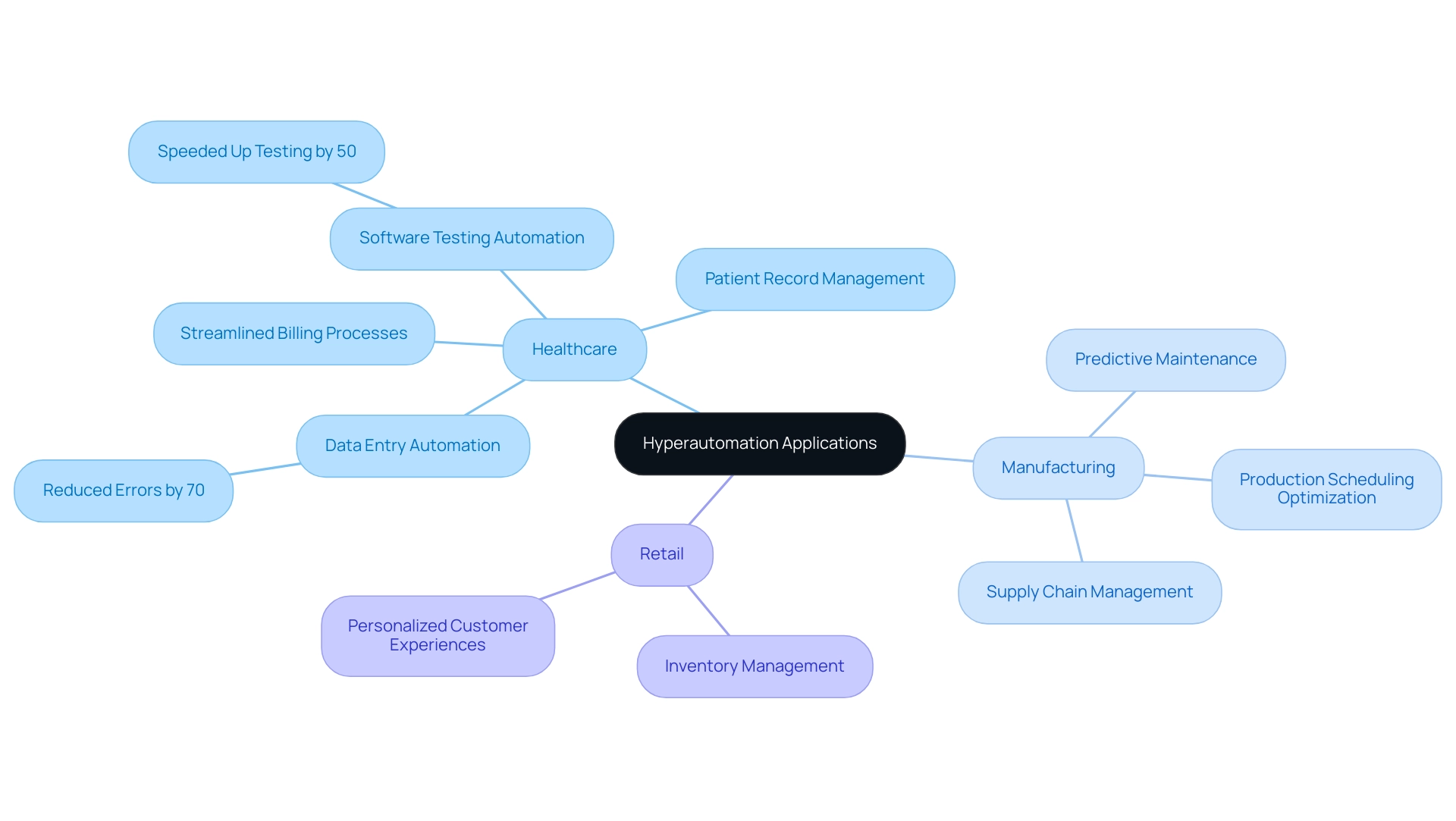
Hyperautomation vs. Traditional Automation: A Comparative Analysis
When examining the distinctions between advanced process optimization techniques and conventional methods, several critical differences become apparent:
- Scope: Conventional methods are limited to specific tasks, whereas advanced techniques aim to automate entire workflows and processes, leading to a more holistic enhancement of operations.
- Technology Integration: Advanced techniques employ a synergistic approach by integrating AI, Robotic Process Automation (RPA), and various advanced technologies. In contrast, conventional systems typically depend on separate tools that do not connect, making it less efficient.
- Adaptability: A key advantage of advanced processes is their ability to learn and adjust over time, allowing systems to enhance performance and efficiency continually. Traditional systems lack this dynamic capability, rendering them less effective in rapidly evolving business environments.
- Business Impact: Hyperautomation technologies promise significant operational transformation, enabling organizations to achieve heightened efficiency and innovation that far exceeds what traditional methods can deliver. As Gartner emphasizes, in 2023, companies will concentrate on transforming employee and customer interaction while speeding up strategies to explore new virtual markets. Furthermore, AI and machine learning play a crucial role in enabling smart predictive maintenance, improving equipment safety and efficiency within advanced automation frameworks. However, organizations must navigate challenges such as poor master information quality, which can hinder effective AI implementation, the acquisition of necessary technical skills, and the selection of suitable mechanization tools for seamless integration.
For instance, the case study titled ‘Smart Tagging: A Qualitative Strategy in the Pharmaceutical Sector‘ exemplifies how advanced mechanization can foster innovative approaches that improve service delivery in the pharmaceutical industry, showcasing the real-world impact of these technologies.
Additionally, leveraging Business Intelligence alongside advanced mechanization can transform raw information into actionable insights, empowering informed decision-making that drives growth and innovation. With the advanced automation market projected to grow at a compound annual growth rate (CAGR) of 19.80%, understanding these distinctions is essential for organizations aiming to refine their automation strategies. By recognizing the transformative potential of hyperautomation technologies and effectively addressing the challenges of AI adoption, including those related to data quality, businesses can make informed decisions that align with their operational goals and future-proof their processes.
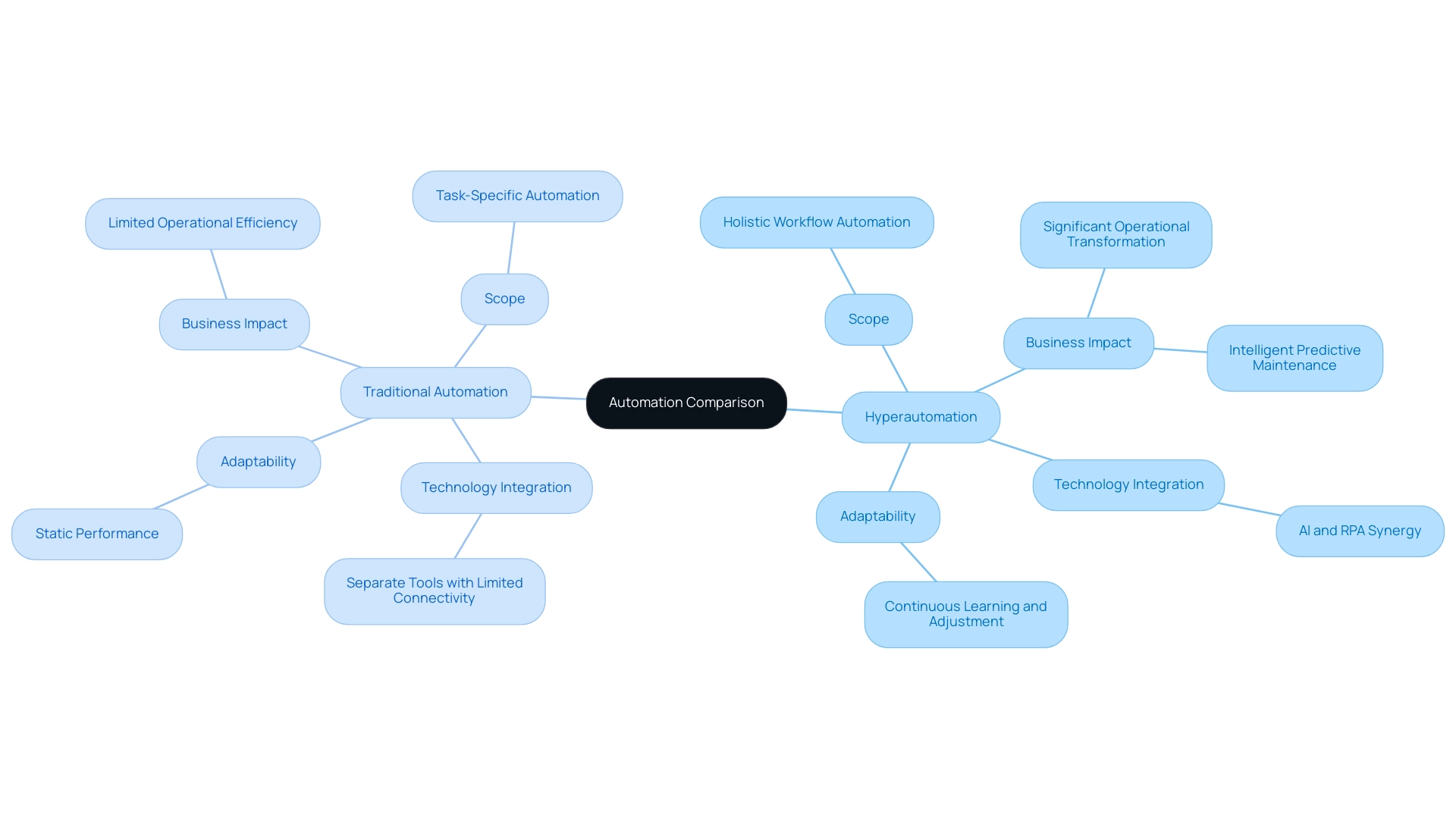
Conclusion
Embracing hyperautomation is not just a trend; it’s a strategic imperative for organizations seeking to thrive in a competitive landscape. By integrating advanced technologies such as artificial intelligence, robotic process automation, and machine learning, hyperautomation enables businesses to streamline entire workflows rather than simply automating isolated tasks. This comprehensive approach addresses common operational challenges, such as poor data quality and employee resistance, while significantly enhancing efficiency, accuracy, and cost savings.
The benefits of hyperautomation extend across various sectors, demonstrating its versatility and transformative potential. From healthcare to manufacturing and retail, organizations that implement hyperautomation report substantial improvements in operational efficiency, reduced cycle times, and enhanced customer experiences. As the landscape continues to evolve, the ability to adapt and scale operations without increasing resources becomes paramount, positioning businesses for long-term growth and success.
However, navigating the challenges associated with hyperautomation—such as change management, integration complexity, and skill gaps—requires strategic planning and a commitment to fostering a culture of innovation. Companies that proactively address these considerations will not only enhance their operational efficiency but also empower their workforce to engage in higher-value tasks, ultimately driving employee satisfaction and retention.
In conclusion, hyperautomation represents a significant opportunity for organizations to redefine their operational capabilities. By understanding its core principles and tackling implementation challenges head-on, leaders can drive strategic growth and operational excellence, ensuring their organizations remain agile and competitive in an ever-changing business environment.
Introduction
In the ever-evolving landscape of business operations, the integration of Robotic Process Automation (RPA) has emerged as a game-changer for organizations seeking to enhance efficiency and streamline processes.
Gartner’s Magic Quadrant serves as a pivotal guide for decision-makers, offering a clear framework to assess the myriad of RPA tools available in the market. By categorizing vendors into:
- Leaders
- Challengers
- Visionaries
- Niche Players
this analysis simplifies the selection process, empowering businesses to align their automation strategies with their unique operational needs.
As organizations navigate the complexities of digital transformation, understanding the strengths and capabilities of leading RPA solutions becomes essential. With compelling case studies illustrating significant improvements in productivity and error reduction, this article explores the critical insights from Gartner’s findings, the top players in the RPA landscape, and the emerging trends that are shaping the future of automation.
Understanding Gartner’s Magic Quadrant for RPA Tools
The RPA tools Gartner Magic Quadrant serves as a vital research methodology that visually depicts the trajectory, maturity, and key players within the RPA market. This framework categorizes vendors into four distinct quadrants: Leaders, Challengers, Visionaries, and Niche Players. Each category reflects the vendors’ execution capabilities and their completeness of vision.
For instance, leaders exemplify robust performance and a comprehensive strategy, making them ideal for groups aiming to enhance operational efficiency. By leveraging insights from this quadrant, businesses can pinpoint RPA solutions that align with their operational requirements and strategic objectives according to RPA tools Gartner. Understanding the Magic Quadrant, particularly regarding RPA tools Gartner, not only simplifies the selection process amidst a crowded RPA landscape but also empowers organizations to make informed decisions that propel their digital transformation efforts.
As evidenced in a recent case study, a mid-sized healthcare company streamlined operations through GUI automation by addressing challenges like manual data entry errors and slow software testing. They accomplished a remarkable 70% decrease in data entry mistakes and enhanced workflow efficiency by 80%, showcasing the transformative potential of RPA solutions. As Datamatics aptly states, ‘Innovative digital technologies are essential for enhancing productivity and competitive advantage.’
This perspective emphasizes the importance of selecting the appropriate RPA resources, particularly considering the recent updates on market trends and vendor analysis from RPA tools Gartner set for release on 7/27/23. Furthermore, organizations can look to the Nintex RPA case study, which illustrates how Nintex supports over 8,000 organizations globally in accelerating their digital transformation efforts. This case study emphasizes the practical use of RPA solutions across various sectors, including healthcare, thereby reinforcing the narrative of RPA’s impact.
Additionally, the Warehouse Management Systems Magic Quadrant, last updated on 5/2/24, provides a temporal context that further enriches the discussion on RPA tools Gartner and their evolving landscape.
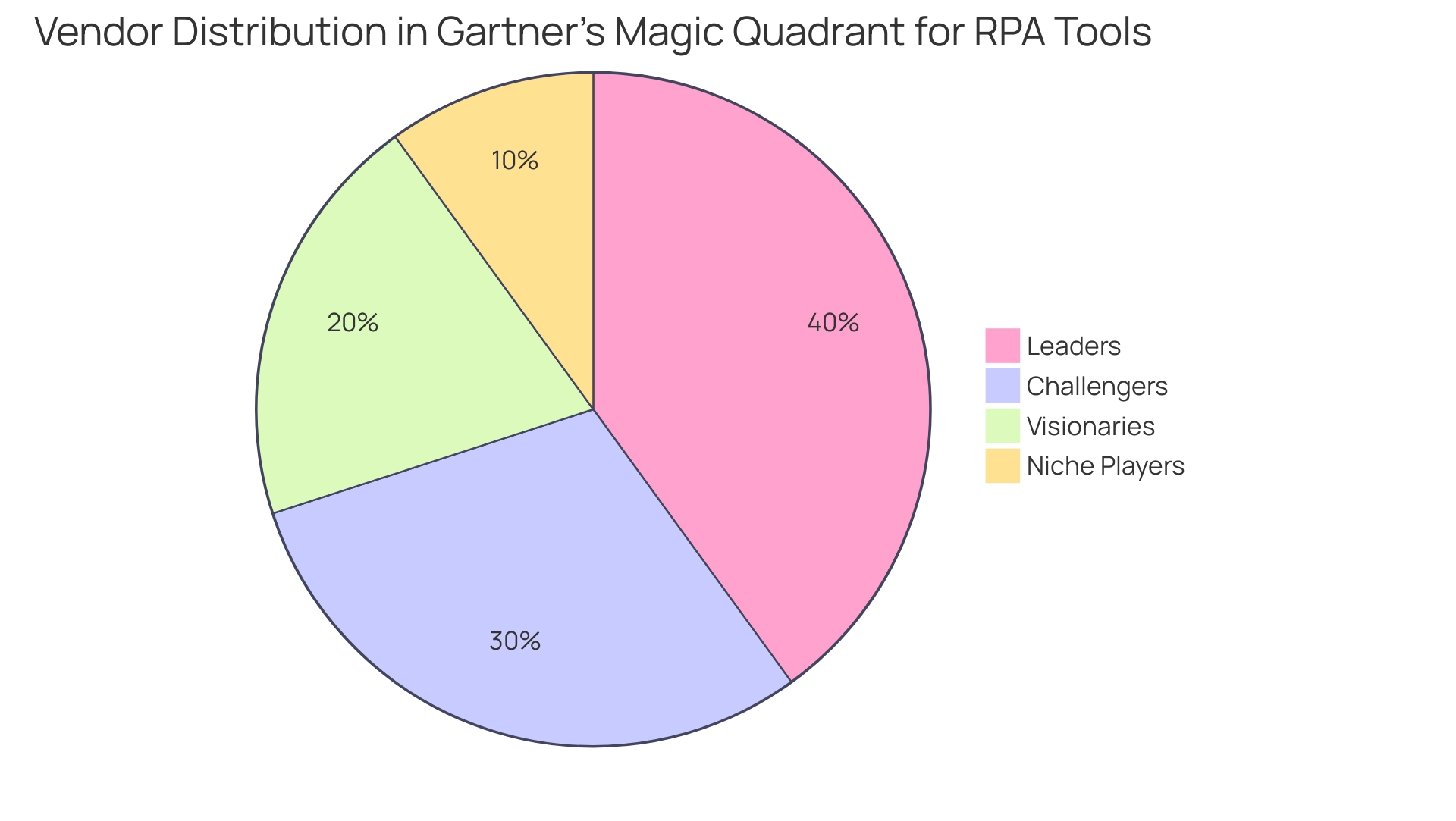
Key Leaders in the RPA Landscape According to Gartner
Gartner’s latest Magic Quadrant identifies prominent leaders in the RPA tools Gartner landscape, such as UiPath, Automation Anywhere, and Blue Prism, each offering distinct advantages tailored to various organizational needs.
- UiPath is celebrated for its intuitive user interface and vibrant community support, making it an ideal option for companies aiming for rapid deployment and ease of use.
- Automation Anywhere sets itself apart with a cloud-native platform that utilizes advanced AI capabilities, enabling the execution of complex automation scenarios that enhance operational performance.
- Blue Prism is renowned for its stringent security features and enterprise-level scalability, making it particularly suitable for larger organizations with extensive automation demands.
Notably, the on-premises sector is projected to lead the market with a revenue share of over 68.44% in 2023. With the North American market dominating the RPA sector and Asia Pacific quickly growing, grasping the capabilities and strengths of these platforms is crucial for improving operational performance and adapting to changing technological environments.
Furthermore, a recent study revealed that:
- 91% of employees believe that automation saves time and improves work-life balance.
- 89% feel more satisfied with their jobs due to automation.
This aligns with Slack’s finding that, on average, workers save 3.6 hours per week by using automation, underscoring the efficiency benefits of RPA. By leveraging RPA, companies can significantly reduce errors and free up their teams for more strategic, value-adding work, while also addressing the challenges posed by manual, repetitive tasks.
Coupled with tailored AI solutions and Business Intelligence, organizations can transform their manual workflows into streamlined processes, driving data-driven insights that foster growth and innovation.
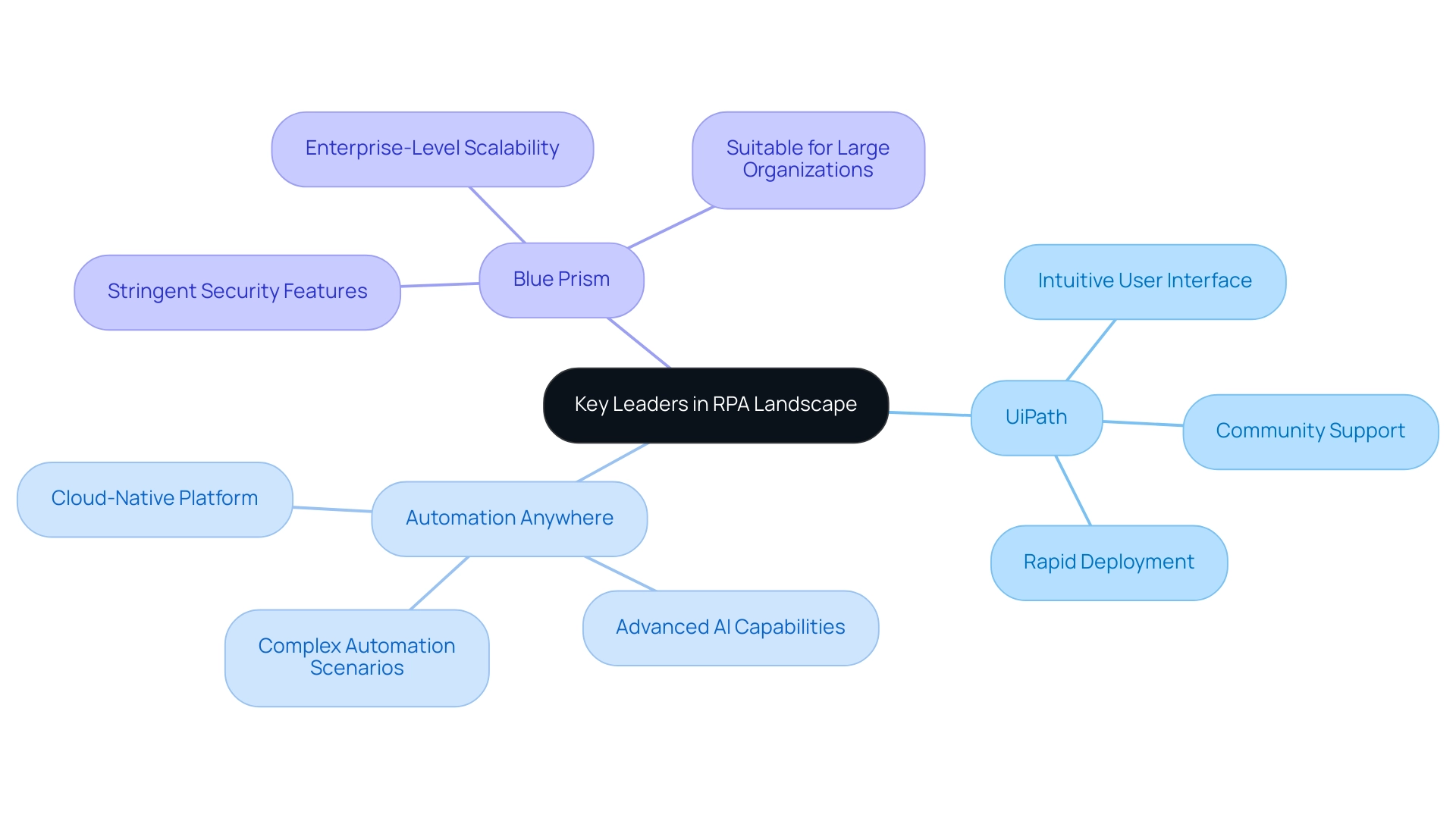
Criteria for Evaluating RPA Tools in the Magic Quadrant
The effectiveness and alignment of RPA solutions with business objectives are shaped by several critical criteria in Gartner’s assessment of RPA tools. These criteria include:
- Product capabilities
- Market responsiveness
- Customer experience
- Vendor viability
Product capabilities refer to the functionality of the device, ease of use, and its ability to integrate seamlessly with existing systems.
Notably, recent industry reports highlight that a staggering 33% of healthcare work could be automated through effective RPA solutions, indicative of the broader market potential; the RPA market is projected to grow from $1.4 billion in 2022 to an impressive $14.18 billion by 2032. Market responsiveness measures how adeptly a vendor can adapt to shifting market demands and customer needs, a necessity in an industry projected to witness an annual growth of 25% in RPA adoption among SMEs. Customer experience is another vital factor, focusing on user satisfaction and the quality of support services offered.
ClaySys Technologies notes that RPA can handle up to 90% of data entry tasks in clinical research, underscoring the importance of a positive user experience in maximizing RPA effectiveness. Lastly, vendor viability examines the financial health and longevity of the company supplying the RPA resources. With significant investments in the sector—UiPath alone secured $1.2 billion in funding, while Automation Anywhere received $840 million, Blue Prism Group accumulated $182 million, and Workfusion secured $180 million—understanding these evaluation criteria enables businesses to strategically align their RPA tool selection with their operational goals.
This alignment ensures sustained efficiency and innovation, addressing workplace challenges such as repetitive tasks, staffing shortages, and outdated systems. By streamlining processes and reducing errors, RPA not only enhances productivity but also frees up team members for more strategic, value-adding work, ultimately promoting data-driven insights for business growth.
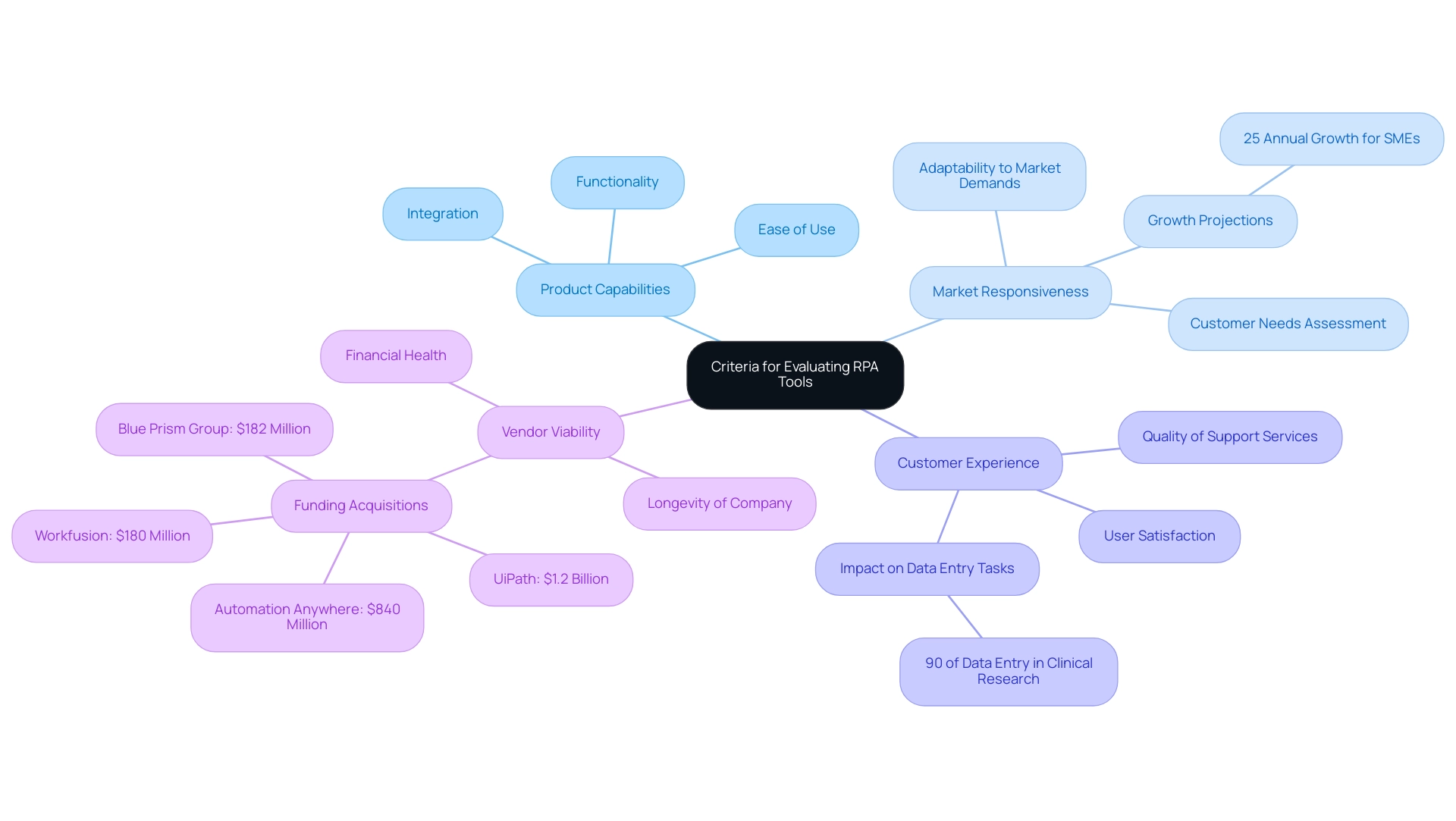
Implications of Gartner’s Findings for Businesses Considering RPA
The insights derived from RPA tools Gartner, as highlighted in Gartner’s Magic Quadrant, carry substantial weight for organizations contemplating the adoption of Robotic Process Automation (RPA). It is crucial for businesses to focus on resources categorized within the Leaders quadrant. Vendors in this segment not only exhibit a strong execution capability but also possess a robust vision for future enhancements, making them ideal partners for RPA initiatives.
Moreover, a significant 65% of RPA survey respondents expressed that they would benefit from usage-based pricing, underscoring the growing preference for flexible pricing models in RPA selection. Furthermore, as Niamh Lordan, Head of Marketing, indicates, the difficulty of attracting IT talent presents a significant hurdle to digital transformation, which underscores the importance of choosing the appropriate RPA solutions to alleviate such challenges. Companies must evaluate their individual operational hurdles when selecting RPA tools, ensuring that the chosen solutions are tailored to their specific requirements.
By utilizing insights from RPA tools Gartner’s research and citing successful case studies, organizations can greatly lessen the risks linked to RPA implementation, creating opportunities for improved operational performance, productivity, and lower costs. This strategic approach empowers businesses to navigate the complexities of RPA adoption while maximizing the benefits of tailored AI solutions and Business Intelligence for informed decision-making. To explore how RPA can transform your operations and reduce costs, consider engaging with our tailored AI solutions that align with your specific business needs.
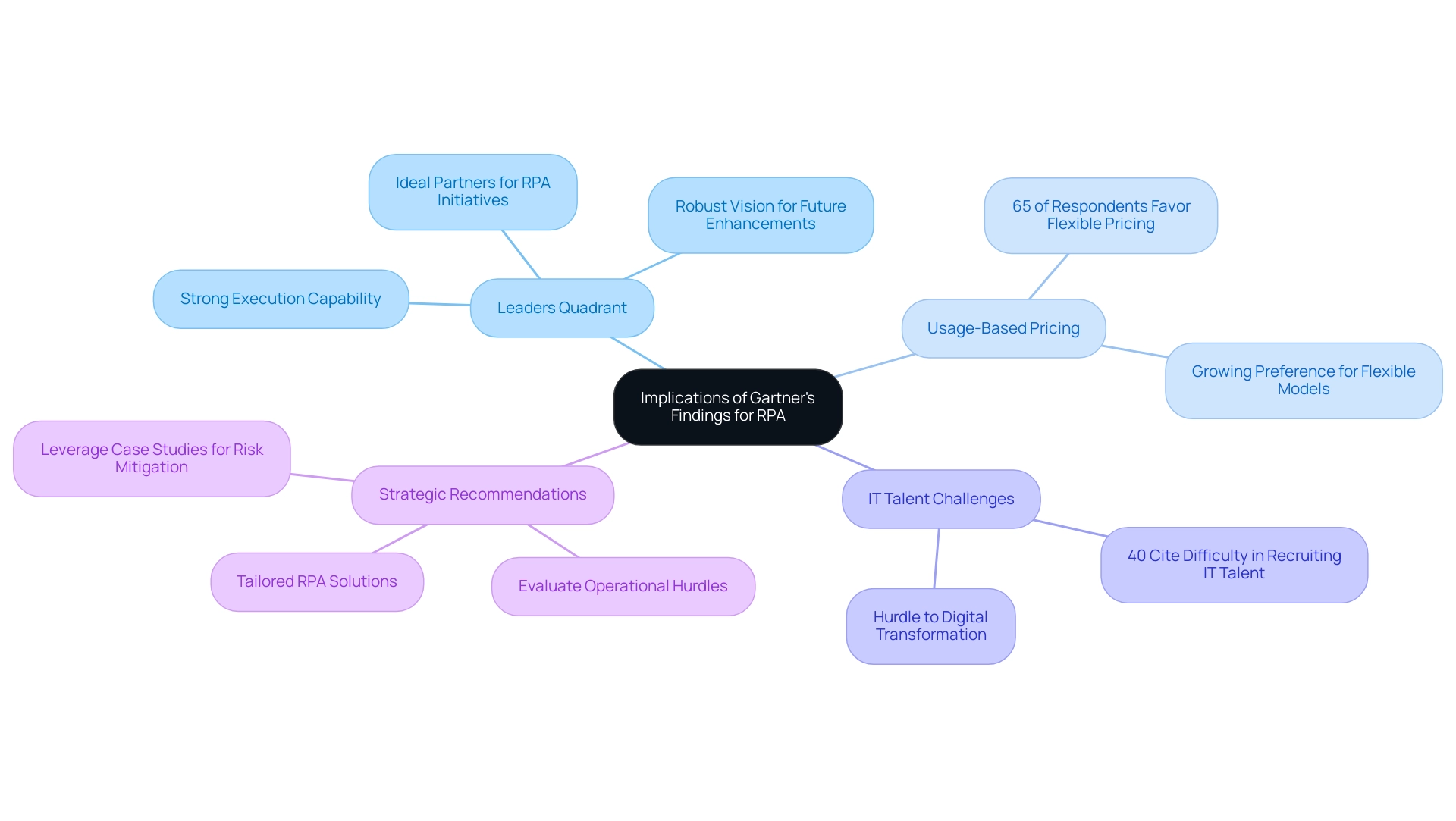
Emerging Trends in RPA: Insights from Gartner
Emerging trends in Robotic Process Automation (RPA) are significantly influencing the future of operational effectiveness. With Gartner forecasting substantial advancements in the coming years, a crucial trend is the integration of artificial intelligence (AI) and machine learning capabilities in RPA tools, according to Gartner. This empowers RPA tools to autonomously learn from data, optimizing workflows and enhancing overall efficiency.
Such evolution enables entities to not only automate manual workflows but also enhance decision-making through intelligent, data-driven insights. Furthermore, the rise of tailored AI solutions and cloud-based RPA platforms provides unparalleled flexibility and scalability, eliminating the need for extensive infrastructure investments and enabling seamless deployment of automation solutions. Our service methodology includes a step-by-step approach:
- We assess a process you wish to automate.
- We calculate the efforts required for automation.
- We estimate the time savings and calculate the ROI.
- We automate the process with certified professionals.
Recent surveys highlight that over 53% of entities have already adopted RPA, with 78% of users planning to increase investments in this technology within the next three years. Significantly, 61% of entities report successful cost reductions attributable to RPA, reinforcing its effectiveness. Moreover, Gartner, Inc. projects that by 2024, slightly less than half of RPA adoptions will be initiated by departments outside of IT, which reflects the broader acceptance of RPA tools across business functions.
RPA vendors are also focusing more on user experience, making automation tools more intuitive and accessible to a wider audience. The assistance of digital transformation firms is vital for entities aiming to leverage RPA solutions effectively, driving operational efficiency and innovation. By remaining attuned to these trends and the importance of business intelligence in transforming data into actionable insights, organizations can strategically position themselves to harness the full potential of RPA technologies, paving the way for enhanced productivity and growth.
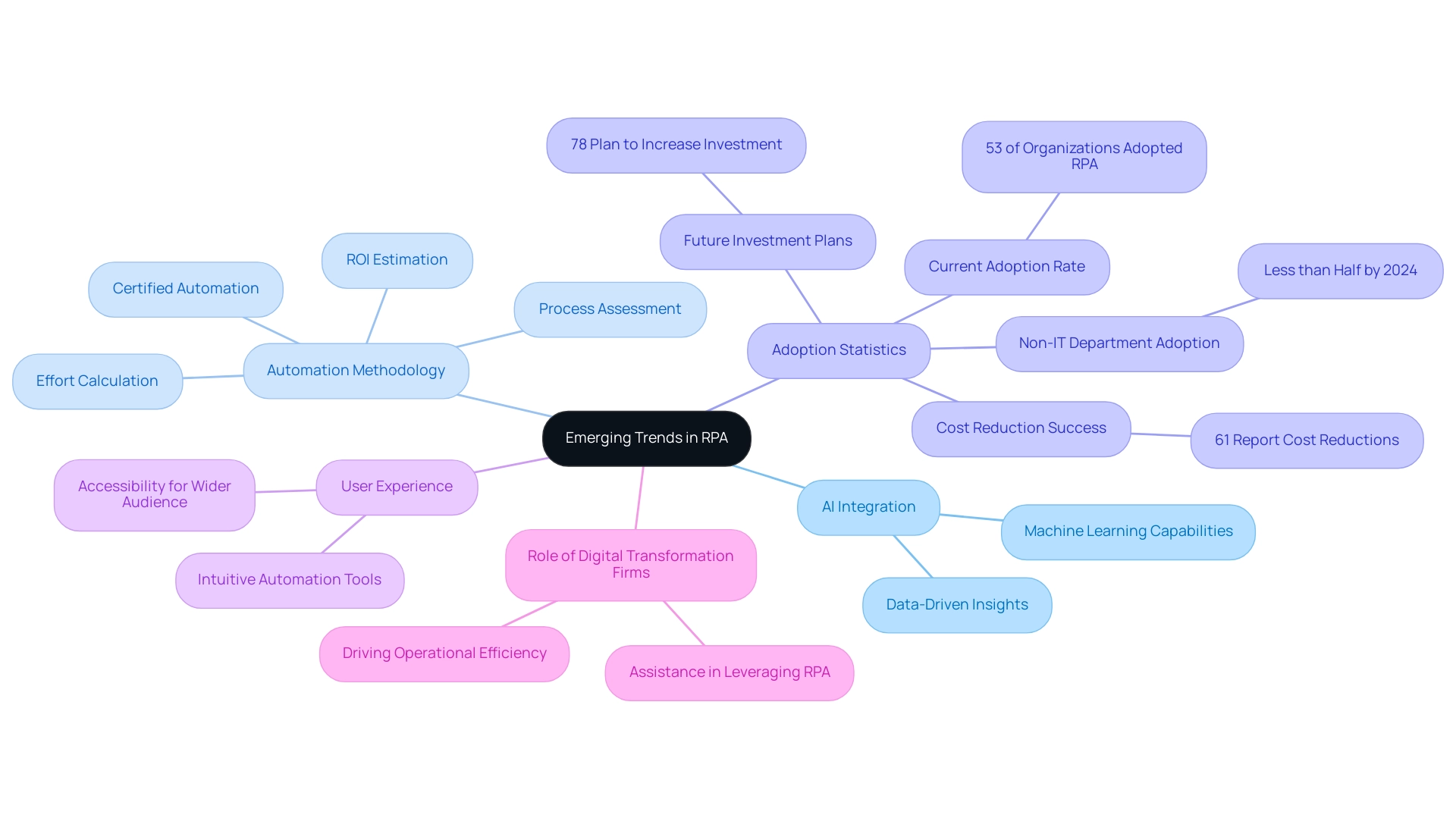
Conclusion
Gartner’s Magic Quadrant serves as a crucial compass for organizations navigating the complex landscape of Robotic Process Automation (RPA). By categorizing vendors into Leaders, Challengers, Visionaries, and Niche Players, it empowers decision-makers to identify tools that align with their specific operational needs. The significant case studies highlighted in the article illustrate how companies have achieved remarkable improvements in efficiency and productivity through strategic RPA implementations. As organizations increasingly recognize the value of automation, the insights from Gartner become indispensable for making informed decisions that drive digital transformation.
Understanding the strengths and capabilities of leading RPA solutions, such as UiPath, Automation Anywhere, and Blue Prism, is essential for maximizing operational efficiency. These platforms not only offer diverse functionalities tailored to various organizational demands but also demonstrate a commitment to innovation and user experience. With the RPA market projected to expand dramatically, businesses that prioritize selecting the right tools will position themselves for long-term success.
As emerging trends, including AI integration and cloud-based solutions, continue to reshape the RPA landscape, organizations must remain proactive in adapting to these advancements. By leveraging insights from Gartner and focusing on tailored strategies, businesses can effectively address challenges such as staffing shortages and manual processes. The journey toward enhanced efficiency and productivity through RPA is not just about technology; it’s about strategic alignment and fostering a culture of innovation. Embracing these insights will enable organizations to harness the full potential of RPA, driving sustainable growth and competitive advantage in an increasingly automated world.
Introduction
In the digital age, where data is the lifeblood of organizations, the need for effective data management has never been more crucial. Intelligent Data Processing (IDP) emerges as a game-changing solution, harnessing the power of artificial intelligence and machine learning to automate and optimize the way businesses handle information. By transforming traditional data processing methods, IDP not only enhances operational efficiency but also empowers organizations to derive actionable insights from vast amounts of unstructured data.
As industries across the globe experience rapid growth in data volume, understanding and implementing IDP technologies becomes essential for maintaining a competitive edge. This article explores the key benefits, operational mechanisms, real-world applications, and the evolution of IDP, offering a comprehensive guide for organizations eager to streamline their data management processes and drive innovation in an increasingly complex landscape.
Defining Intelligent Data Processing (IDP)
Intelligent data processing (IDP) embodies a transformative approach to managing information by leveraging cutting-edge technologies such as artificial intelligence (AI) and machine learning (ML) to automate the extraction, transformation, and loading (ETL) of information from various sources. Unlike conventional approaches that often depend significantly on manual input, IDP employs advanced algorithms that learn from patterns, effectively tackling issues such as poor master information quality that many companies encounter. This capability enables businesses to efficiently manage vast amounts of unstructured information, significantly enhancing accuracy and minimizing human intervention.
In fact, with 30% of business owners expecting AI to generate website copy, it’s clear that reliance on AI technologies is growing. By streamlining data management processes, intelligent data processing (IDP) enhances operational efficiency and allows entities to make informed decisions based on reliable insights. As reported by Google, 54% of users find that virtual personal assistants simplify their lives, echoing the benefits offered by IDP technologies.
Furthermore, a case study reveals diverse interactions with AI across demographics, underscoring the need for entities to adjust to these changes. To further enhance operational efficiency, integrating Robotic Process Automation (RPA) solutions like EMMA RPA and Microsoft Power Automate can address task repetition fatigue and streamline workflows. However, entities often perceive AI projects as complex and costly, which can hinder adoption.
Therefore, leveraging intelligent data processing technologies in conjunction with RPA solutions is crucial for overcoming these barriers. Additionally, participating in GenAI Workshops can provide hands-on training and support, assisting entities in navigating the complexities of AI implementation. In a rapidly evolving digital landscape, the adoption of intelligent data processing technologies is essential for enhancing operational efficiency and overcoming the barriers associated with AI implementation.
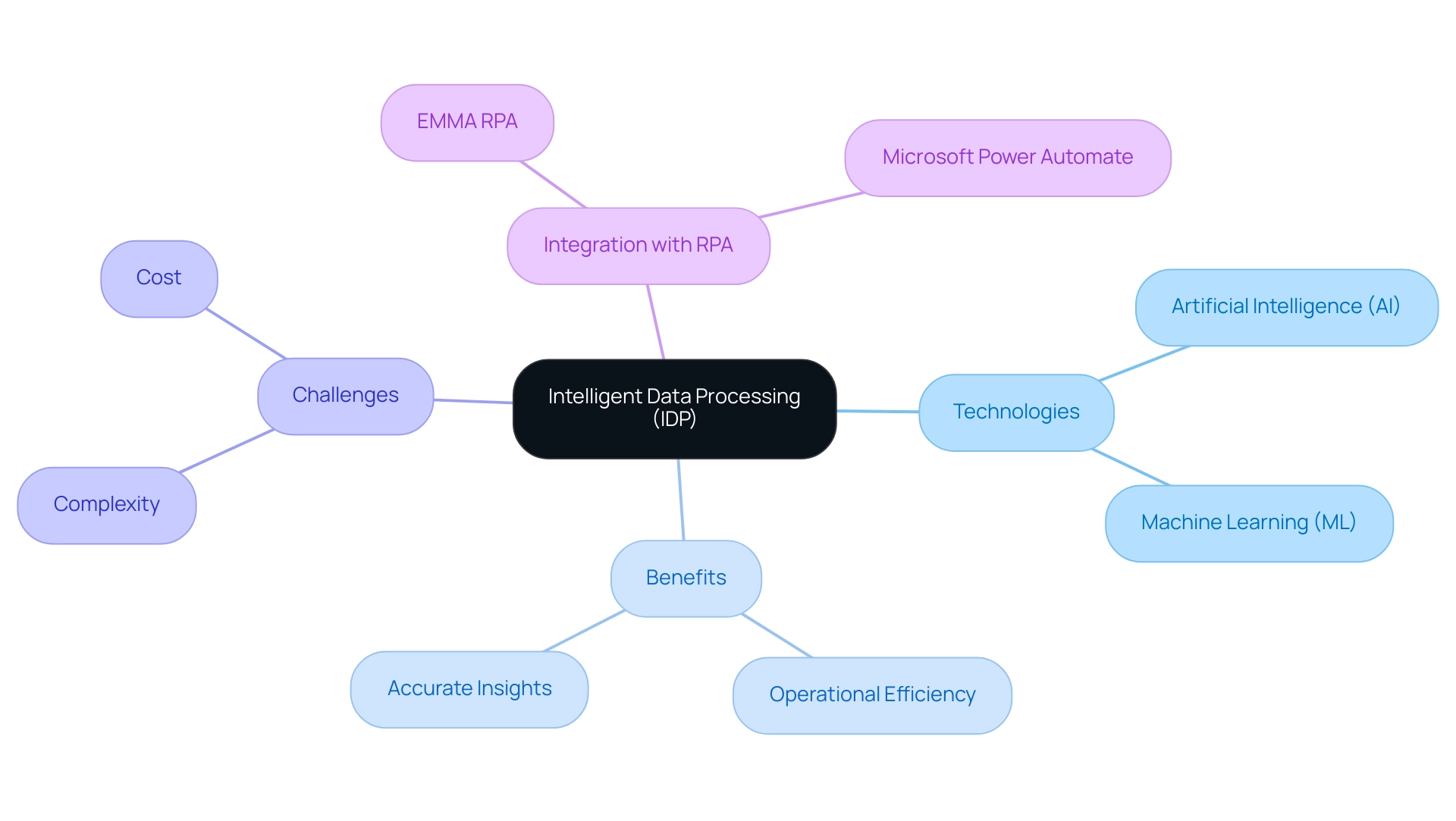
Key Benefits of Intelligent Data Processing
The benefits of intelligent data processing are multifaceted, primarily focusing on enhancing efficiency, improving accuracy, and generating substantial cost savings. By implementing intelligent data processing for automating information extraction, companies can decrease processing durations by over 50%, reallocating valuable resources towards strategic initiatives instead of routine tasks. This automation not only speeds up workflows but also contributes to intelligent data processing by reducing errors typically associated with manual entry, leading to more reliable insights.
Industry reports consistently show that organizations deploying IDP solutions experience a significant decrease in operational costs and a marked increase in productivity. Such advancements are vital as companies navigate the complexities introduced by generative AI, which raises various risks, including information management and security issues. Notably, 85% of the general public believe a nationwide effort is necessary to make AI safe and secure, highlighting the urgency of addressing these issues.
Moreover, as emphasized in case studies on GUI automation, companies are increasingly cognizant of the risks presented by generative AI, including management and security vulnerabilities. By adopting intelligent data processing (IDP) and RPA, companies can optimize operations and reduce potential pitfalls linked to human error, which ensures a strong and effective management strategy. The case study demonstrates that by implementing GUI automation, the mid-sized company overcame challenges such as manual information entry errors and slow software testing, achieving a 70% reduction in entry mistakes, a 50% acceleration in testing processes, and a remarkable ROI within six months.
As Tajammul Pangarkar, CMO at Prudour Pvt Ltd, emphasizes, integrating advanced technologies such as intelligent data processing is crucial for effectively navigating these challenges and enhancing operational efficiency.
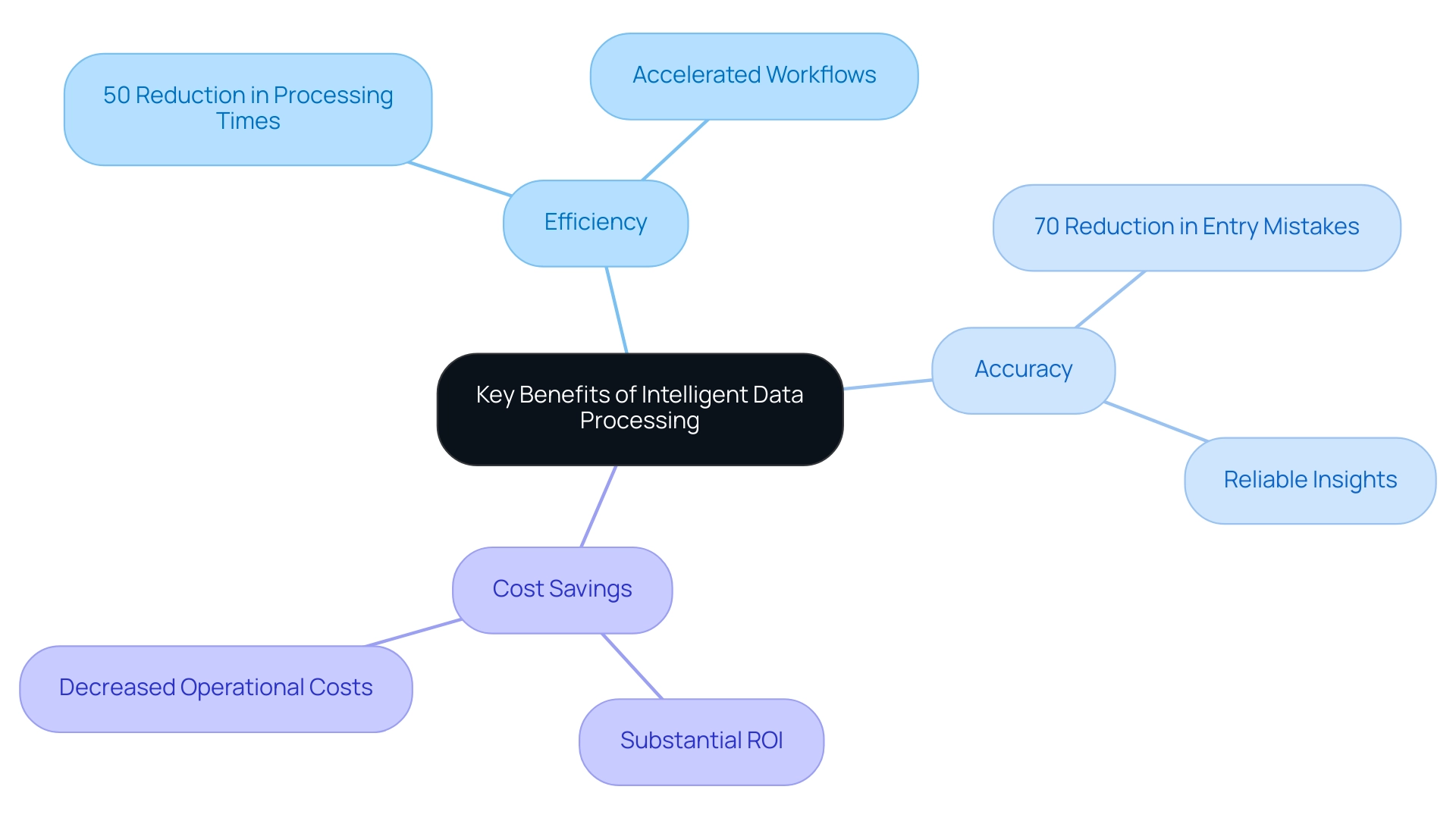
How Intelligent Data Processing Works
Intelligent data processing (IDP) operates by leveraging a powerful synergy of machine learning algorithms, natural language processing (NLP), and robotic process automation (RPA). This process starts with the gathering of information from various sources such as documents, emails, and databases, which establishes the basis for effective information management. By employing NLP, the IDP system interprets and classifies this information accurately, allowing organizations to extract valuable insights efficiently.
As noted by Aditya Thorat,
Data manipulation transforms variables into a consistent range, making it easier for machine learning models to learn patterns.
For example, random forest classifiers generally employ majority voting or averages for their final outcomes, showcasing the quantitative element of machine learning in information handling. Subsequently, machine learning algorithms boost the system’s adaptability, allowing it to learn from new information inputs consistently and enhance accuracy over time.
Moreover, RPA plays a critical role by automating repetitive tasks that often drain resources and hinder productivity, which can negatively impact employee morale. By ensuring that information flows effortlessly through the workflow pipeline, RPA reduces the load of manual tasks and tackles staffing shortages, enabling teams to concentrate on more valuable activities. For example, entities that implement RPA have reported up to a 30% reduction in processing time and a significant decrease in errors, showcasing the tangible benefits of automation.
Understanding the assumptions underlying machine learning models, as highlighted in the case study titled ‘Assumptions and Validation,’ is vital for ensuring model validity. This comprehensive approach, which integrates RPA and tailored AI solutions, empowers organizations to utilize intelligent data processing to manage vast amounts of information with remarkable efficiency and effectiveness, ultimately addressing the growing demands of information-driven operations in 2024 and enhancing overall business productivity.
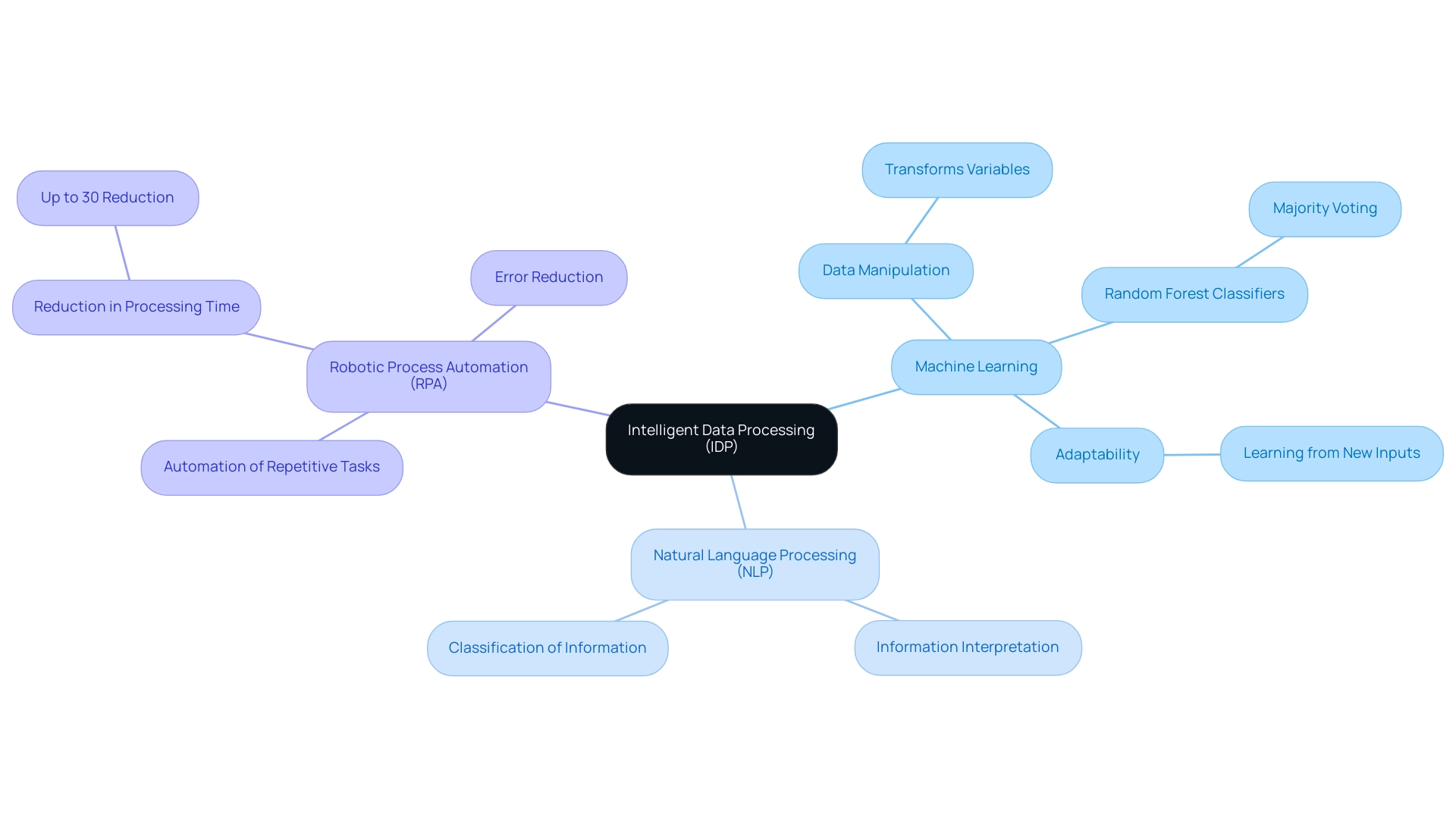
Real-World Applications of Intelligent Data Processing
Intelligent Document Processing (IDP) is revolutionizing multiple industries, including finance, healthcare, and logistics, through intelligent data processing that automates and enhances operational tasks. The global IDP market is projected to grow from USD $860 million in 2021 to USD $4.15 billion in 2026, highlighting its significant potential and relevance in today’s business landscape. By leveraging Robotic Process Automation (RPA), IDP significantly enhances compliance processes in the financial sector by efficiently extracting relevant information from legal documents and transaction records.
This automation accelerates workflows, minimizes the risk of human error, and enhances overall productivity. For instance, Oleg Khanachivskyi notes that PayPal, a global leader in online payments, utilizes machine learning to detect and prevent fraud, showcasing the practical applications of IDP in enhancing operational efficiency. In healthcare, where physicians spend approximately 50% of their time on administrative duties, RPA can help reduce this to just 33% by streamlining the management of patient records and optimizing billing systems, directly translating to enhanced patient care and operational efficiency.
The logistics sector also gains from IDP technologies, which enhance supply chain management by analyzing shipment information and accurately predicting demand, resulting in improved inventory control and lower operational expenses. Furthermore, tailored AI solutions play a crucial role in helping businesses navigate the rapidly evolving AI landscape, ensuring that they can implement the right technologies to enhance productivity and decision-making. Furthermore, key trends like explainable AI, ML-driven personalization, and integration with blockchain are developing within the realm of intelligent data processing, indicating transformative potential in addressing complex challenges while paving the way for significant efficiency gains across various sectors.
By addressing manual, repetitive tasks through RPA, organizations can focus on strategic initiatives, ultimately driving growth and innovation.
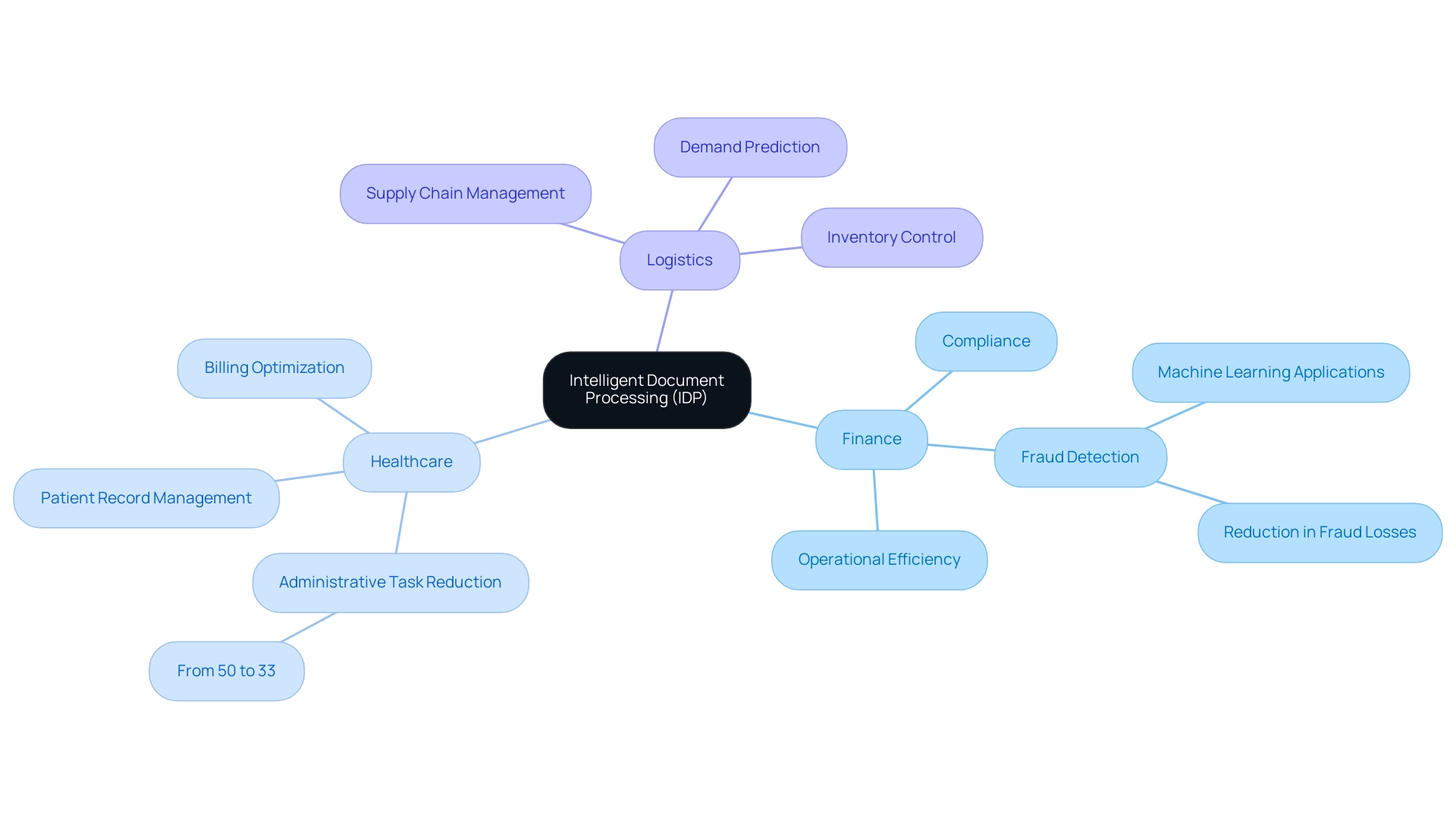
The Evolution of Intelligent Data Processing
The evolution of intelligent data processing illustrates a remarkable journey marked by transformative technological advancements. At first, information handling depended on manual input and cumbersome algorithms, which restricted efficiency and scalability. The historical introduction of punch card systems, for example, led to the establishment of the Tabulating Machine Company, a precursor to IBM.
This transition from manual handling to mechanical computation marked a pivotal shift in how information was managed, showcasing the evolution of information technologies. Tim O’Reilly’s introduction of Web 2.0 in 2005 emphasized user-generated content, reflecting a significant moment in the historical context of information management. Fast forward to today, and the landscape has dramatically changed with the integration of machine learning and natural language processing, which revolutionize analytics by processing vast amounts of information quickly and uncovering insights.
These innovations enhance intelligent data processing (IDP) by enabling it to adapt dynamically to various data types and sources, thereby improving its versatility and effectiveness. As organizations face challenges in implementing new technologies, Creatum GmbH is committed to designing solutions that drive meaningful change through collaboration and expertise. For instance, our clients have successfully utilized Robotic Process Automation (RPA) to automate tedious manual workflows, resulting in a 30% reduction in turnaround time and a significant decrease in errors.
Furthermore, by utilizing Business Intelligence tools, companies have transformed their raw information into actionable insights, facilitating informed decision-making that has driven growth and innovation. Looking ahead to 2024, the ongoing advancements in intelligent data processing solutions promise to further revolutionize how entities harness data, ensuring they remain competitive and agile in an ever-evolving landscape. Embracing RPA will be key in this journey, streamlining workflows and enhancing operational efficiency, while leveraging Business Intelligence will empower organizations to make informed decisions that drive growth.
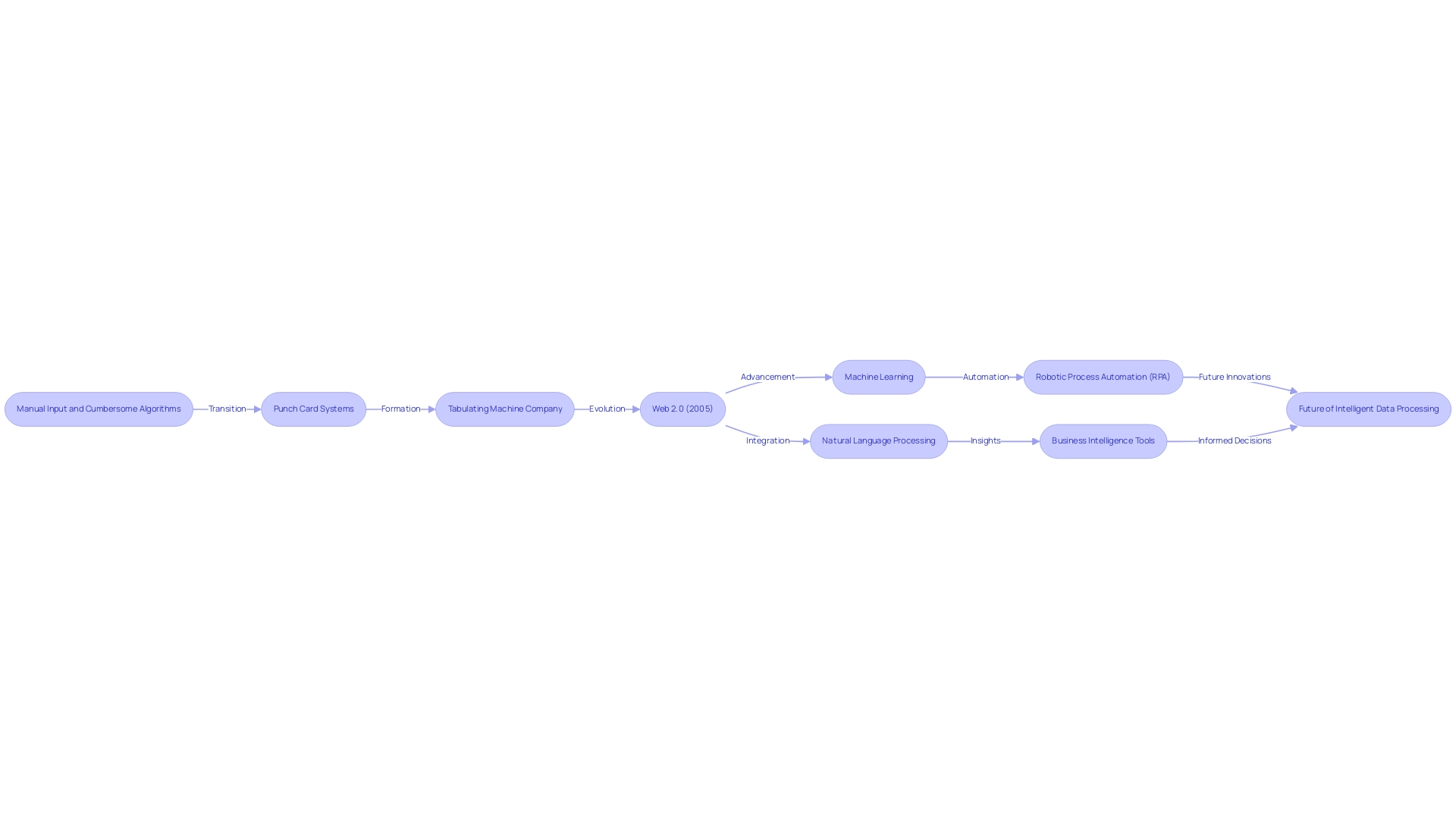
Conclusion
The journey into Intelligent Data Processing (IDP) reveals a powerful shift in how organizations manage and leverage their data. From its foundations in traditional data processing methods to the sophisticated integration of artificial intelligence and machine learning, IDP is redefining operational efficiency. By automating data extraction and minimizing manual intervention, businesses can not only enhance accuracy but also redirect valuable resources toward strategic initiatives. The benefits are clear:
1. Significant reductions in processing times
2. Lower operational costs
3. Improved productivity
Real-world applications of IDP showcase its versatility across various industries, including finance, healthcare, and logistics. By streamlining workflows and reducing the risk of human error, organizations can enhance compliance, improve patient care, and optimize supply chain management. As the IDP market continues to grow, it is evident that embracing these technologies is not just an option but a necessity for organizations seeking to thrive in an increasingly data-driven world.
Looking ahead, the evolution of IDP highlights the importance of integrating advanced technologies like Robotic Process Automation (RPA) to address the challenges of manual workflows. By harnessing the power of IDP, businesses can unlock actionable insights, drive innovation, and maintain a competitive edge. The future of data management is bright, and organizations that invest in IDP solutions today will be well-positioned to navigate the complexities of tomorrow’s digital landscape.
Introduction
In the ever-evolving landscape of business operations, the integration of Robotic Process Automation (RPA) has emerged as a game-changer, empowering organizations to enhance efficiency and streamline workflows.
As highlighted in Gartner’s 2024 Magic Quadrant, leading vendors such as Automation Anywhere, Microsoft, and UiPath are revolutionizing the way businesses approach automation, each offering unique solutions tailored to diverse operational needs.
This article delves into the critical features, cost considerations, and future trends that organizations must navigate to harness the full potential of RPA.
By understanding these dynamics, Directors of Operations Efficiency can make informed decisions that not only address current challenges but also position their organizations for sustained success in an increasingly automated world.
Overview of Leading RPA Vendors in Gartner’s 2024 Magic Quadrant
Gartner’s 2024 Magic Quadrant emphasizes several top RPA vendors that are making substantial progress in providing customized solutions for various business requirements. The prominent vendors consist of Automation Anywhere, Microsoft, NICE, SS&C Blue Prism, and UiPath, each providing distinctive strengths in the field of robotic process handling.
- Automation Anywhere: Esteemed for its robust cloud-native platform, Automation Anywhere features an intuitive interface combined with advanced analytics capabilities. This makes it a superb option for entities eager to enhance their operational journey, offering the flexibility required for contemporary business settings.
- Microsoft: With the integration of Power Automate within its expansive ecosystem, Microsoft delivers seamless solutions that capitalize on existing tools. This integration appeals particularly to businesses that have already invested in Microsoft technologies, streamlining operational workflows effortlessly.
- NICE: Renowned for enhancing customer engagement and operational efficiency, NICE integrates RPA with advanced analytics. This combination not only optimizes workflows but also significantly enhances service delivery, establishing it as a strategic ally for entities focused on customer satisfaction.
- SS&C Blue Prism: Recognized for its enterprise-grade operational capabilities, SS&C Blue Prism is especially preferred in regulated sectors where compliance and security are essential. Its robust framework ensures that businesses can automate processes while adhering to strict regulatory guidelines.
- UiPath: A recognized leader in the RPA field, UiPath stands out for its user-friendly interface and extensive community support. This accessibility makes it a favored option for entities aiming to expand their initiatives swiftly and efficiently. UiPath has also developed specialized large language models (LLMs) for intelligent document processing, enhancing the accuracy, speed, and scalability of document tasks through its offerings like UiPath DocPath and CommPath.
Chris Janiszewski, Director of Analyst Relations, highlights that “RPA continues to stand out for its efficiency, accuracy, and ease of use with legacy systems,” emphasizing the importance that these tools provide to entities.
Additionally, Nintex, focusing on process intelligence and automation, serves over 8,000 organizations globally, further enriching the RPA landscape with its unique offerings.
These RPA vendors embody the diverse methodologies and approaches available in the RPA landscape, catering to varying organizational needs and operational contexts. For the Director of Operations Efficiency, understanding these distinctions is crucial in selecting an RPA solution that aligns with specific business objectives and enhances overall operational efficacy. In a recent case study, a mid-sized company encountered difficulties like manual data entry mistakes and slow software testing, which were resolved through the introduction of GUI processes.
By automating these processes, the company achieved a 70% reduction in data entry errors, accelerated testing processes by 50%, and improved overall workflow efficiency by 80%, realizing a return on investment within six months. This case exemplifies the tangible benefits RPA can deliver, making it a compelling choice for entities aiming to enhance operational efficiency.
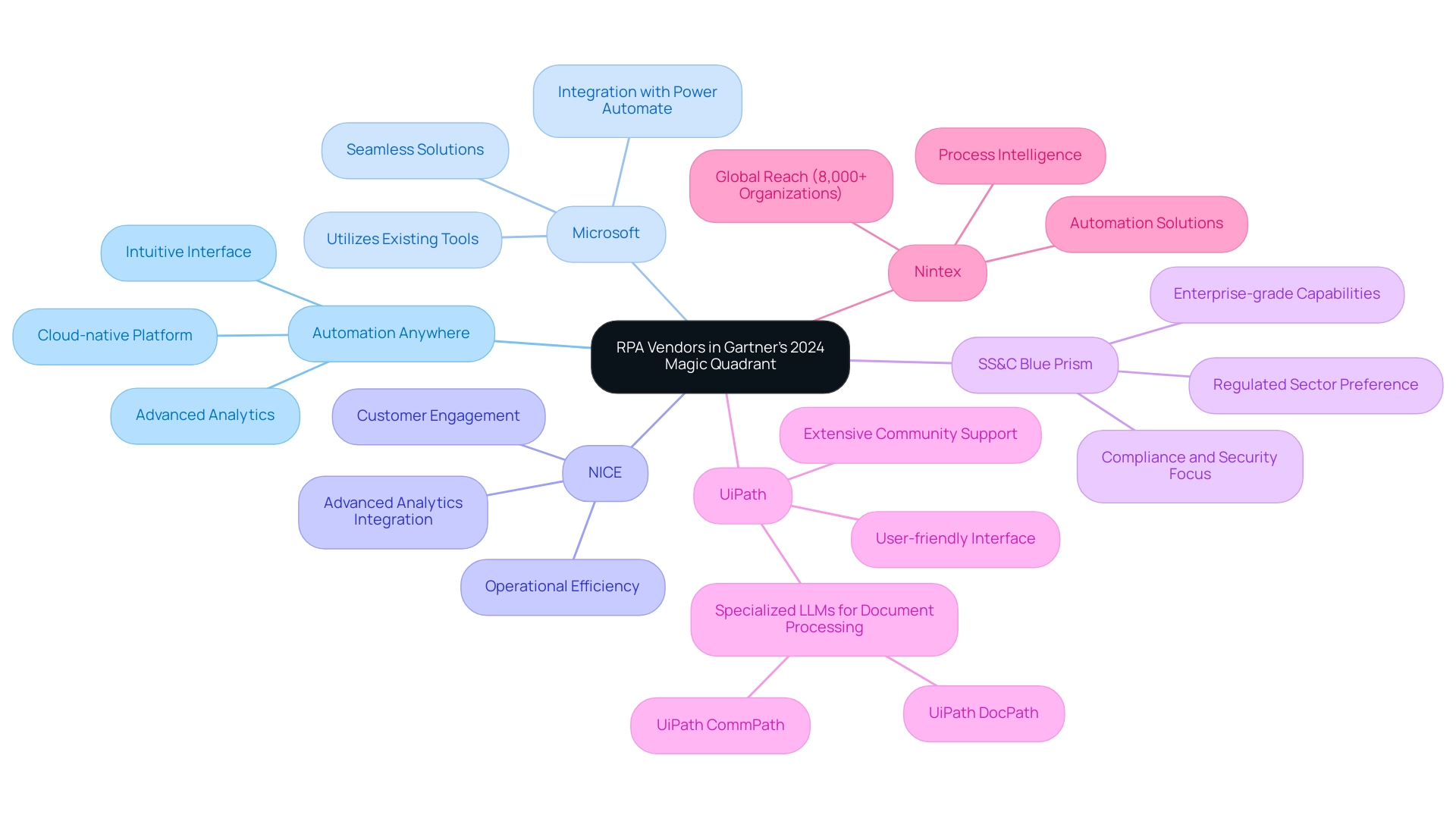
The Role of AI in Shaping the Future of RPA
The role of Artificial Intelligence in the evolution of Robotic Process Automation (RPA) is becoming increasingly essential. Through the incorporation of AI, entities can unlock advanced mechanization capabilities, including cognitive mechanization and intelligent decision-making, which are crucial for next-level operational efficiency.
-
Enhanced Decision-Making: AI algorithms empower RPA bots to analyze extensive datasets and make informed decisions in real-time, significantly enhancing the efficiency of automated processes. This capability enables organizations to react promptly to operational needs, with 83% of employees utilizing AI-driven processes reporting reduced burnout and improved job satisfaction, highlighting the positive effect of AI on workplace dynamics.
-
Natural Language Processing (NLP): The incorporation of NLP into RPA systems enables improved comprehension and processing of unstructured data, particularly beneficial for automating tasks that require understanding human language, such as managing customer service inquiries.
-
Predictive Analytics: AI-driven RPA solutions leverage predictive analytics to foresee future trends, facilitating proactive automation responses. This results in improved operational agility, enabling entities to stay ahead in a dynamic market.
-
Broader Orchestration Capabilities: As entities strive to integrate RPA with various technologies, AI’s role in orchestrating complex workflows across diverse systems becomes crucial, ensuring seamless cooperation among disparate applications and maximizing productivity.
Key features of EMMA RPA include its user-friendly interface and ability to automate complex tasks, while Microsoft Power Automate offers seamless integration with other Microsoft applications, enhancing overall operational efficiency. These tools are designed to address challenges such as staffing shortages and outdated systems by streamlining processes and reducing manual workload.
David Mayer highlights the significance of AI integration, stating, “ElevenLabs’ text-to-podcast feature, Claude can now clone your writing, a tool to sync notes across devices,” emphasizing the innovative potential of AI technologies.
Moreover, the merging of AI and RPA not only enhances operational capabilities but also enables companies to innovate and adjust to changing market demands. For instance, in the healthcare sector, RPA has the potential to automate 33% of healthcare work, with the RPA market projected to grow from $1.4 billion in 2022 to $14.18 billion by 2032. For the Director of Operations Efficiency, understanding these advancements is crucial for making strategic decisions about future investments in technology.
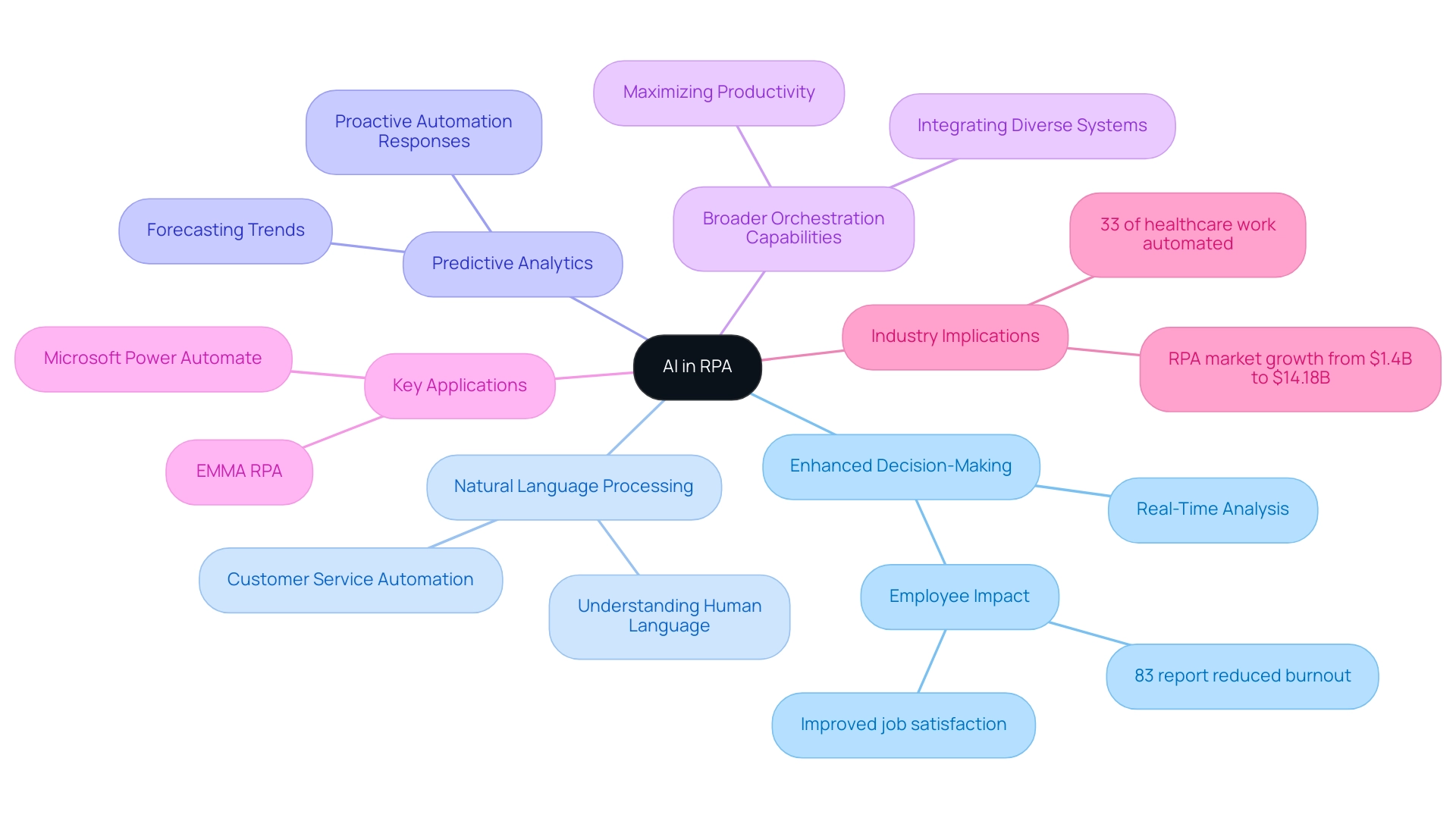
Comparative Analysis of RPA Features
When assessing RPA providers, companies must concentrate on several essential characteristics that can significantly impact their success in deploying technology:
- User Interface: An extremely user-friendly interface is crucial for ensuring that employees can swiftly embrace and efficiently use RPA tools. For example, UiPath is renowned for its user-friendly design, significantly reducing the learning curve for non-technical team members. According to Datamatics, which holds a rating of 4.5, a strong user interface can foster a culture of automation within the company, making it easier for teams to engage with these tools and combat the exhaustion caused by repetitive tasks.
- Scalability: As businesses evolve, their automation needs may shift. Vendors such as Automation Anywhere and Microsoft offer scalable RPA offerings that effortlessly accommodate increasing workloads while maintaining robust performance. This adaptability is essential for organizations looking to future-proof their operations, especially as a survey indicates that 53% of organizations have already started implementing RPA, with 78% expecting increased investment in the next three years. Addressing staffing shortages through scalable solutions can significantly enhance operational efficiency.
- Integration Capabilities: Seamless integration with existing systems is fundamental for maximizing the return on RPA investments. NICE and SS&C Blue Prism excel in this aspect, providing extensive integration options with a broad range of enterprise applications, thus ensuring that initiatives align with existing workflows and assist in modernizing outdated systems. To effectively execute these integrations, companies should evaluate their existing systems and pinpoint crucial areas for mechanization that will produce the greatest effect.
- Support Services: The quality of vendor assistance can greatly influence the success of RPA implementation. UiPath, for instance, is recognized for its vibrant community and comprehensive training resources, which help facilitate smoother onboarding processes and provide ongoing assistance for users. This support is crucial for overcoming technology implementation challenges and enhancing productivity. By acknowledging these differentiators and directly addressing the challenges of repetitive tasks and staffing shortages, organizations can strategically select RPA vendors Gartner identifies that align with their specific operational challenges and objectives. Furthermore, outlining practical steps for implementation will pave the way for successful initiatives. Ultimately, concentrating on these features aids the overarching goal of hyper-automation, establishing an intelligent automation ecosystem capable of managing cognitive and decision-oriented tasks, and utilizing customized AI approaches and Business Intelligence for informed decision-making.
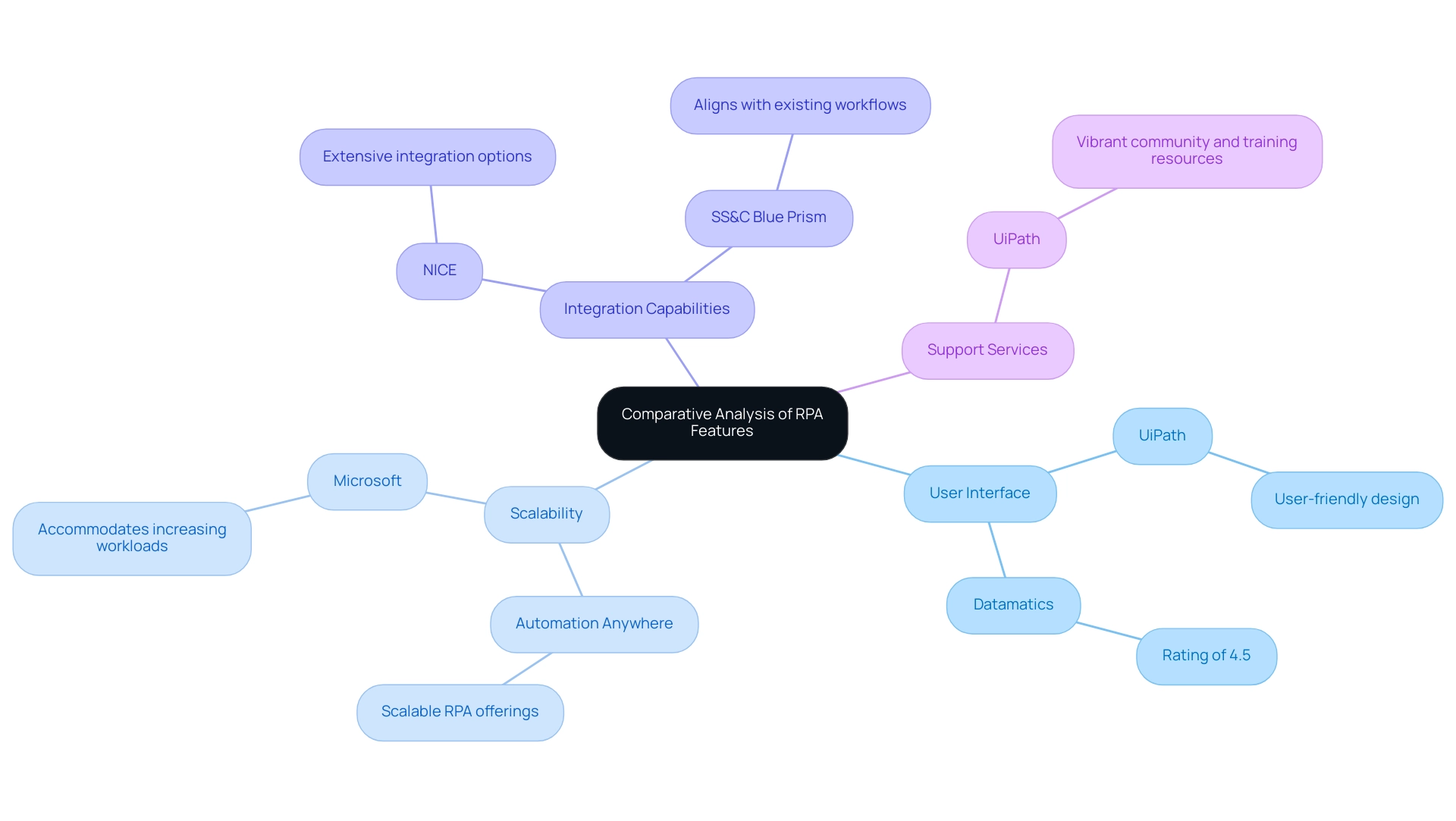
Cost Considerations for RPA Implementation
Cost plays a pivotal role in selecting RPA vendors Gartner, as pricing can vary significantly based on the features and capabilities provided. As Tajammul Pangarkar, CMO at Prudour Pvt Ltd, reflects, technology’s impact on operational efficiency is crucial, especially in today’s rapidly evolving landscape shaped by AI advancements. Key factors to consider include:
-
Licensing Fees: Vendors present various pricing models, such as subscription-based and per-bot licensing. Companies recognized as RPA vendors Gartner, such as Automation Anywhere and UiPath, typically offer flexible pricing structures, catering to organizations of all sizes. This adaptability is crucial, particularly in sectors like fintech, where the estimated cost for automating document processing ranges from $75,000 to $200,000.
-
Implementation Costs: The initial setup and integration of RPA solutions can lead to additional expenses. Organizations must consider consulting services, training, and potential infrastructure improvements to ensure a smooth shift to automated processes.
-
Maintenance and Support: Ongoing costs for maintenance and support are equally important. Vendors such as Microsoft provide comprehensive support packages, alleviating long-term expenses associated with troubleshooting and software updates, ensuring continuous operational efficiency.
-
ROI Measurement: Establishing metrics for measuring the return on investment (ROI) from RPA initiatives is vital. Organizations can establish metrics by analyzing key performance indicators (KPIs) such as time saved, error reduction, and cost savings. By contrasting the costs of manual processes with anticipated savings from automation, decision-makers can substantiate their investments effectively. Furthermore, as industry bodies work on establishing standards for RPA implementations, companies can look forward to enhanced best practices from RPA vendors Gartner, which ensure interoperability and security, ultimately influencing cost management strategies.
Additionally, the case study titled “Streamlining Operations with GUI Automation” illustrates how a mid-sized company improved efficiency by automating data entry, software testing, and legacy system integration. This example highlights the challenges faced, such as manual data entry errors and slow testing processes, and showcases the measurable outcomes: a 70% reduction in data entry errors and an 80% improvement in workflow efficiency within just six months. This transition underscores the challenges and strategies involved in adapting to new technologies, informing cost considerations for RPA implementation.
By meticulously assessing these cost considerations and learning from real-world examples, entities can make informed decisions that align with their financial objectives while maximizing the advantages of RPA, ultimately steering digital transformation in their respective industries.
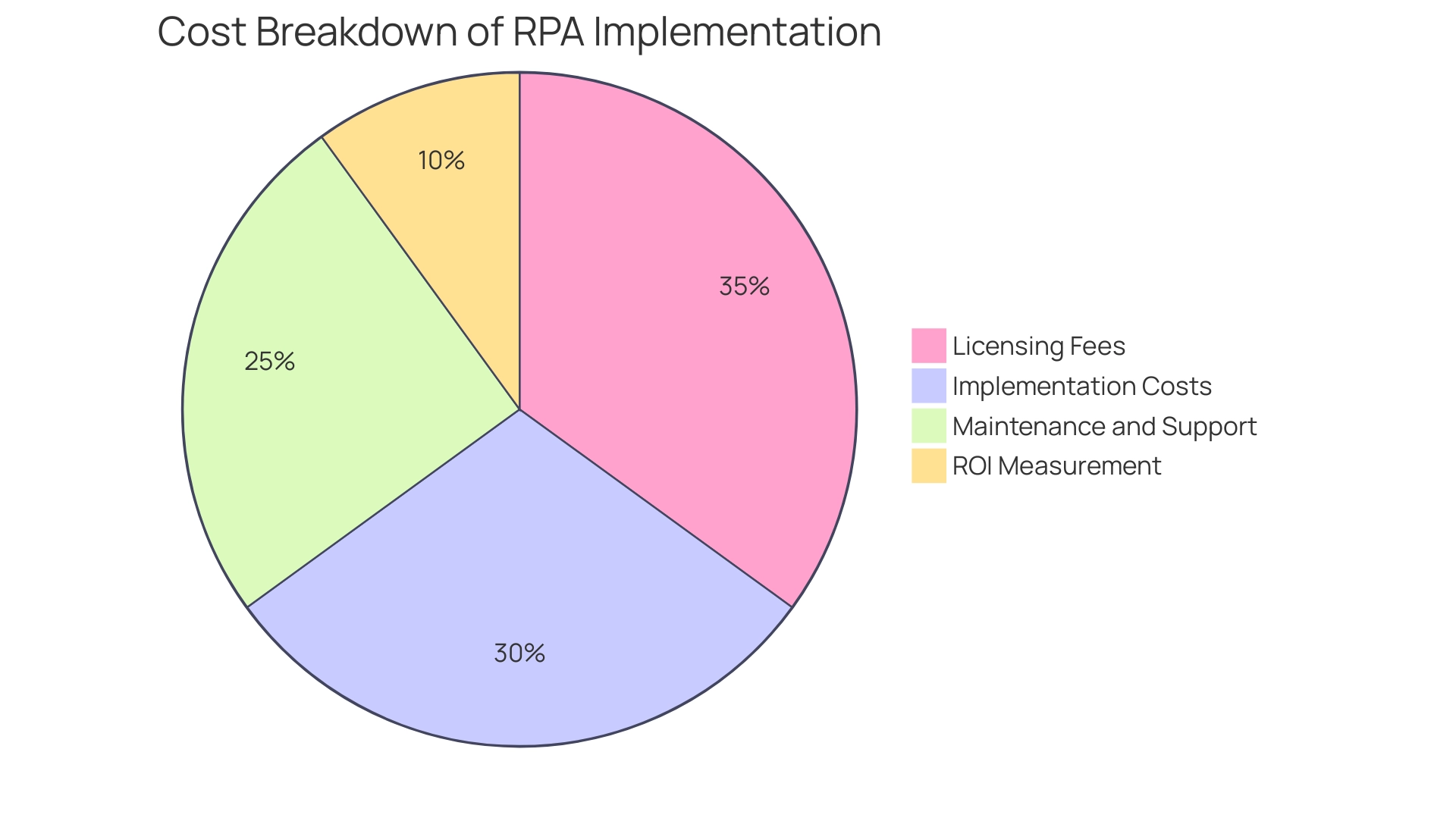
Future Trends in RPA and AI Integration
The landscape of Robotic Process Automation (RPA) is rapidly transforming, as highlighted by RPA vendors Gartner, fueled by technological advancements and the evolving needs of businesses. RPA can handle up to 90% of data entry tasks in clinical research, illustrating its practical impact on efficiency. However, companies often grapple with challenges such as poor master data quality, which can hinder effective AI implementation and lead to flawed decision-making.
Here are key future trends that leaders should prioritize to overcome these barriers:
- Increased AI Integration: The fusion of AI with RPA solutions will empower organizations to automate complex tasks and enhance decision-making processes. By addressing concerns about cost and complexity, this integration offers a pathway to improved business outcomes. On average, workers save 3.6 hours per week by utilizing technology, underscoring the quantifiable benefits of RPA and AI integration.
- Hyperautomation: This innovative approach leverages a multitude of technologies for streamlining processes, including RPA, AI, and machine learning, to formulate a holistic strategy. By addressing end-to-end business processes, hyperautomation can significantly streamline operations and improve efficiency.
- Focus on Citizen Development: The rise of low-code and no-code platforms is revolutionizing how organizations empower their workforce. By allowing non-technical staff to create their own solutions, businesses can encourage innovation and speed up implementation cycles, resulting in quick responses to market demands.
- Enhanced Security Measures: As automation becomes more prevalent, safeguarding sensitive data is paramount. Vendors are prioritizing robust security features to ensure compliance with regulations and protect organizational integrity in an automated environment.
Additionally, entities must acknowledge that AI projects can often be perceived as time-intensive, costly, and challenging to implement. Addressing these perceptions is crucial for successful adoption. Tailored AI solutions can assist entities in navigating these complexities effectively.
As Tajammul Pangarkar, CMO at Prudour Pvt Ltd, notes, “When he’s not ruminating about various happenings in the tech world, he can usually be found indulging in his next favorite interest – table tennis.” By staying informed of these trends, organizations can strategically leverage the evolving capabilities of RPA and AI, as recommended by RPA vendors Gartner, ensuring a competitive edge in their industries.
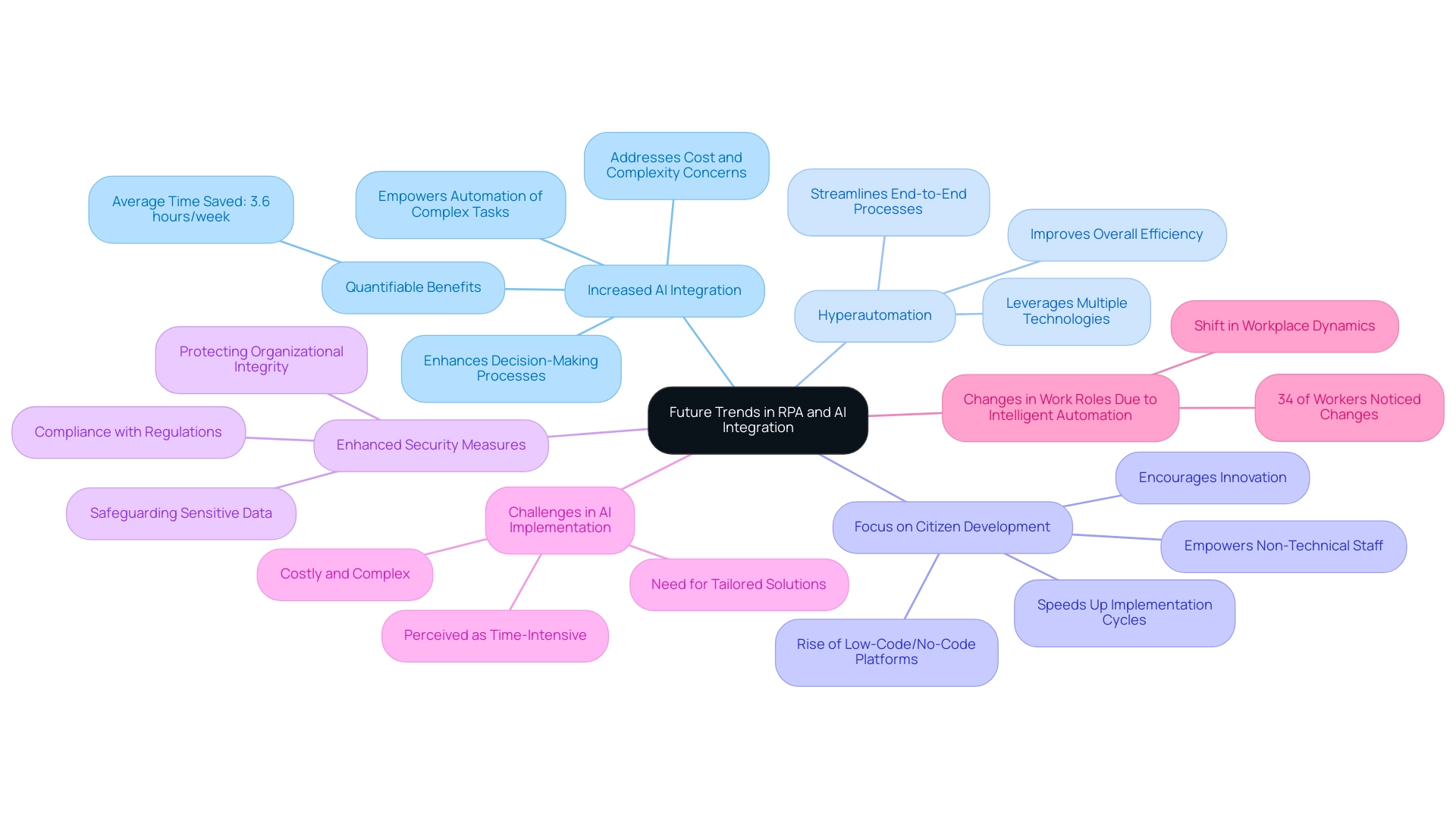
Conclusion
The integration of Robotic Process Automation (RPA) is undeniably reshaping the operational landscape for businesses seeking enhanced efficiency. By examining the leading vendors highlighted in Gartner’s 2024 Magic Quadrant, such as Automation Anywhere, Microsoft, and UiPath, organizations can identify unique solutions tailored to their specific needs. These tools not only streamline workflows but also significantly reduce errors, as evidenced by case studies showcasing remarkable improvements in operational metrics.
As AI continues to evolve, its role within RPA becomes increasingly pivotal, enabling organizations to harness advanced capabilities such as cognitive automation and predictive analytics. This synergy not only enhances decision-making but also empowers businesses to respond swiftly to changing demands, ultimately fostering a culture of innovation and agility. The emphasis on user-friendly interfaces, scalability, and robust support further underscores the importance of selecting the right RPA vendor to maximize investment and drive success.
Looking ahead, the trends of hyperautomation and citizen development will likely dominate the RPA landscape, offering organizations new avenues to streamline processes and empower their workforce. By prioritizing these advancements and addressing the associated cost considerations, Directors of Operations Efficiency can position their organizations for sustained success in an increasingly automated world. Embracing RPA is not merely a response to current challenges; it is a strategic investment in the future, paving the way for operational excellence and competitive advantage.
